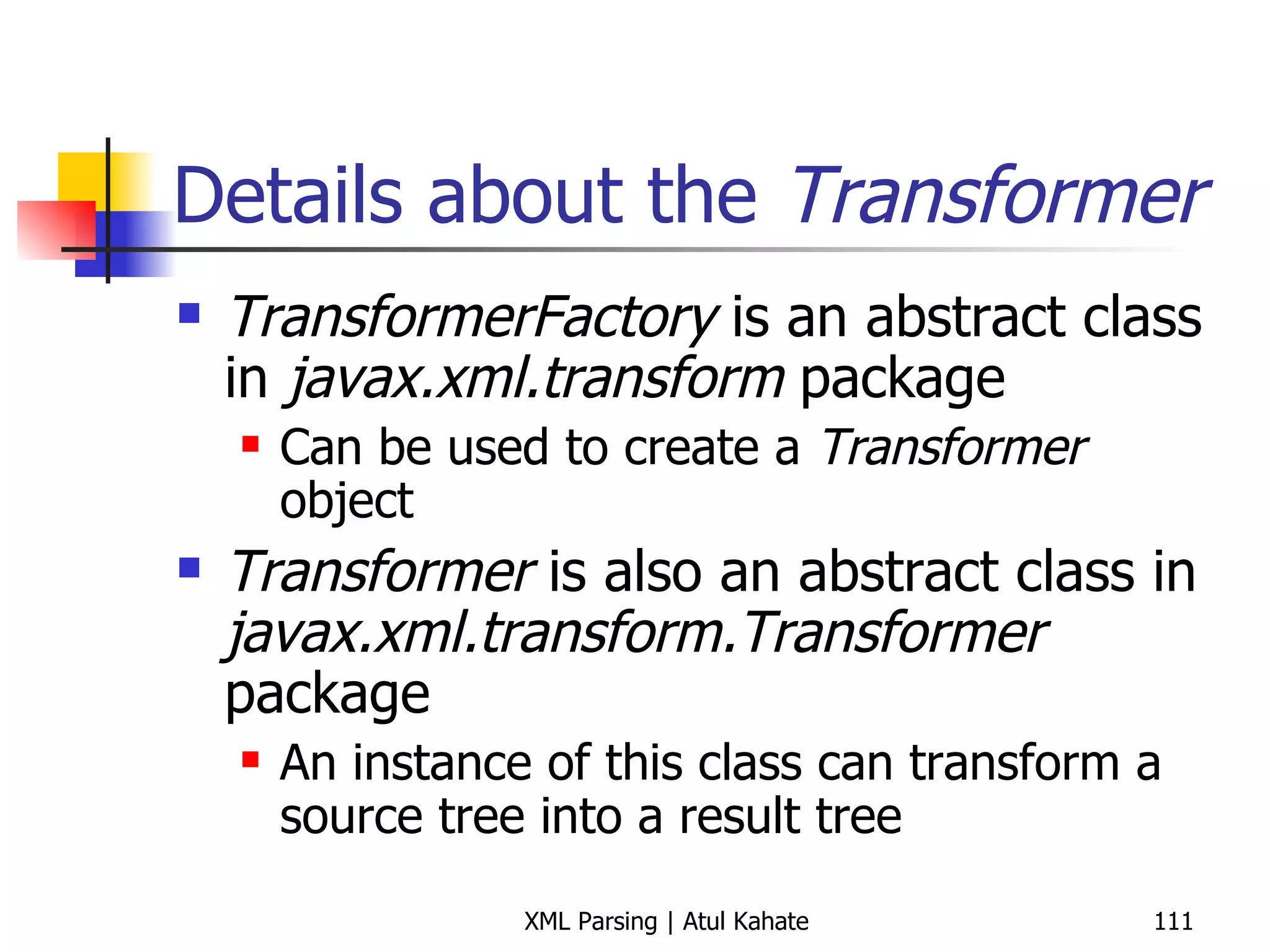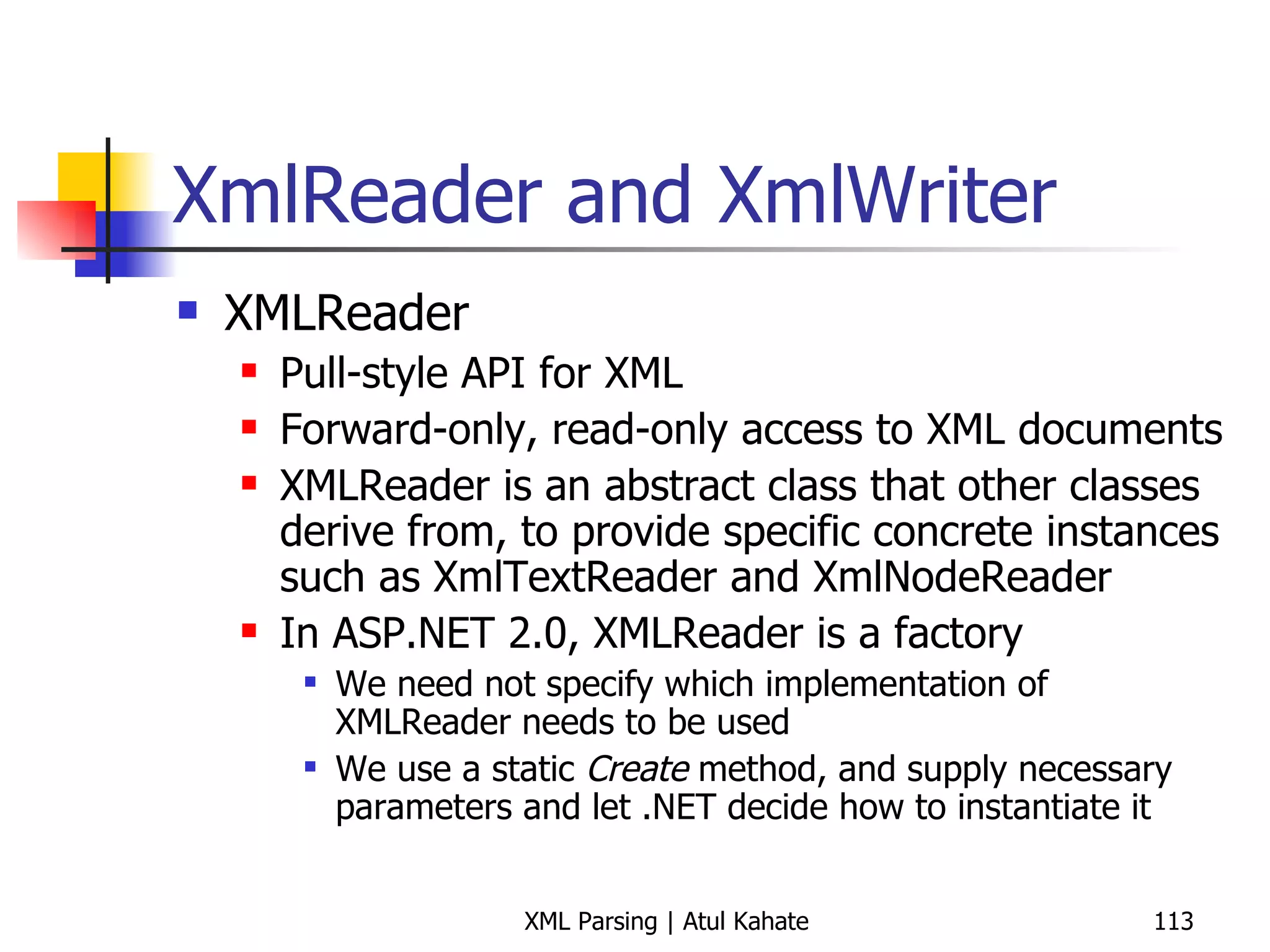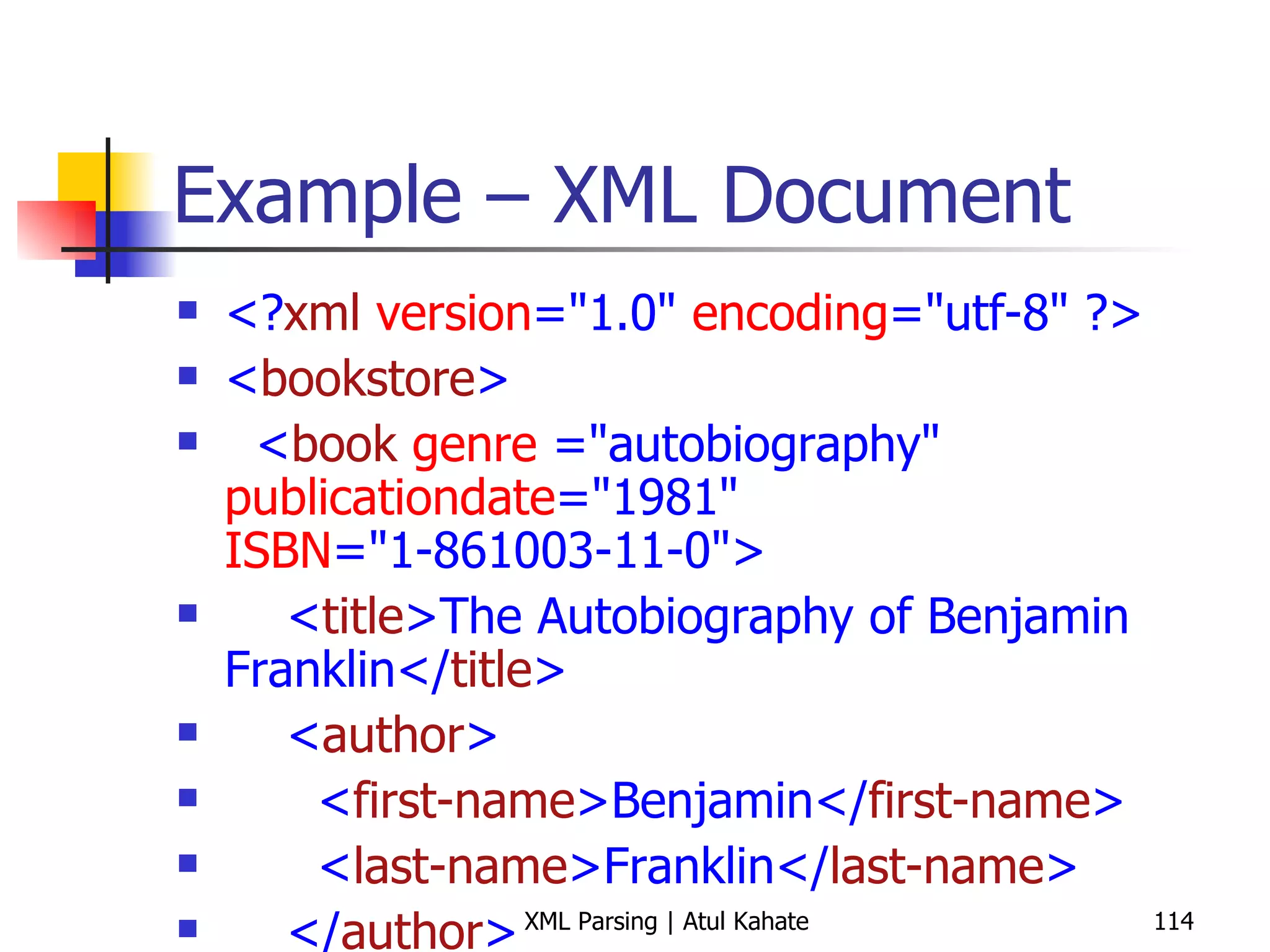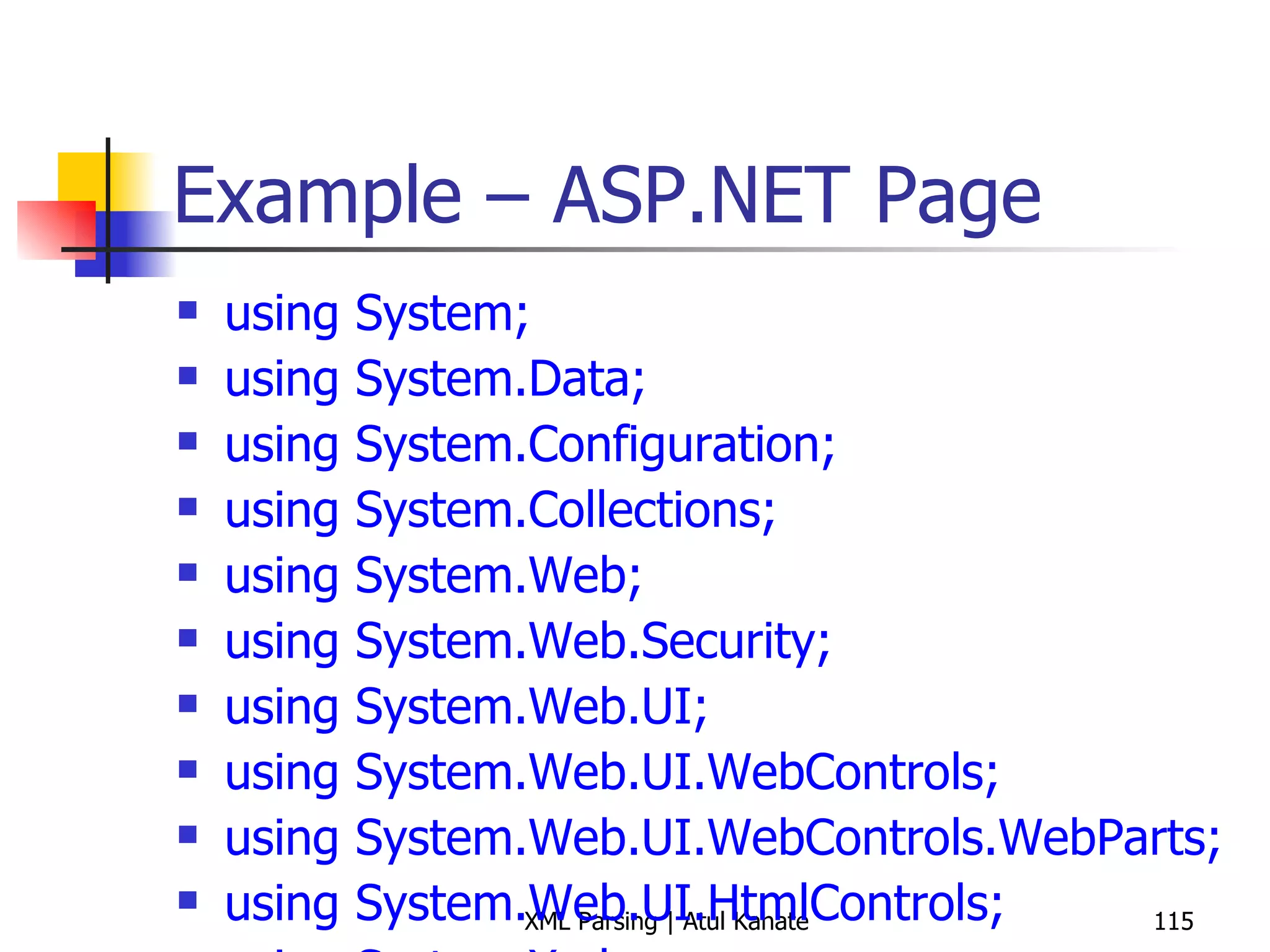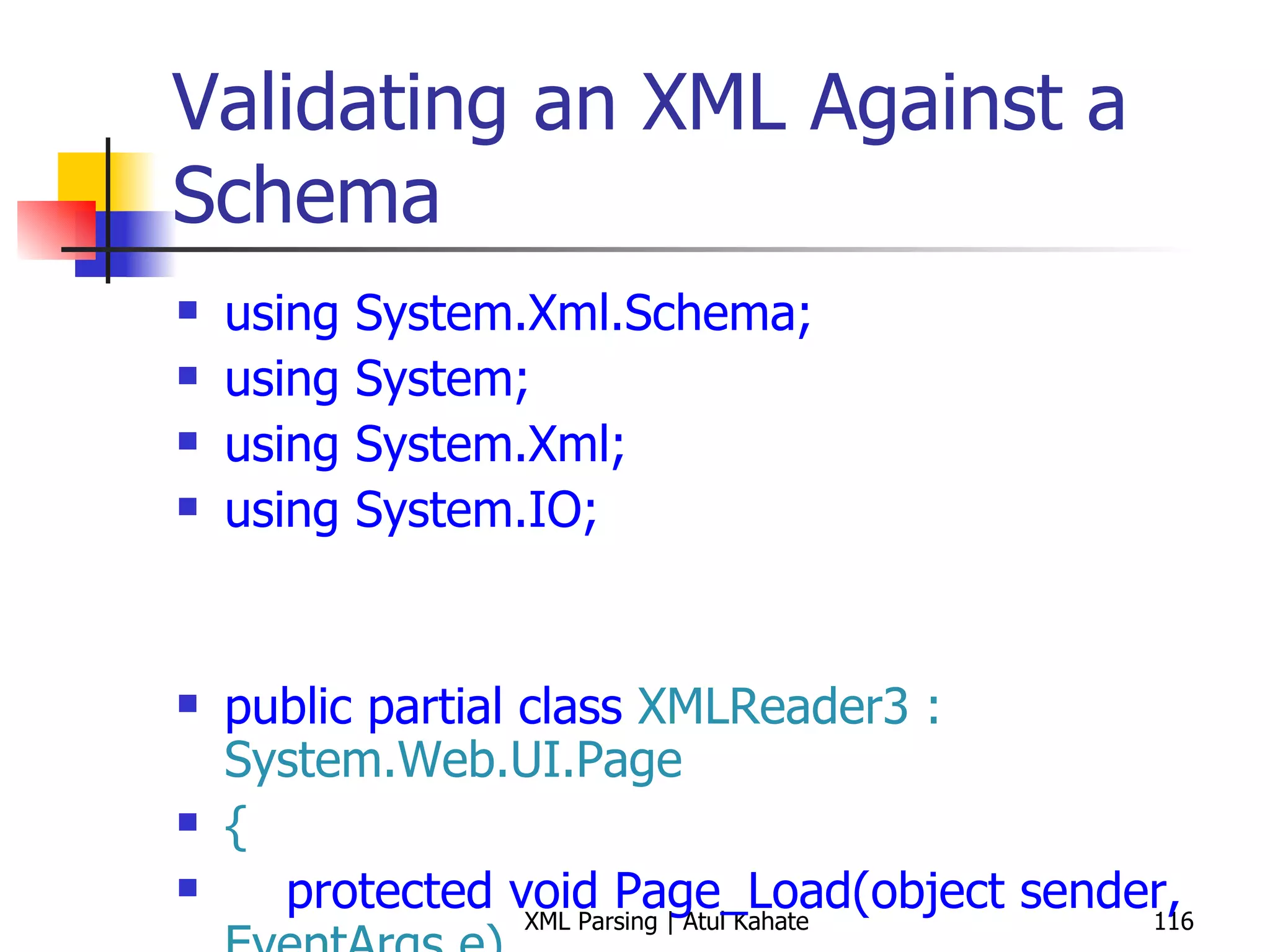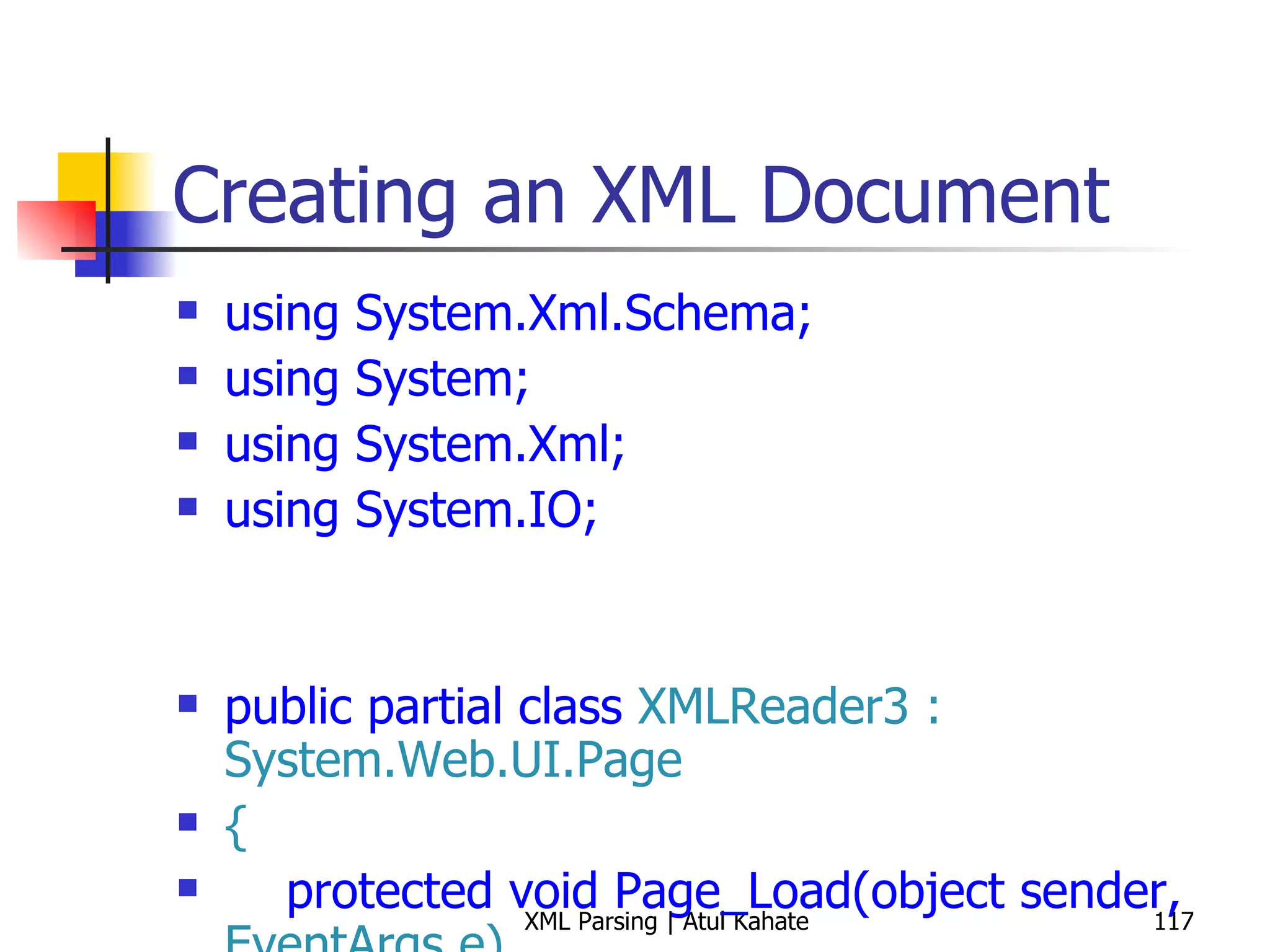The document discusses XML parsing and processing. It describes two main approaches:
1) Simple API for XML (SAX) - Parses XML as a sequence of events by using event handlers for start/end tags. This is faster but requires processing elements sequentially.
2) Document Object Model (DOM) - Parses XML into a tree structure of nodes that can be randomly accessed. This allows non-sequential access but uses more memory.
It also discusses the Java API for XML Processing (JAXP) which provides a standardized way to access SAX and DOM parsers from Java code.
![XML Parsing Atul Kahate [email_address]](https://image.slidesharecdn.com/6-xmlparsing-111212100111-phpapp02/75/6-xml-parsing-1-2048.jpg)
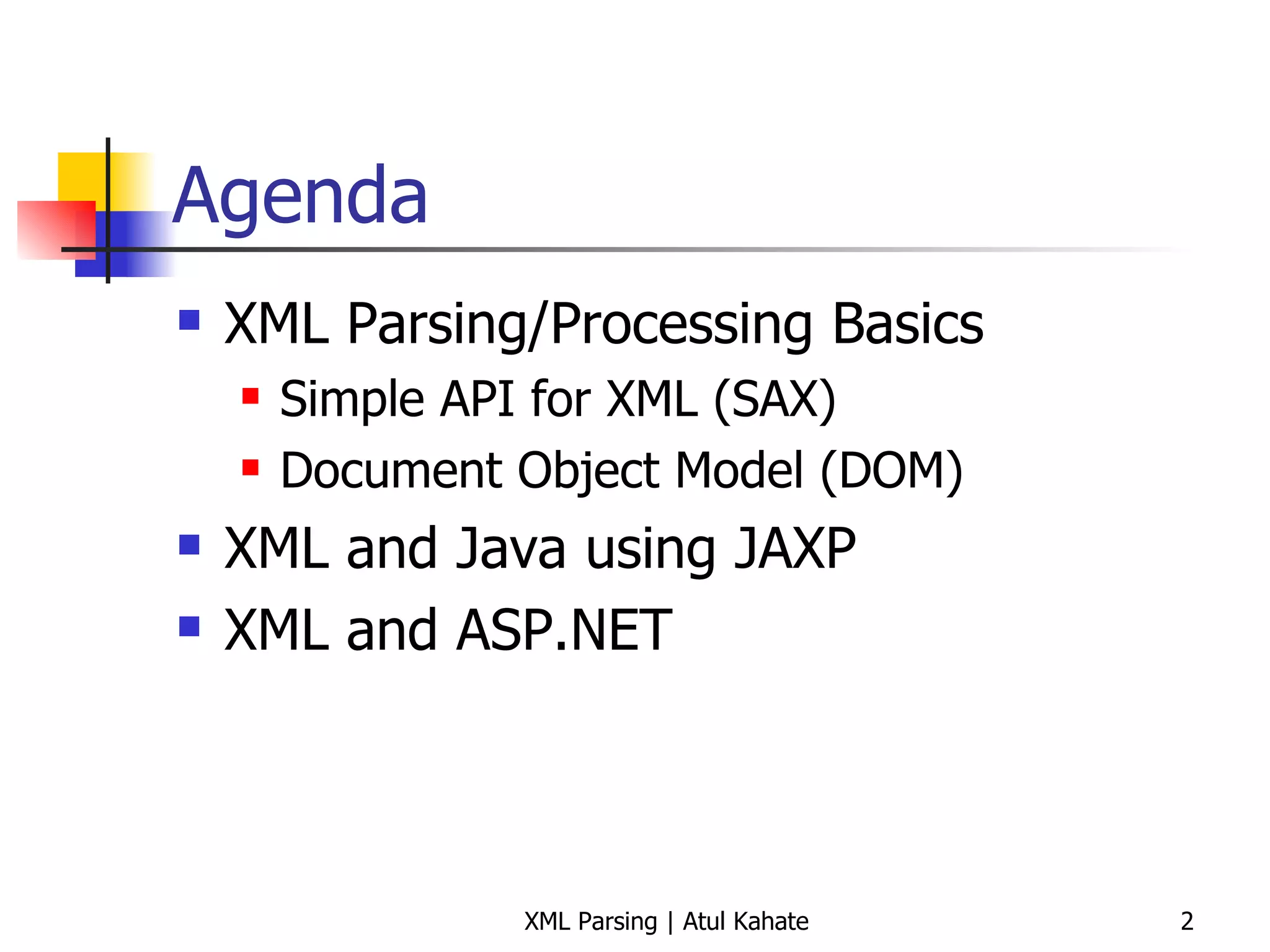
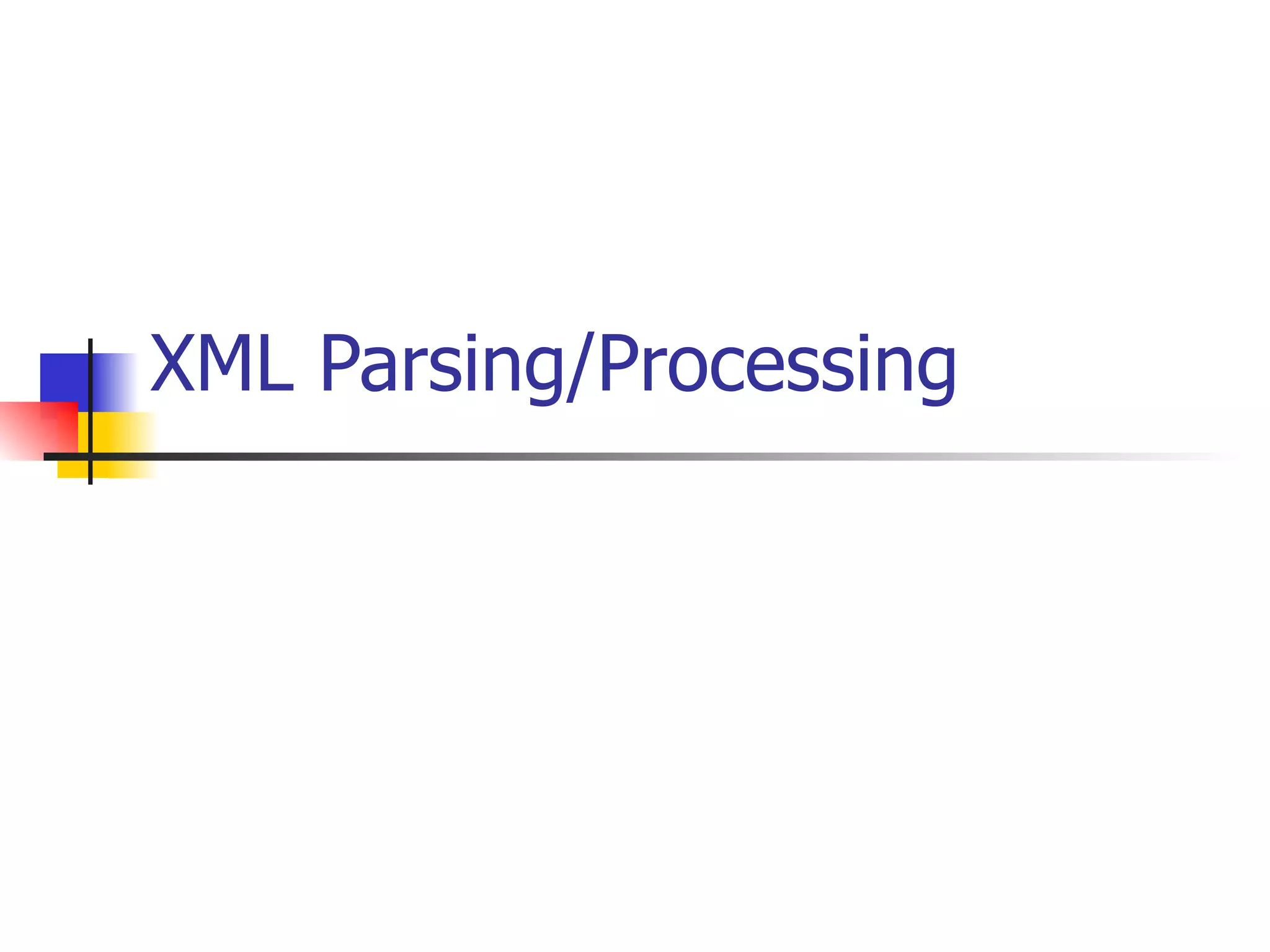
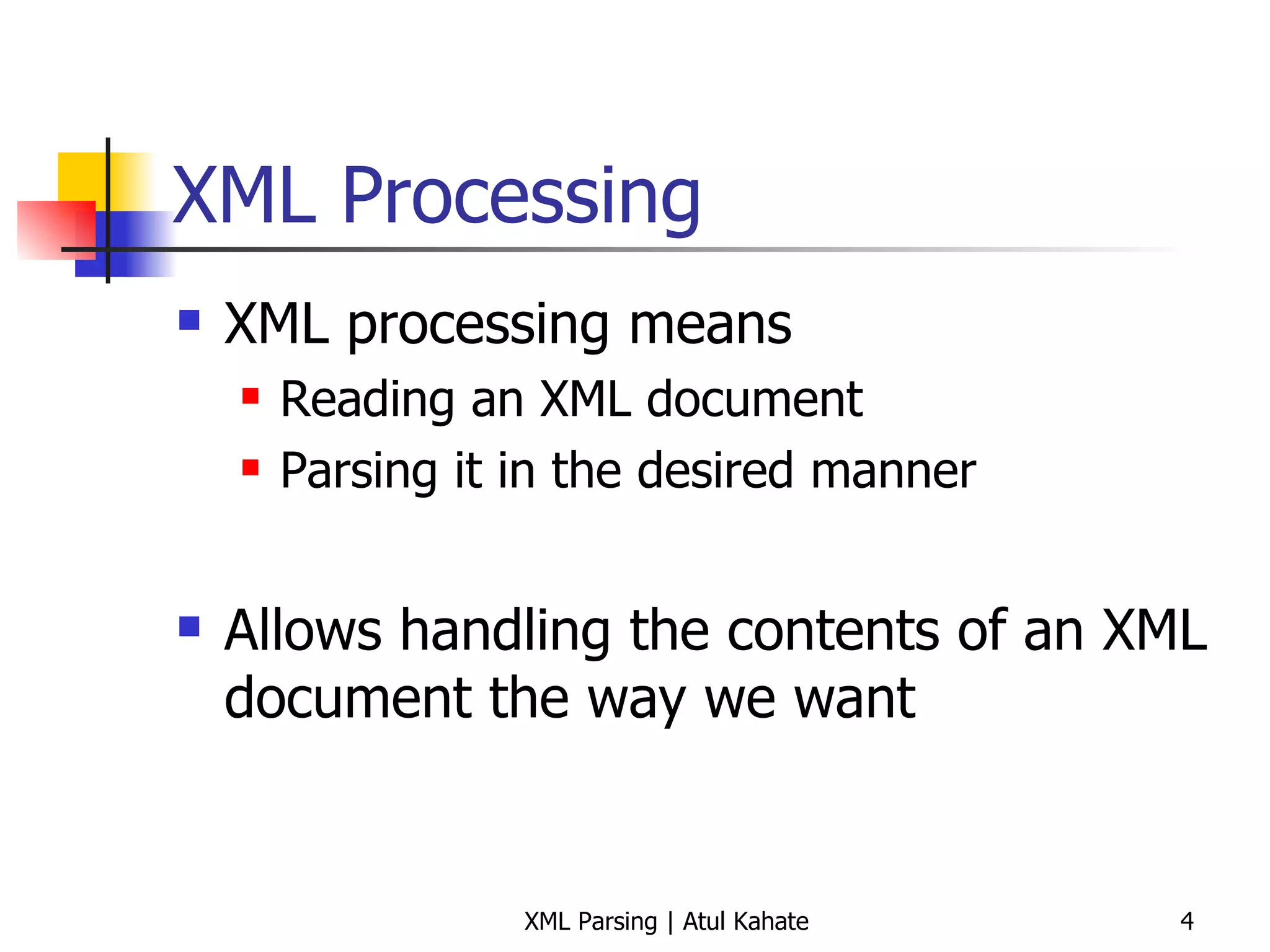
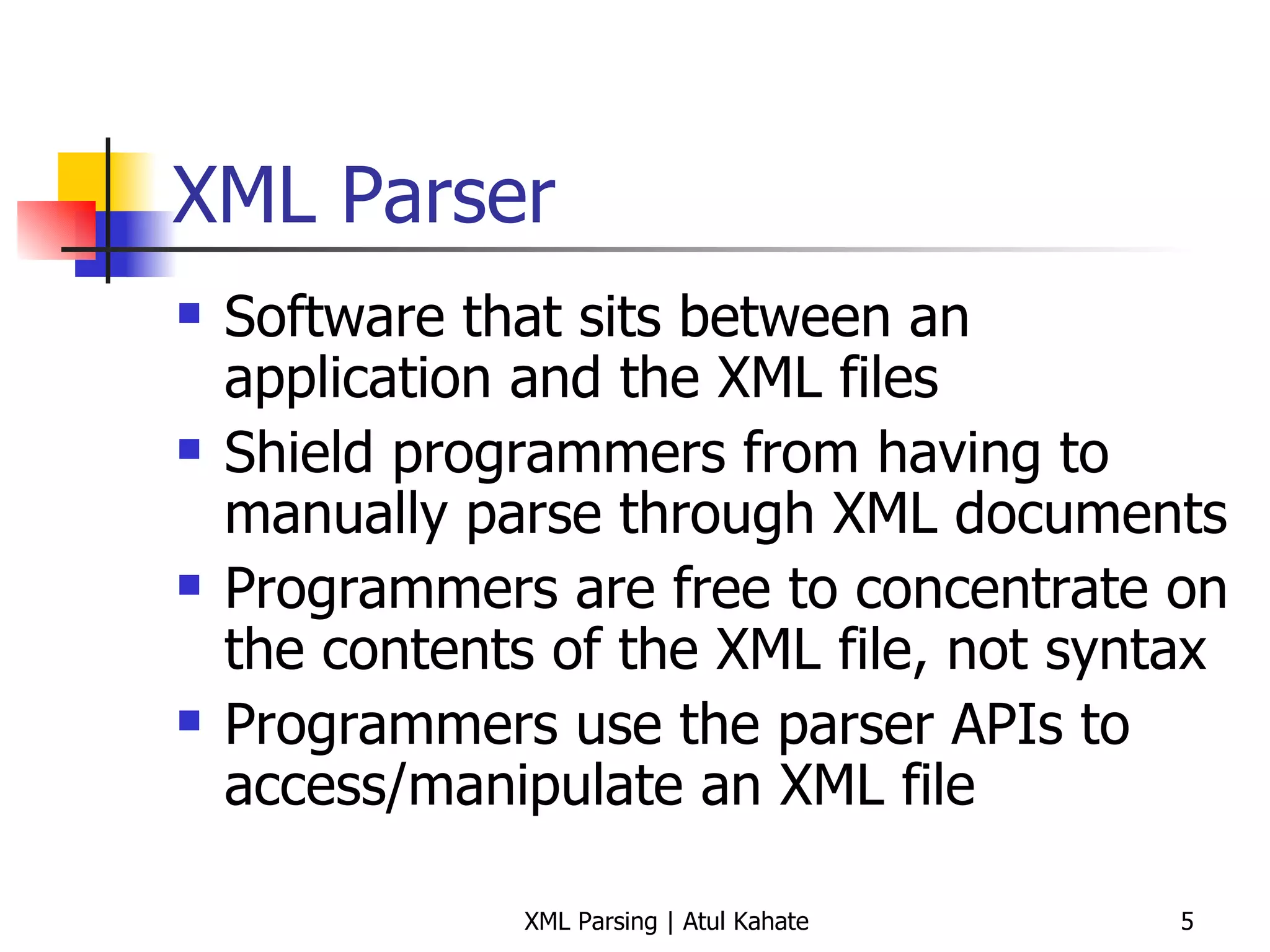
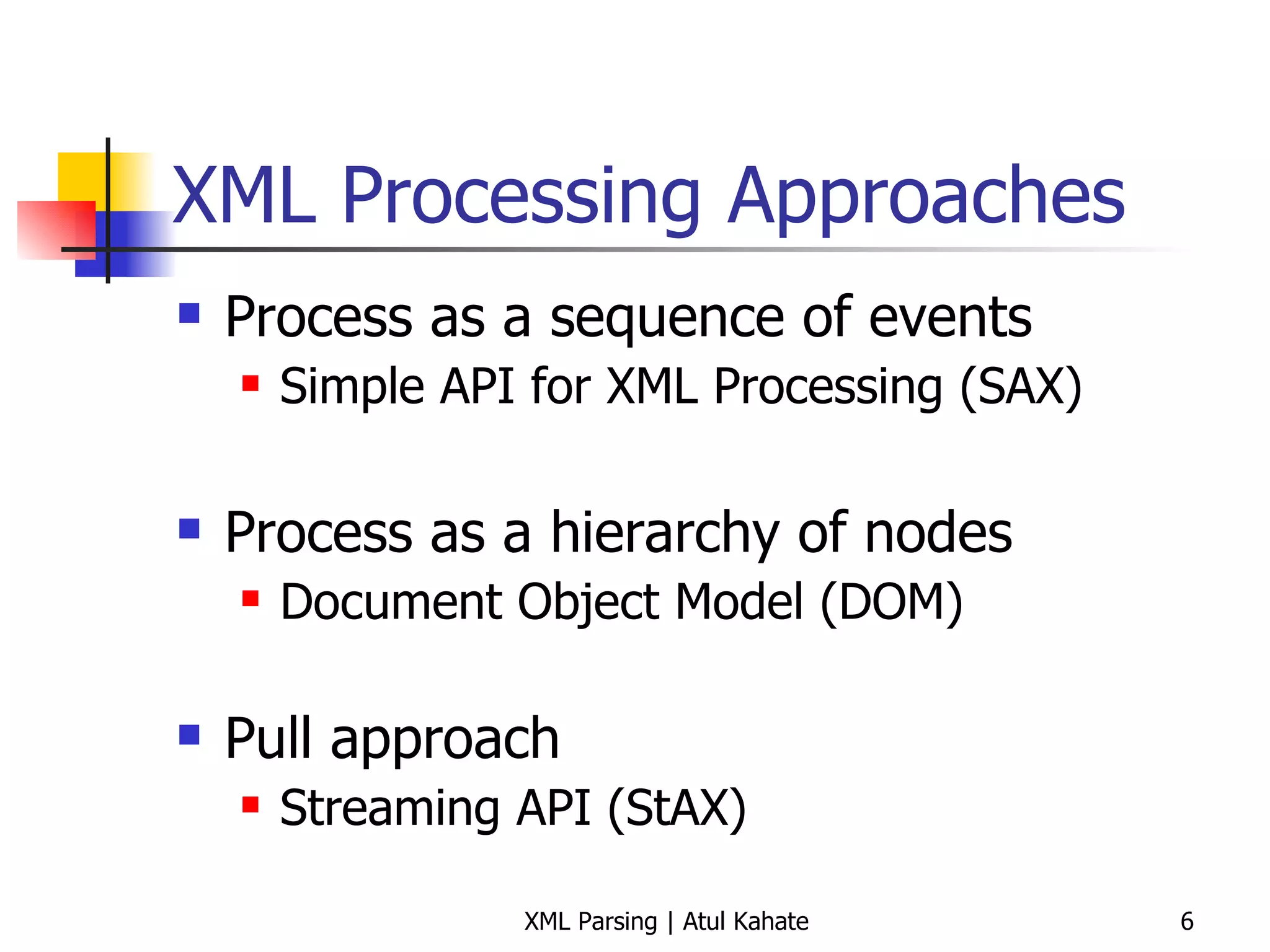
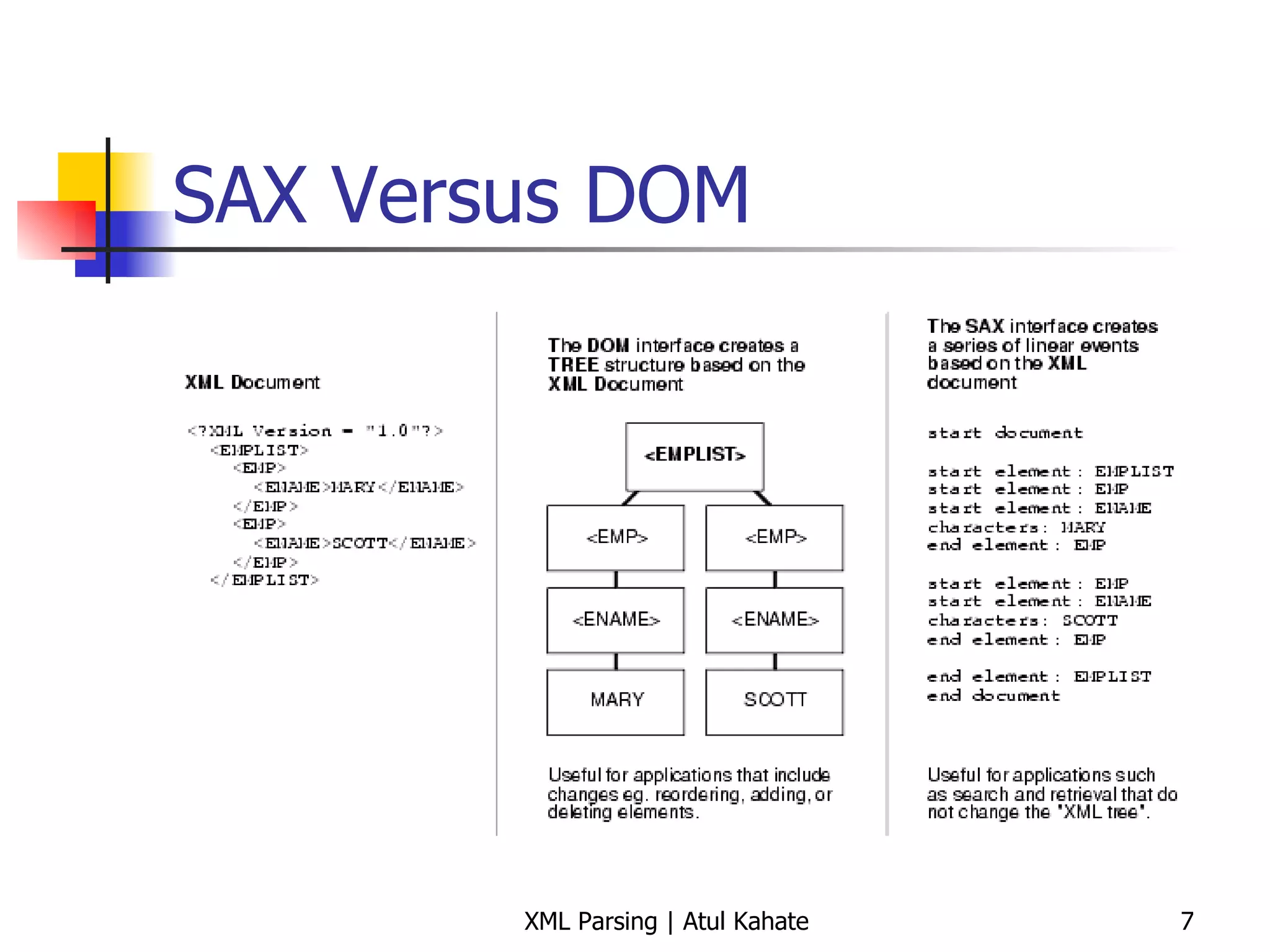
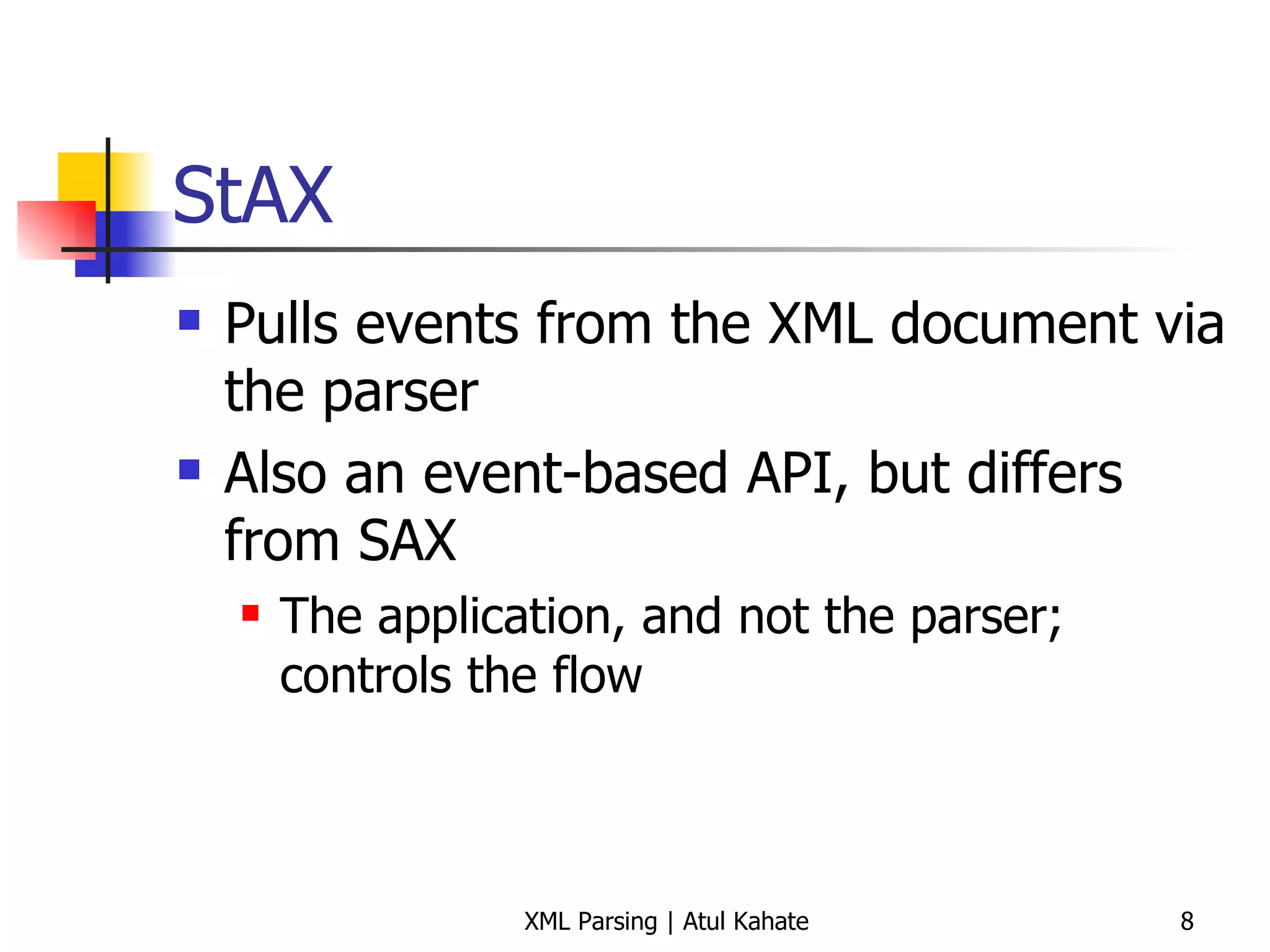
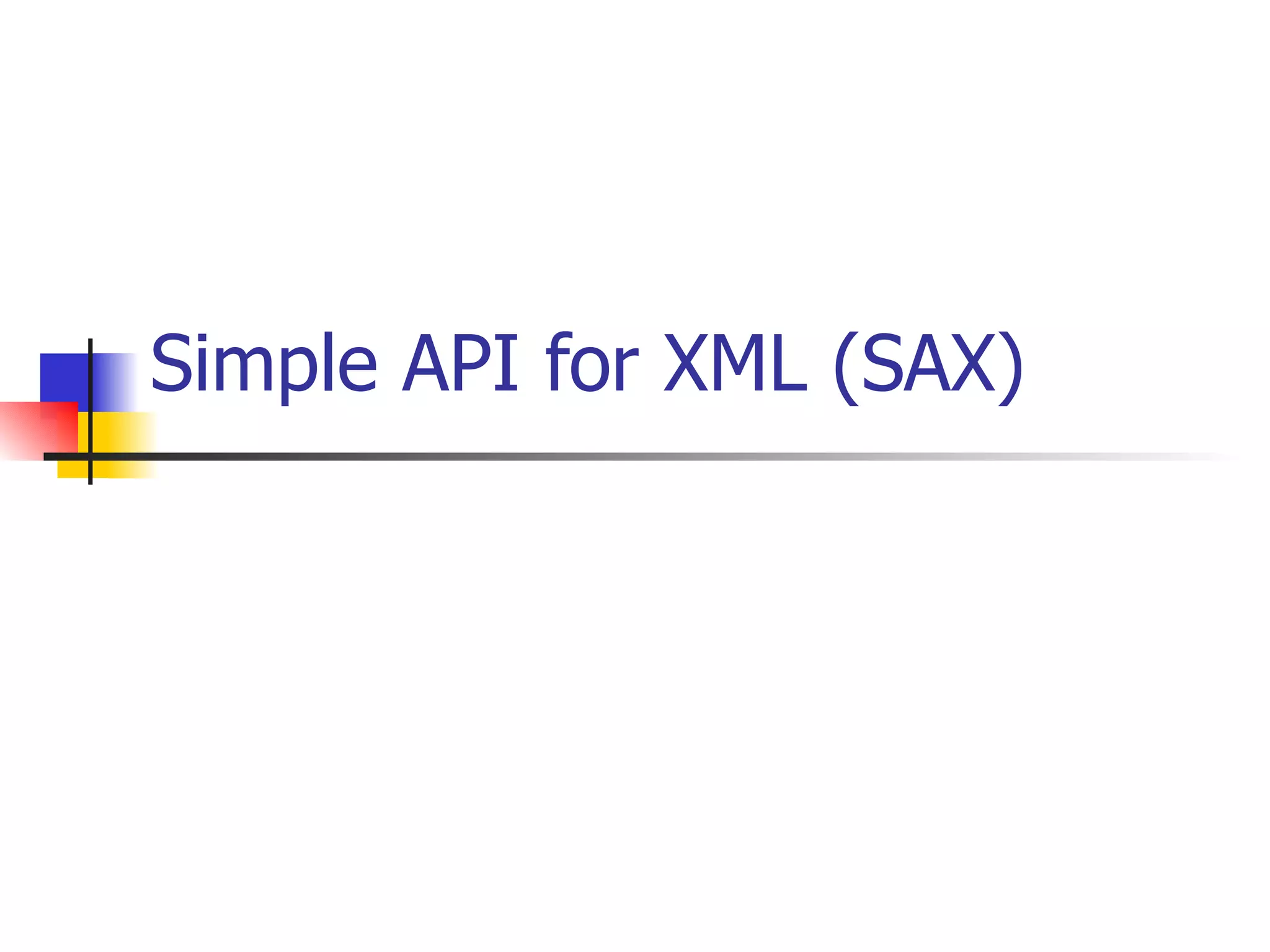
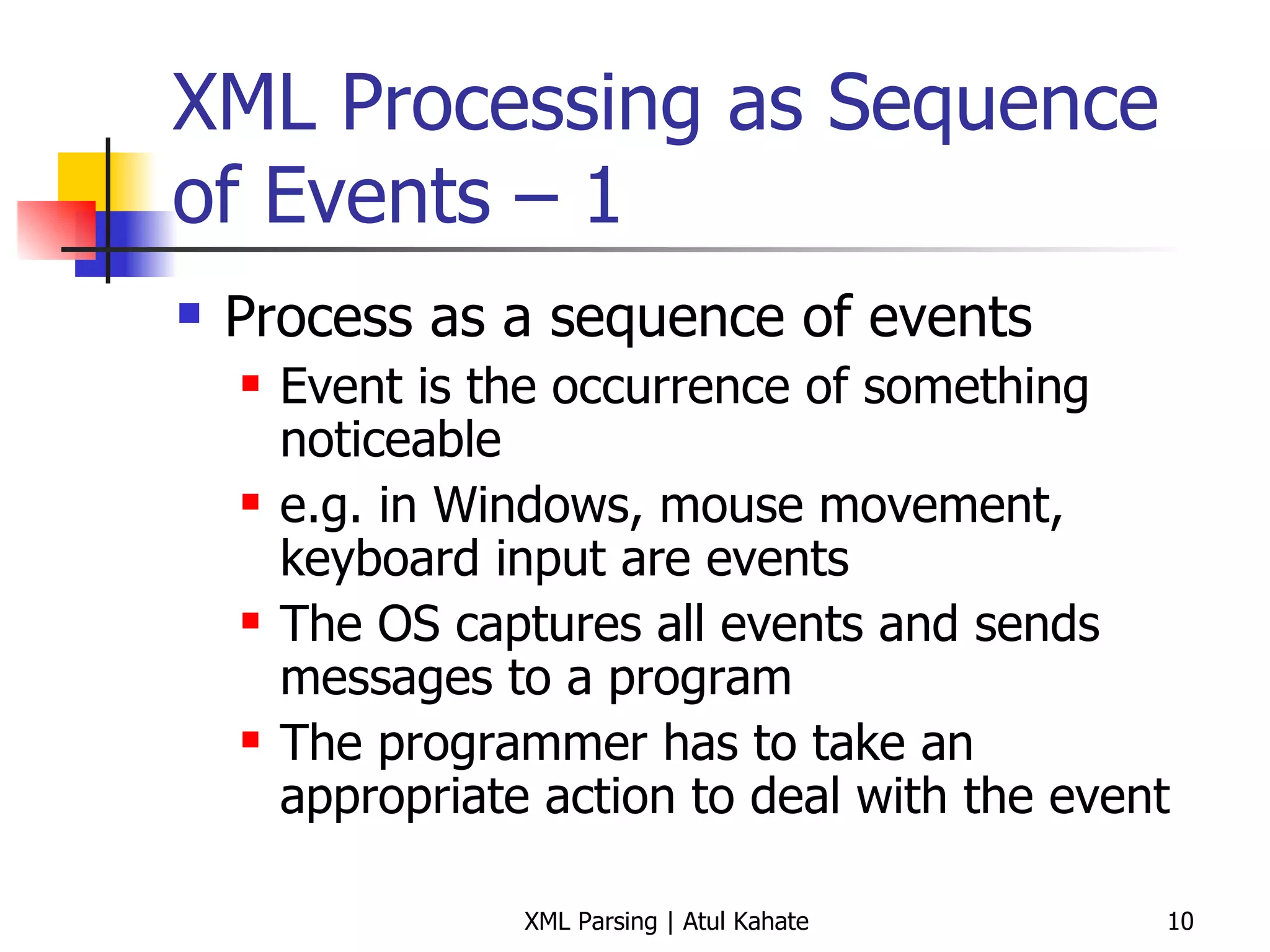
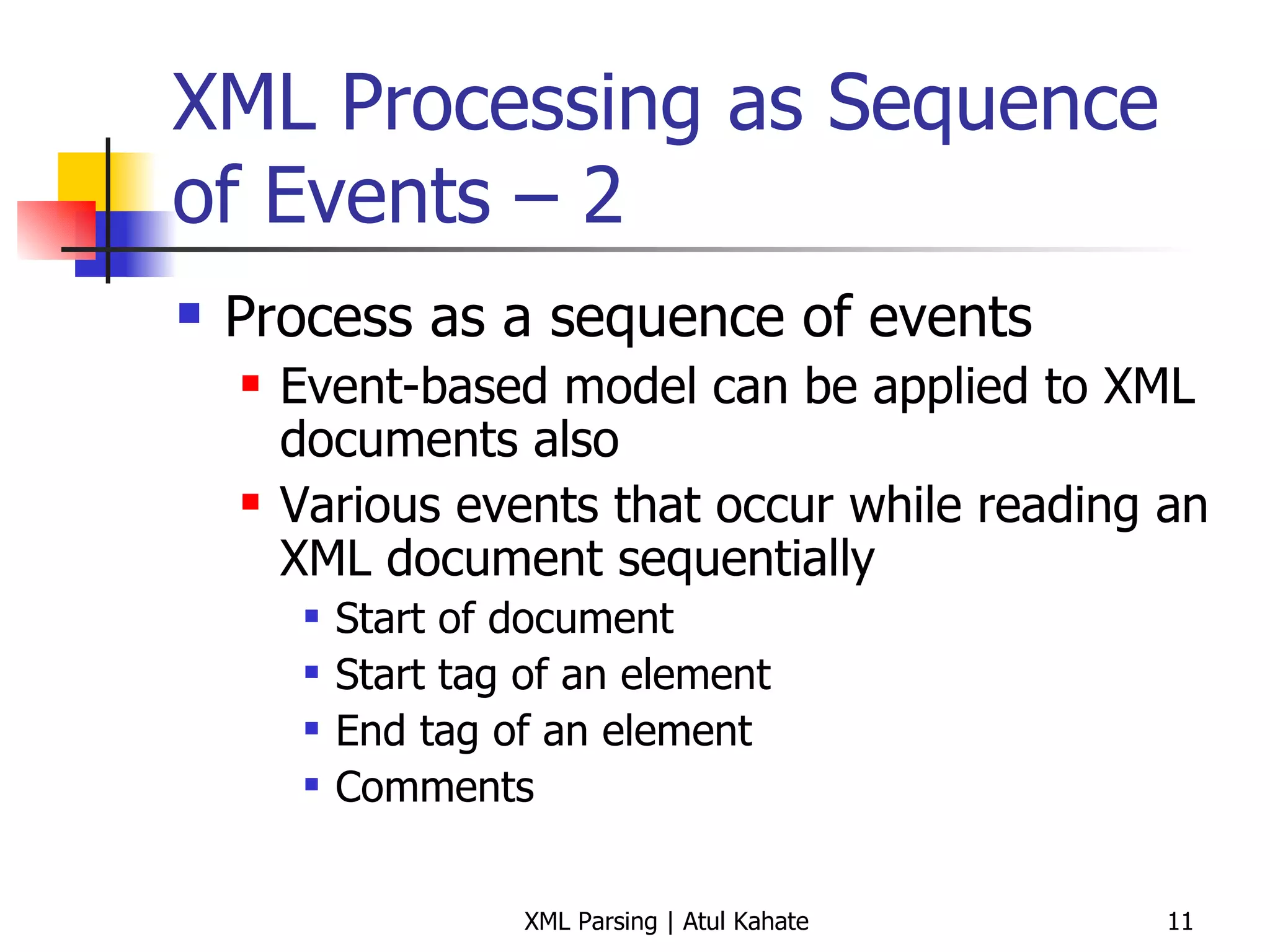
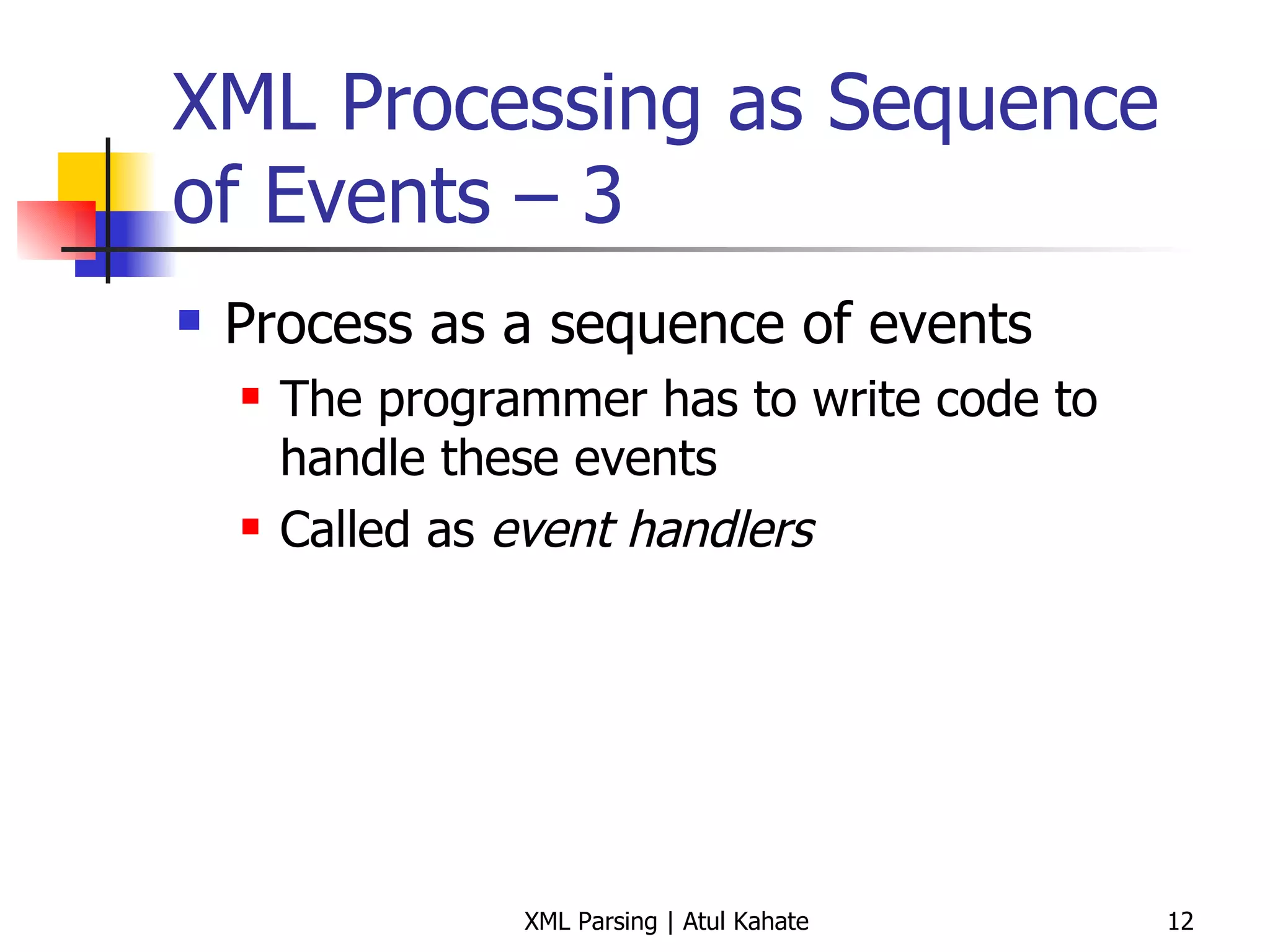
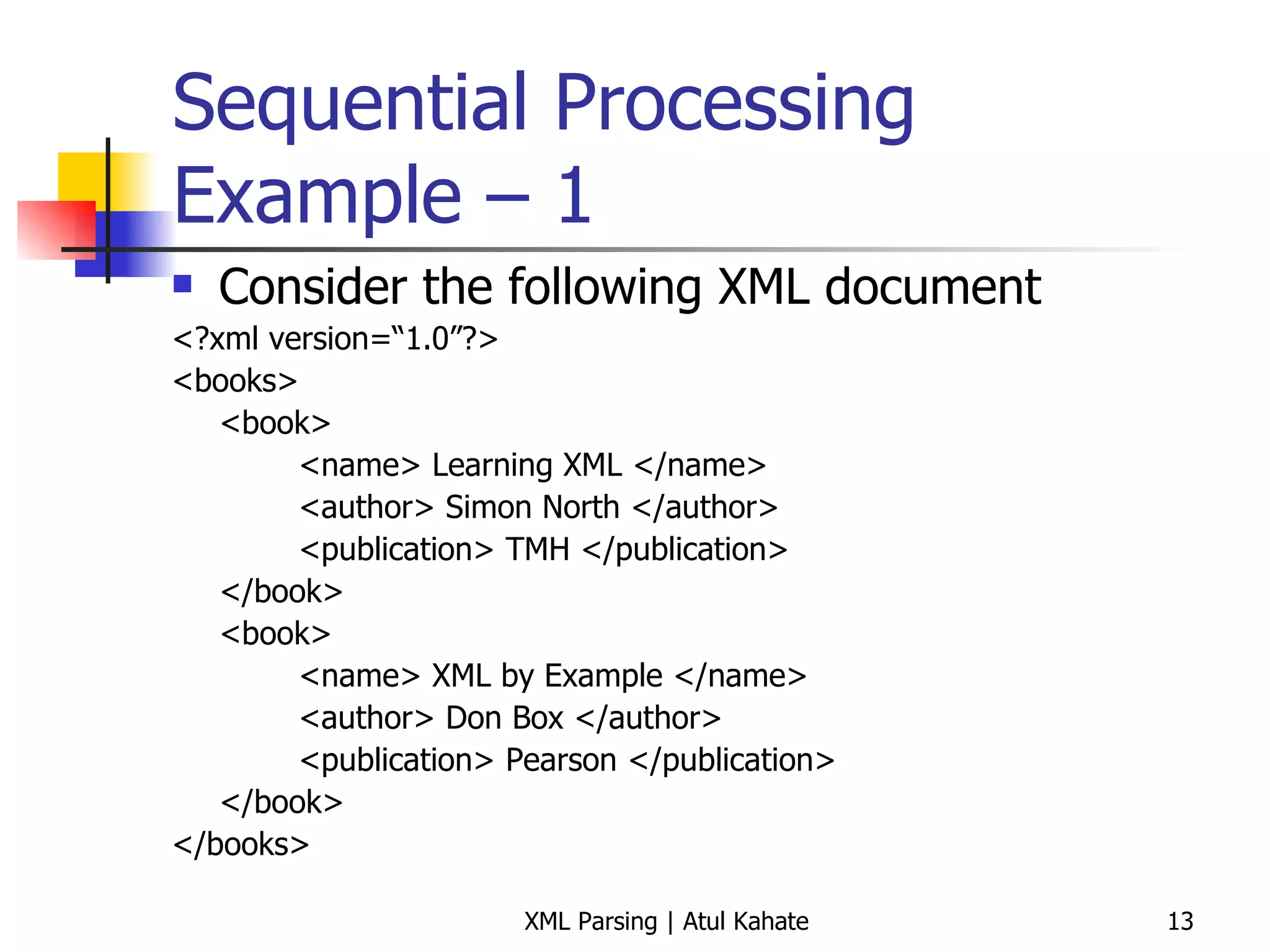
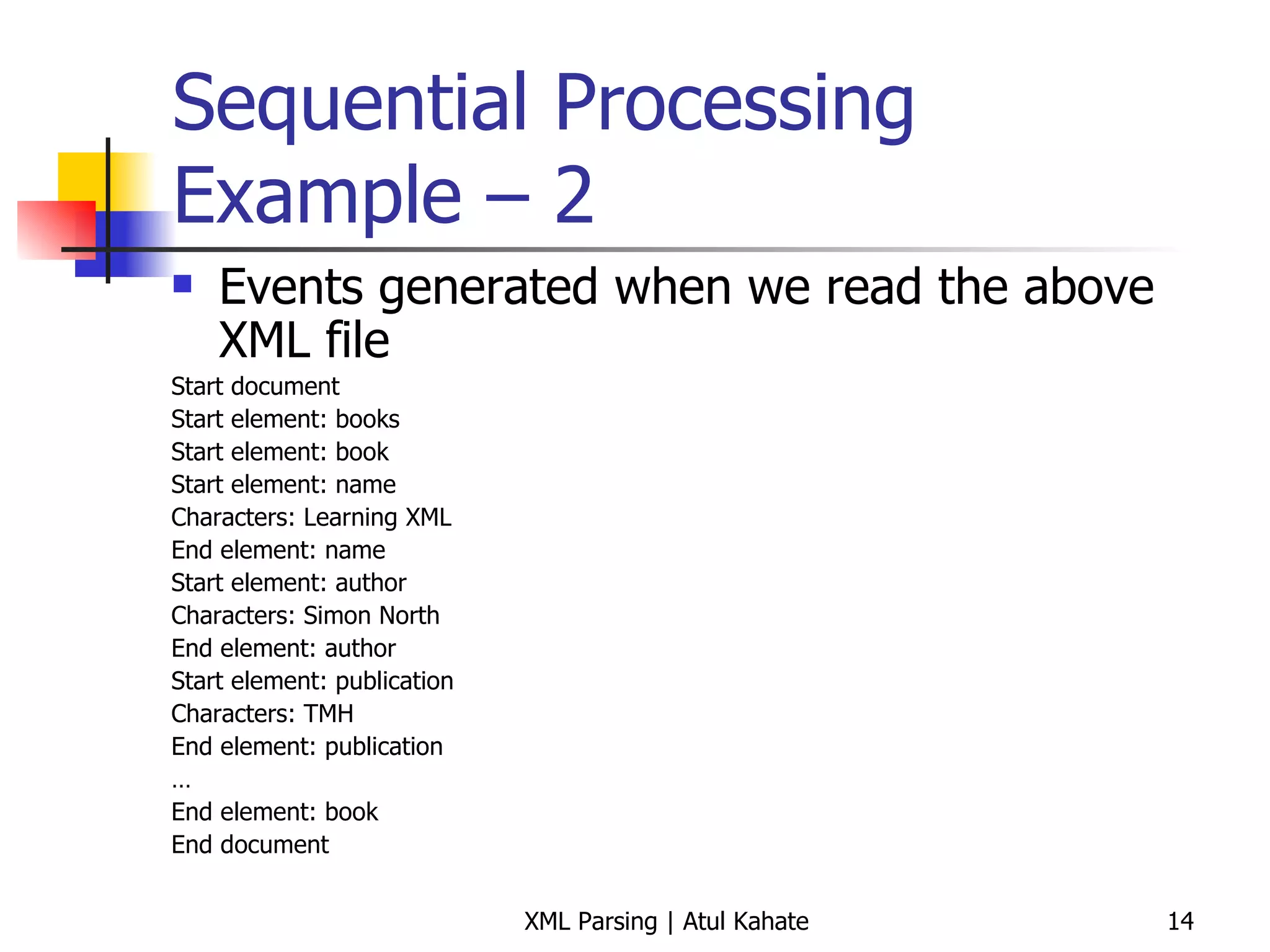
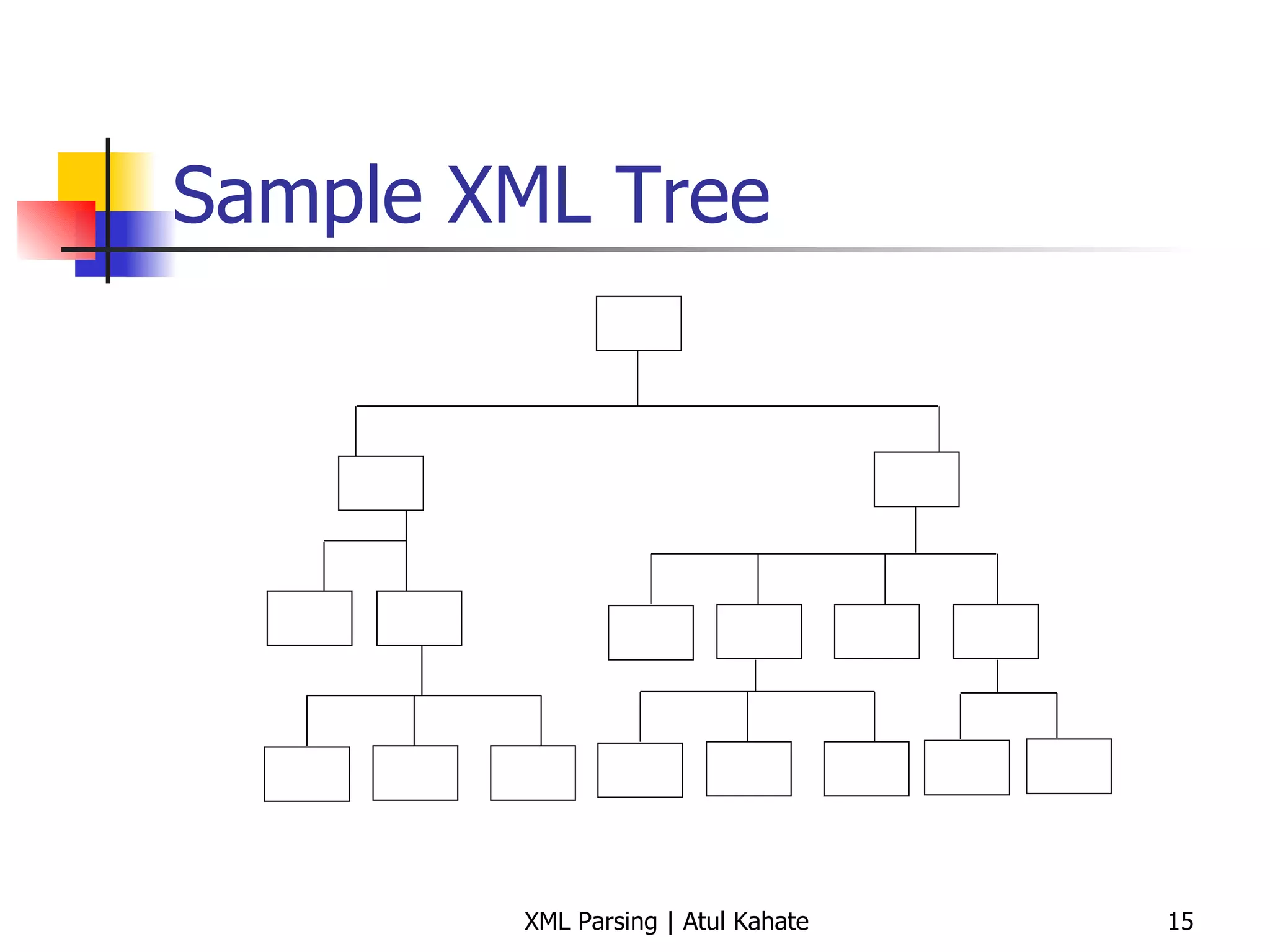
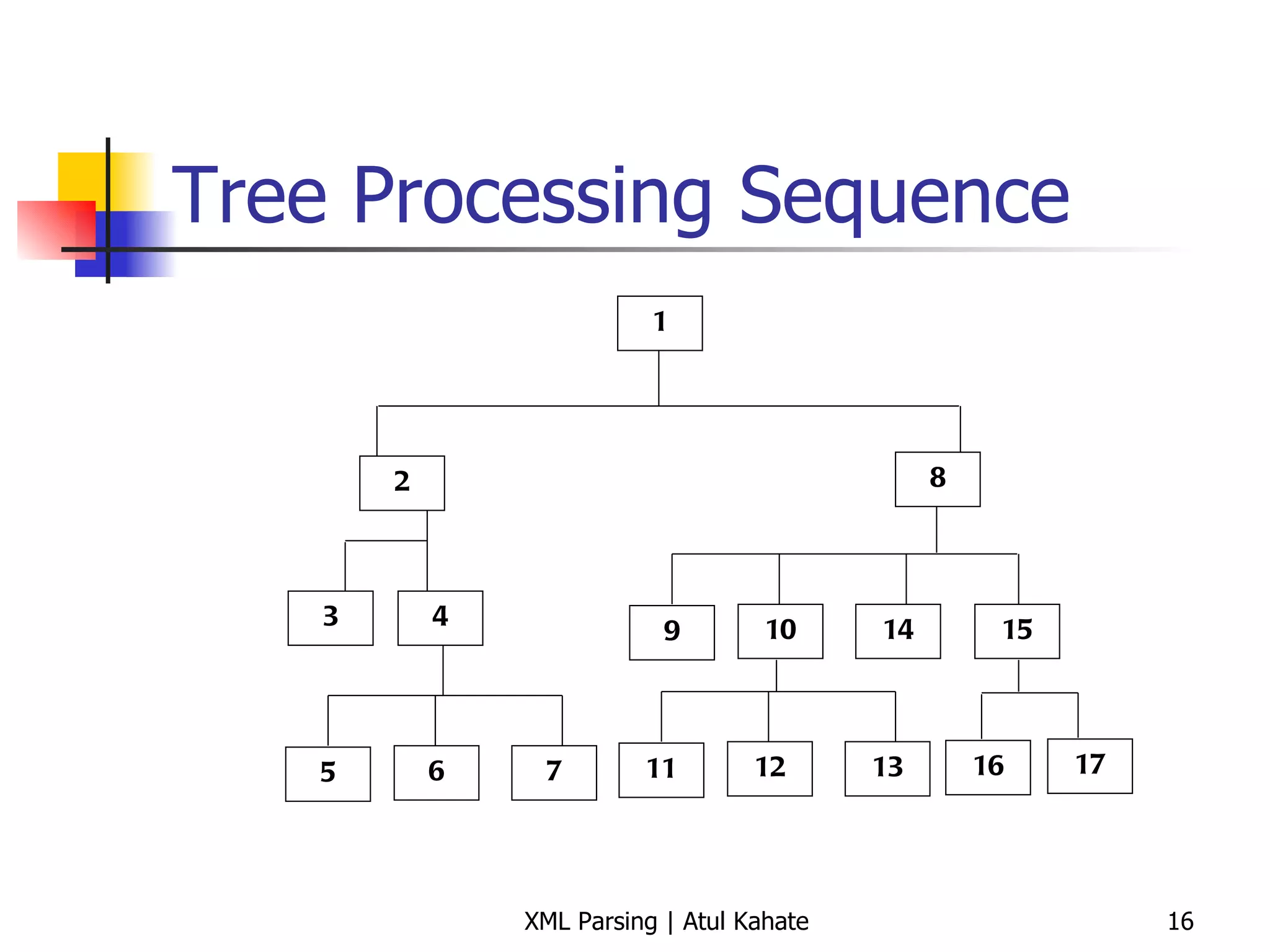
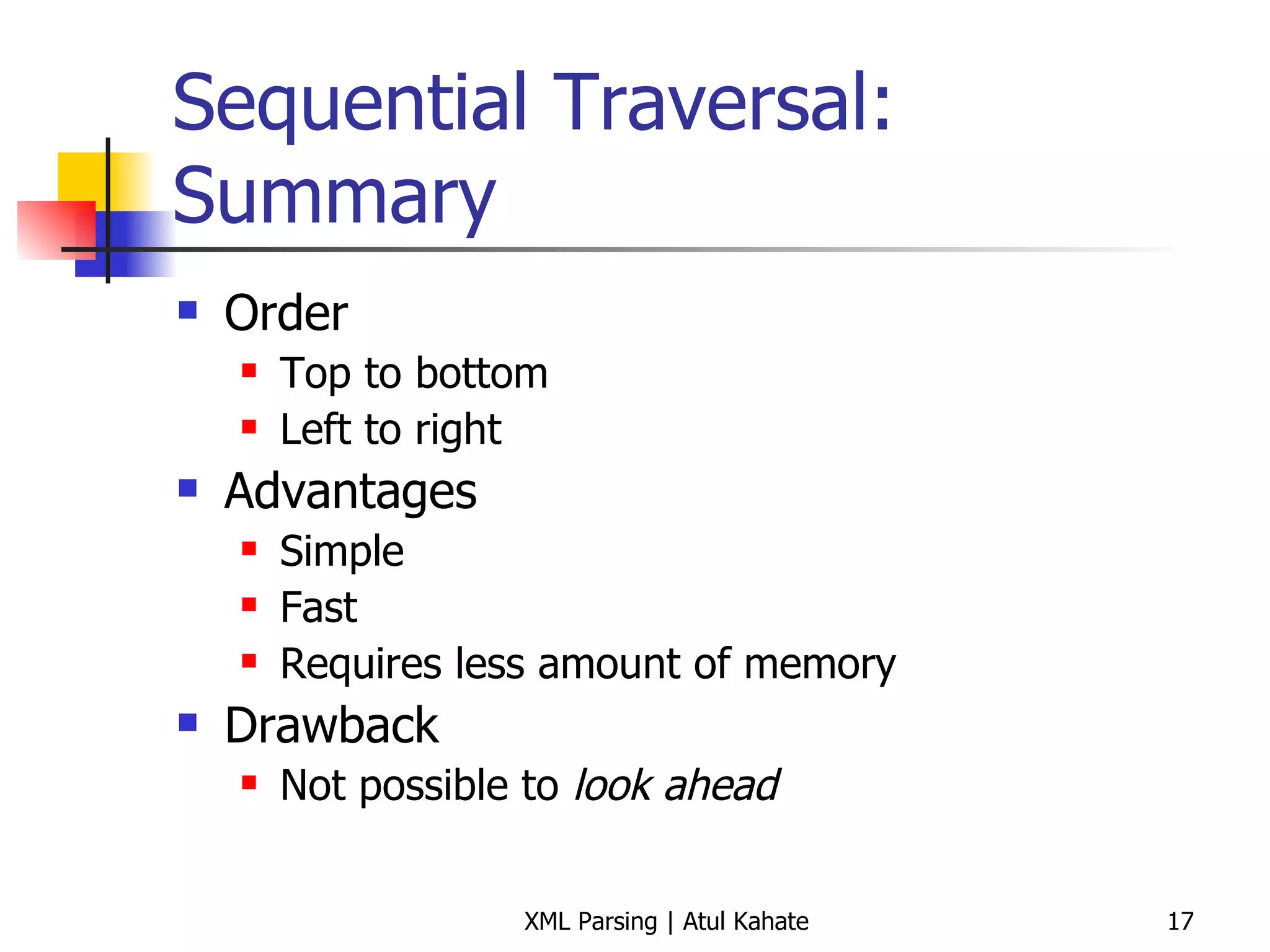
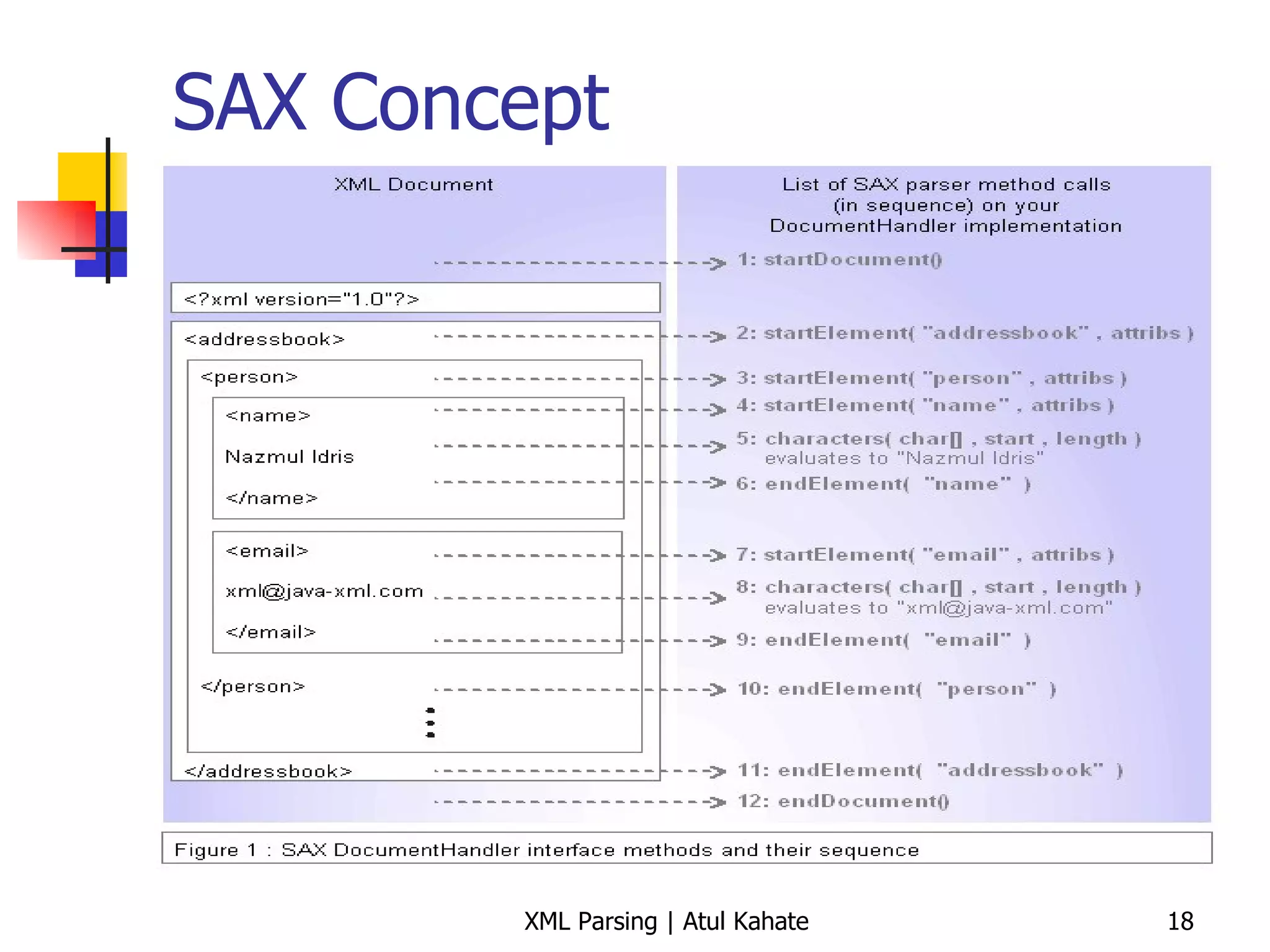
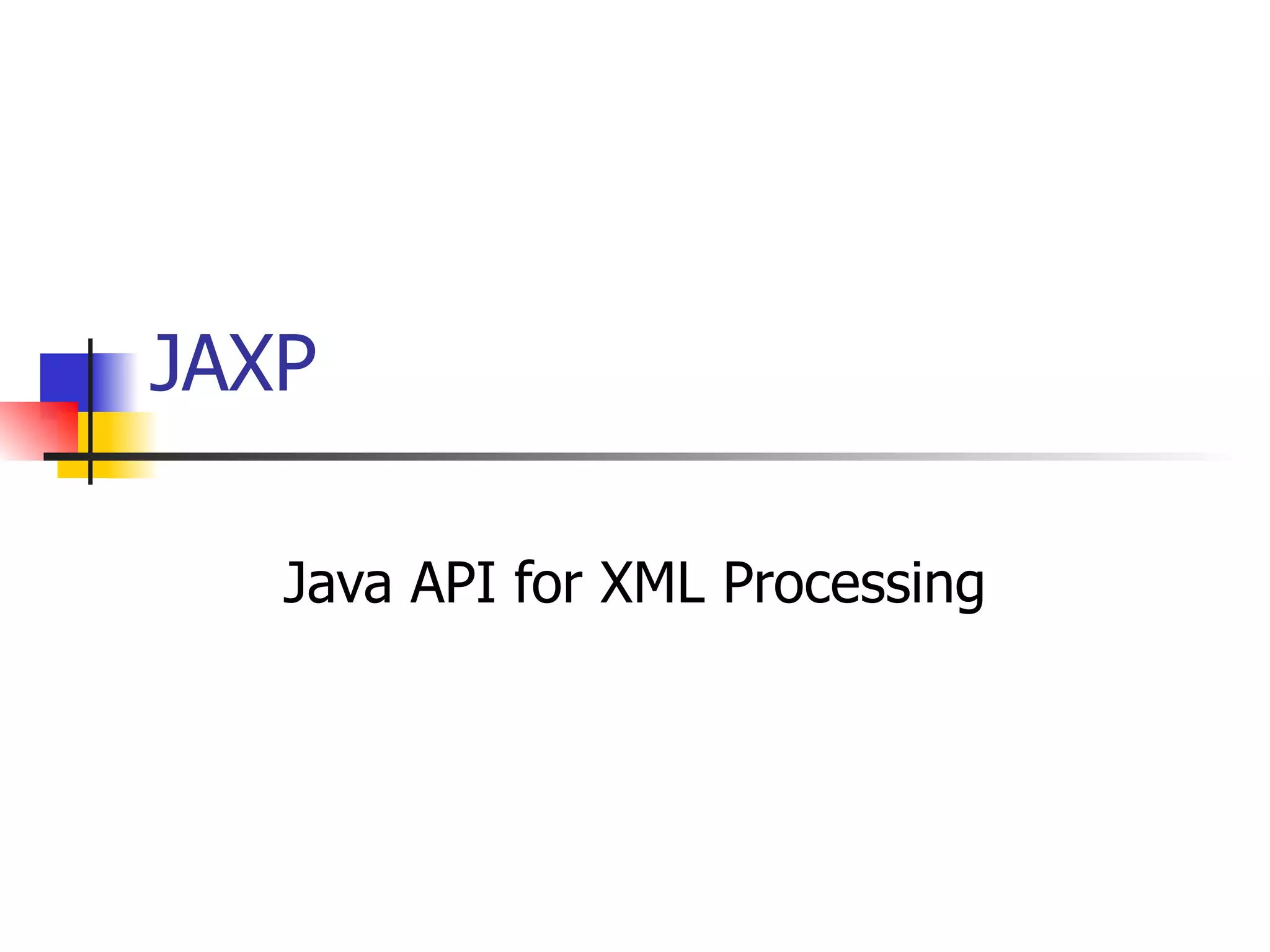
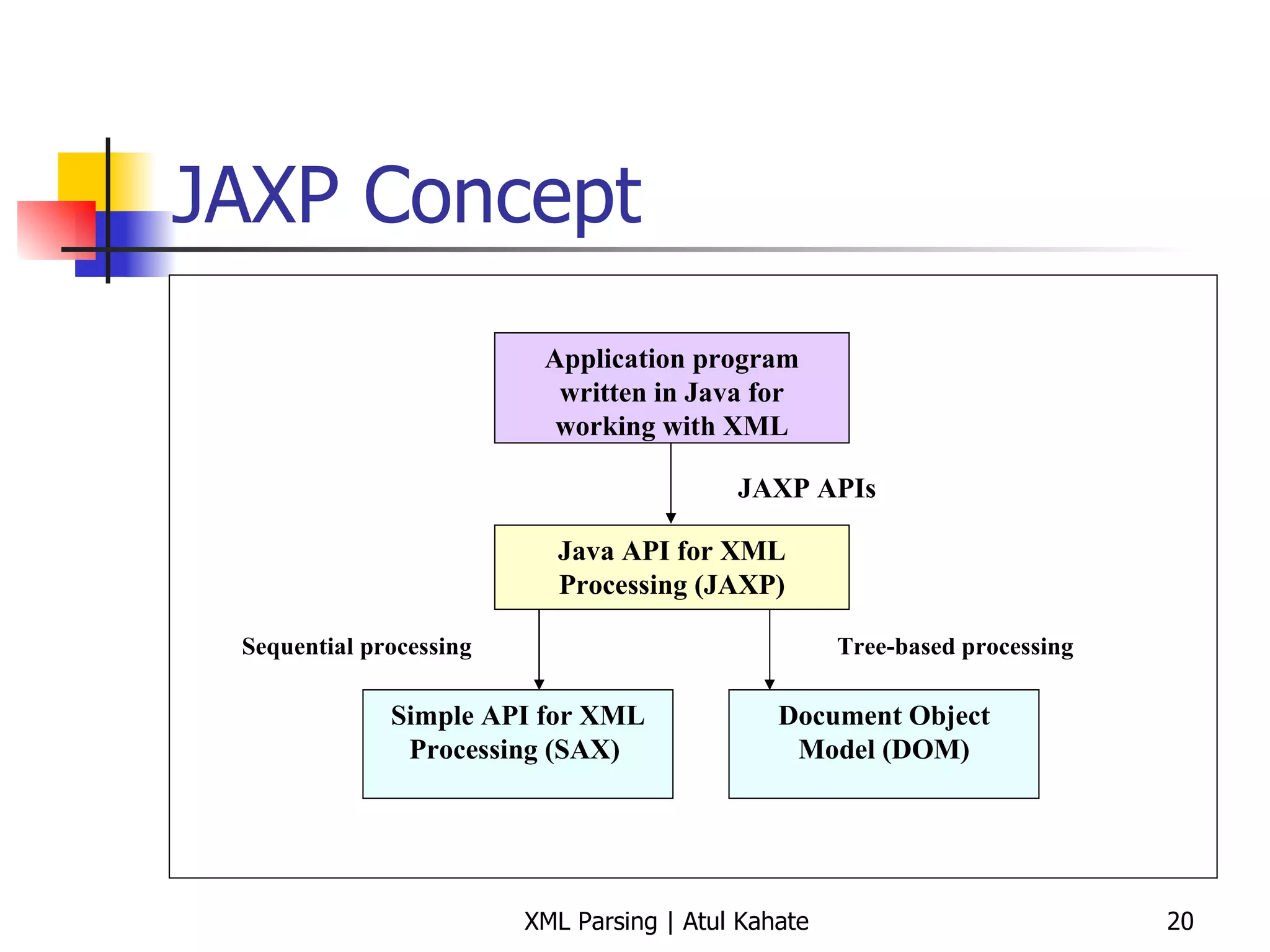
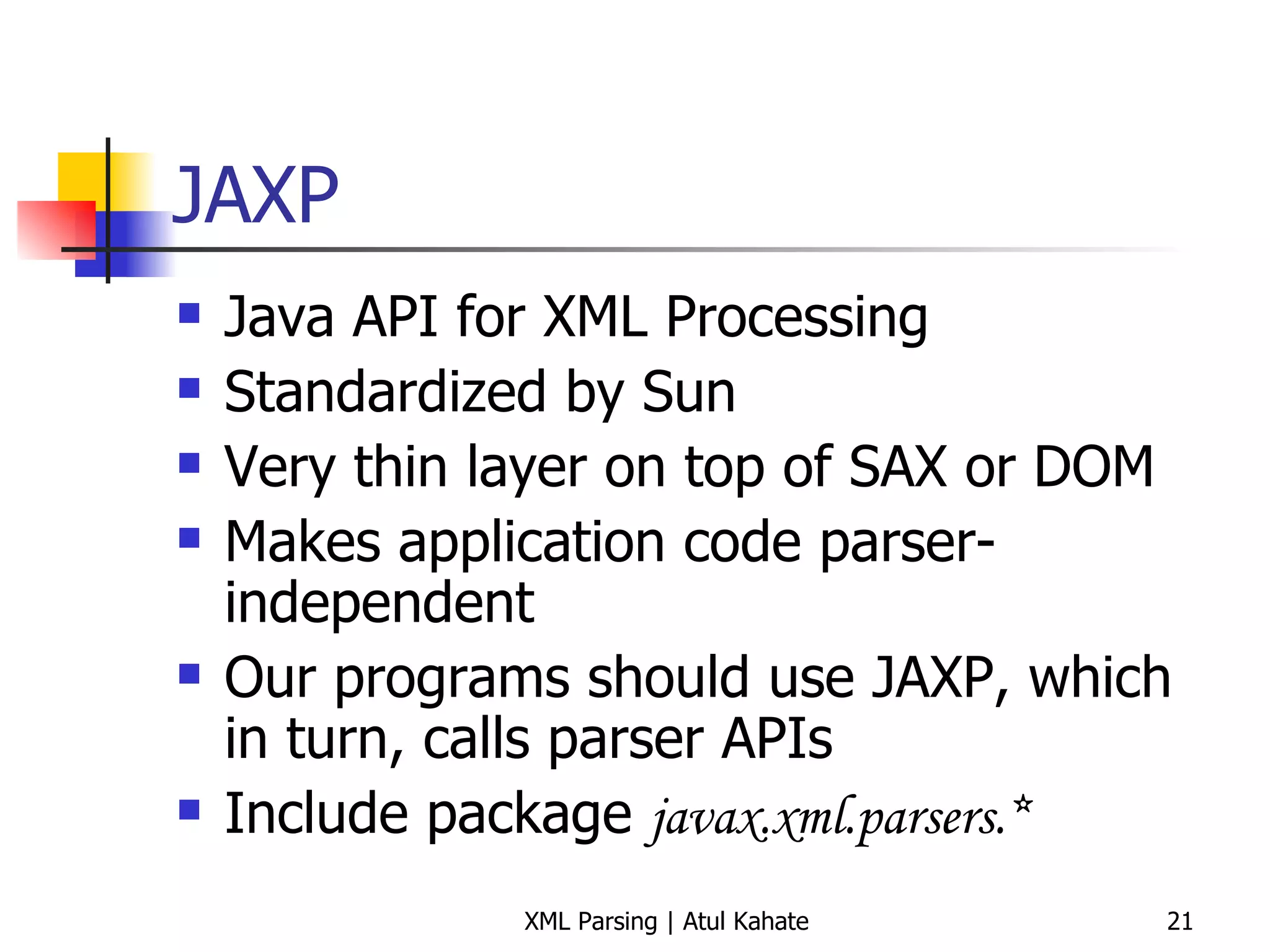
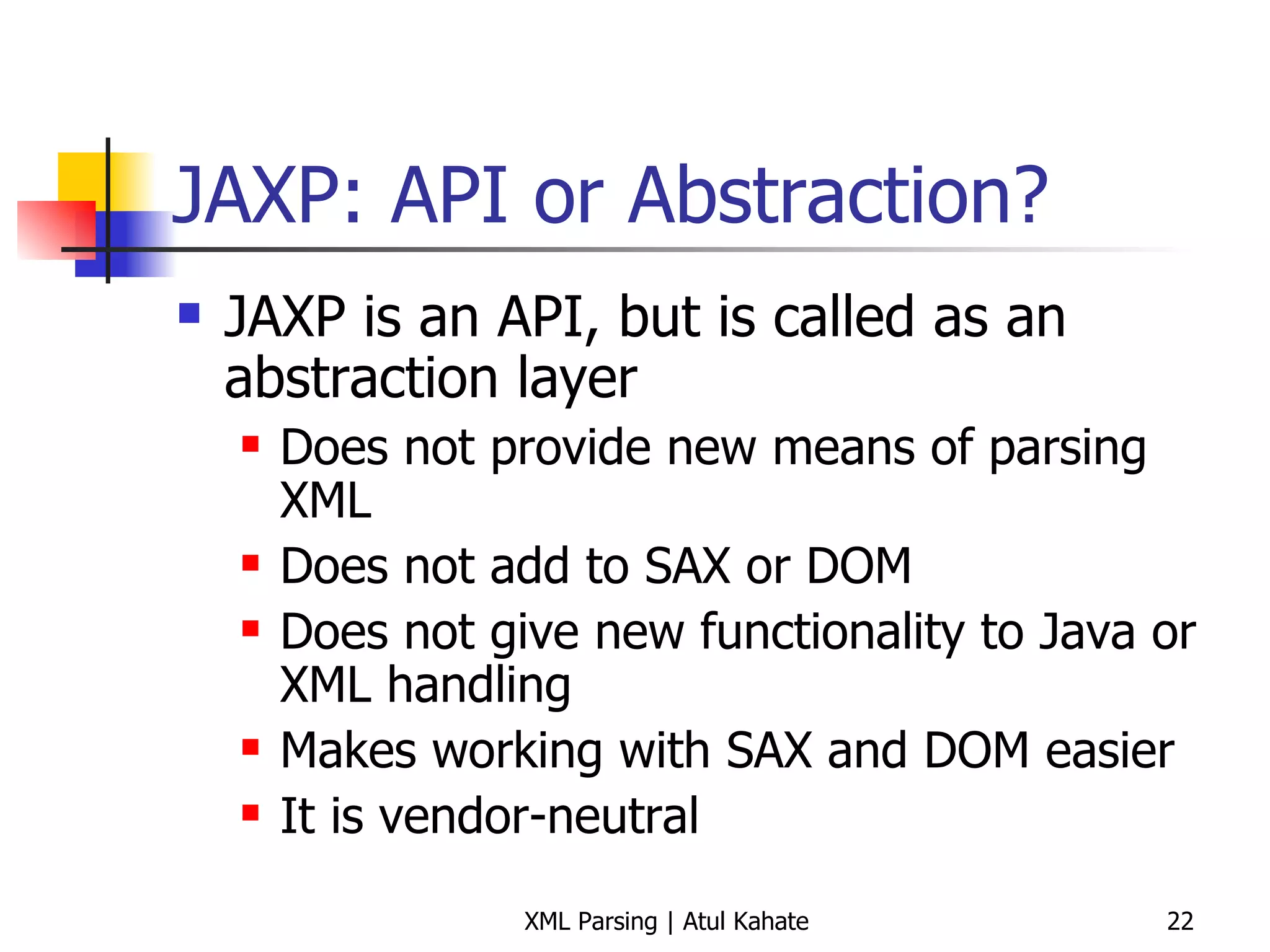
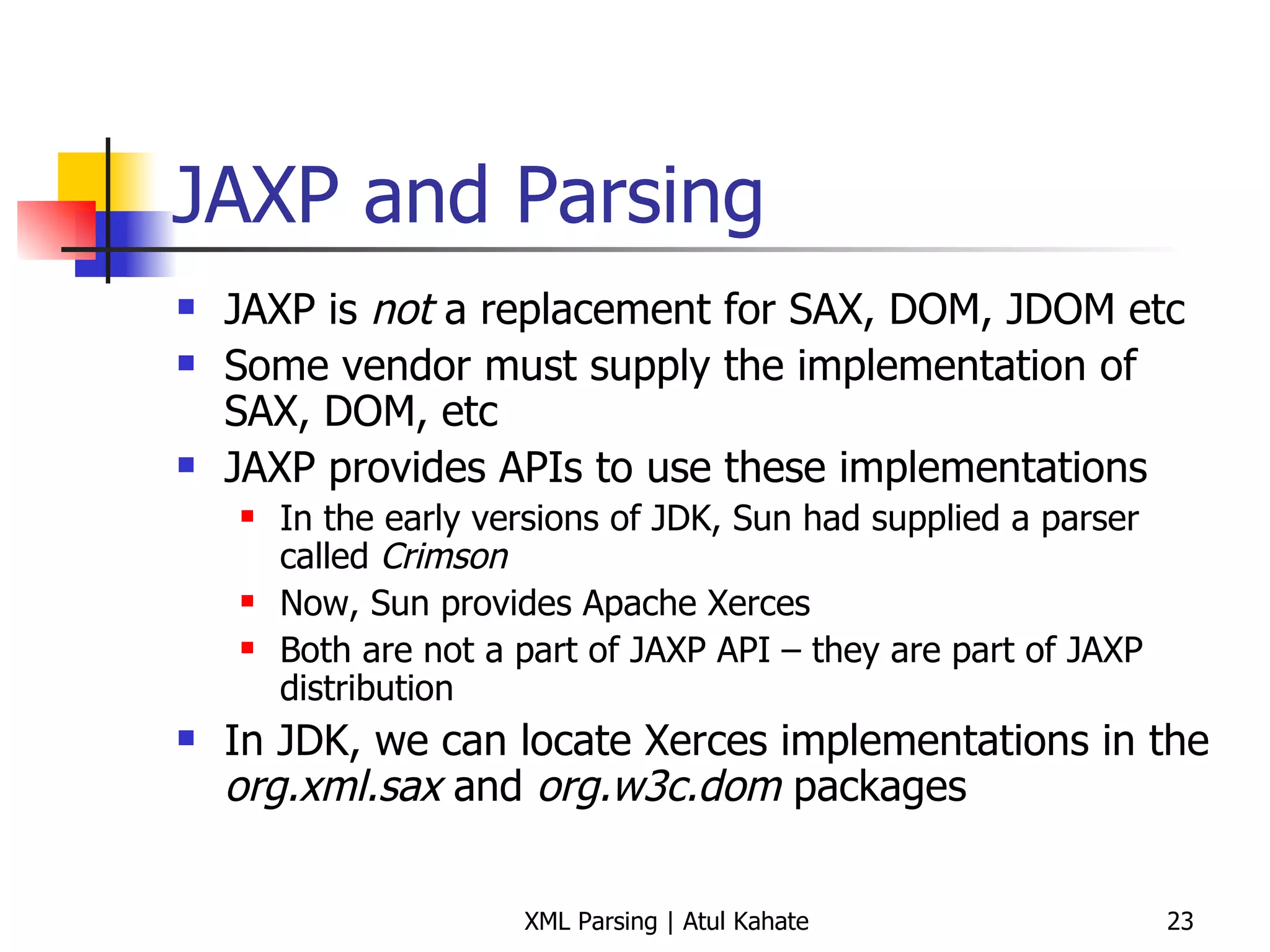
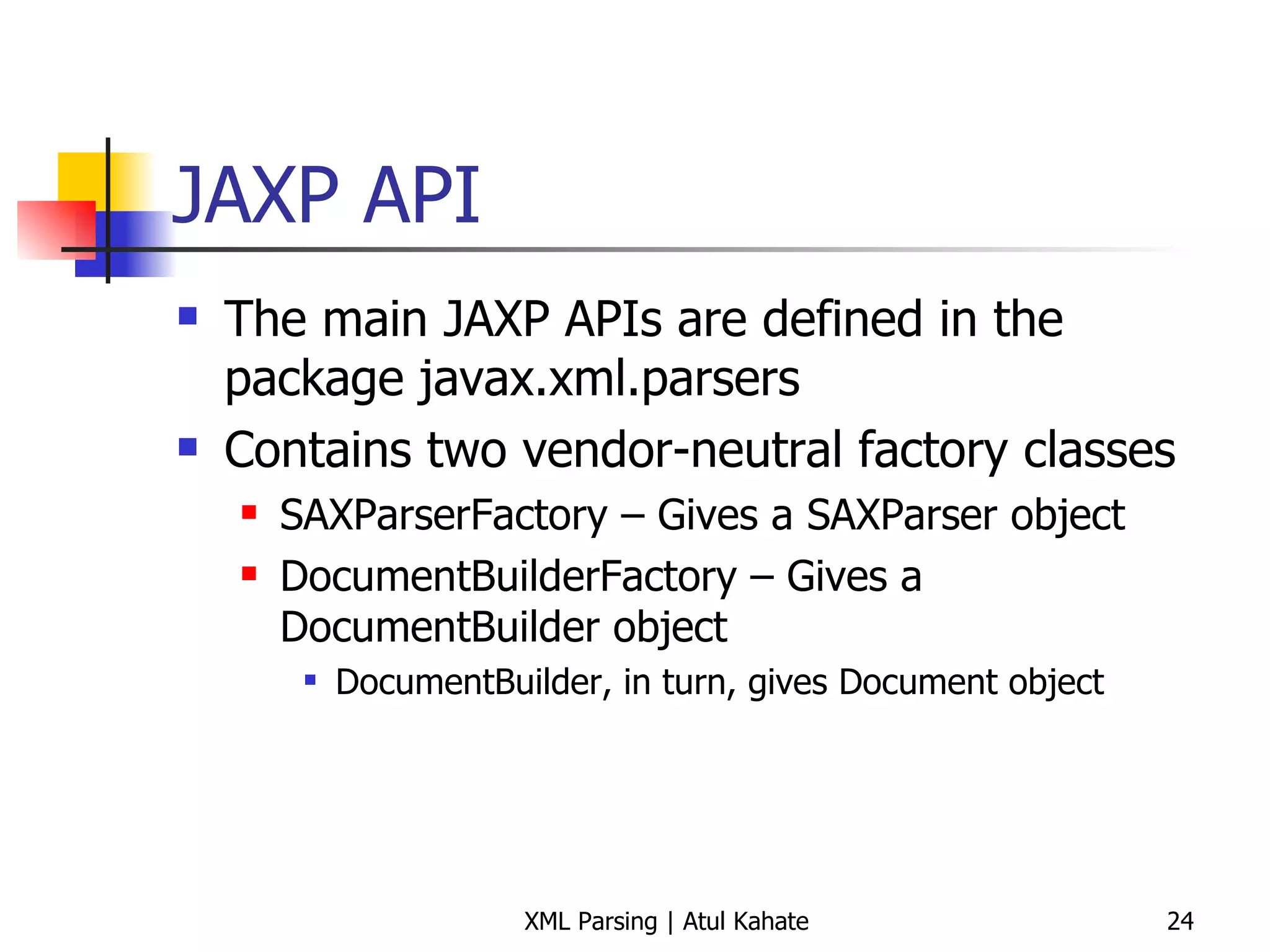
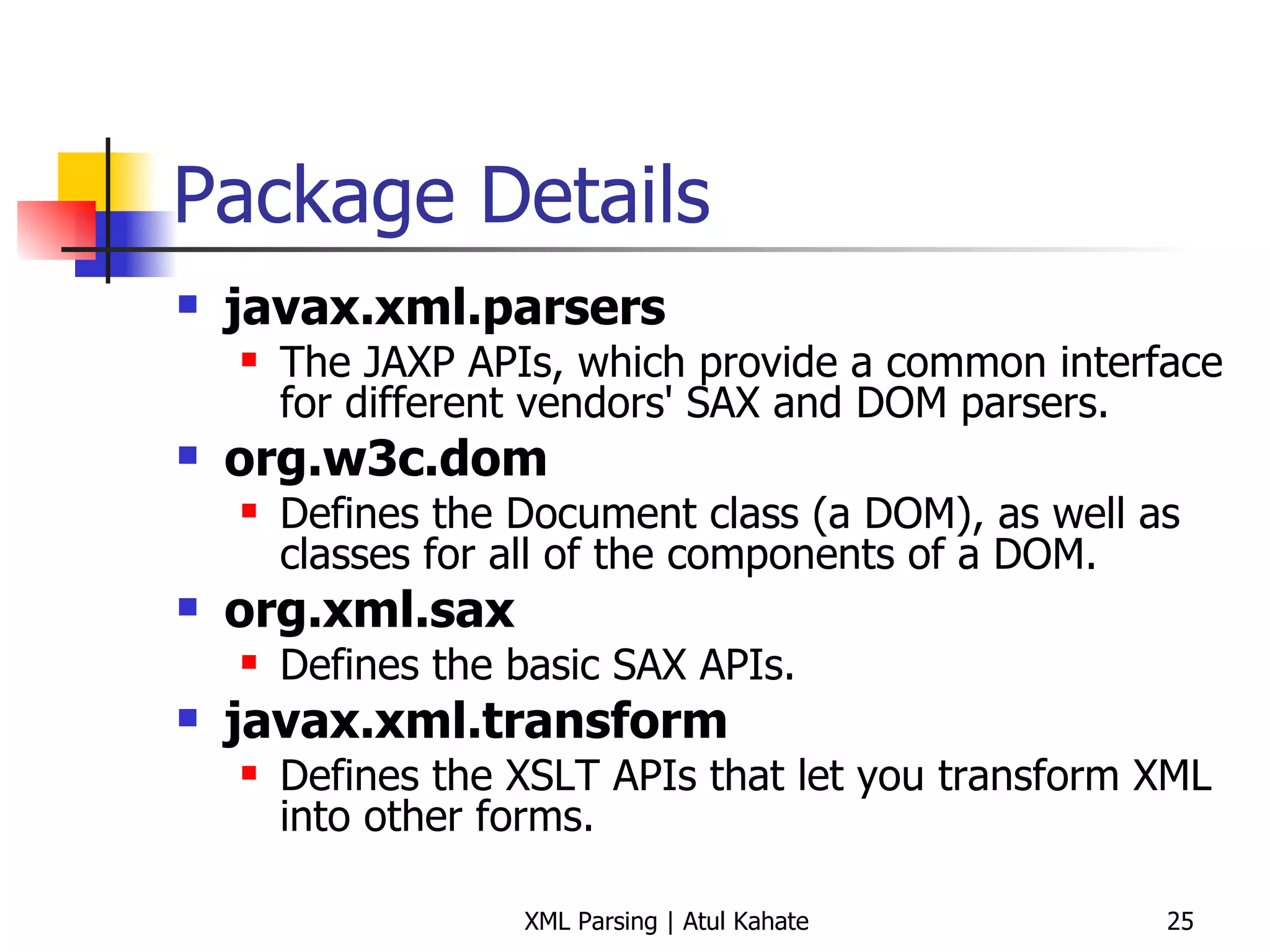
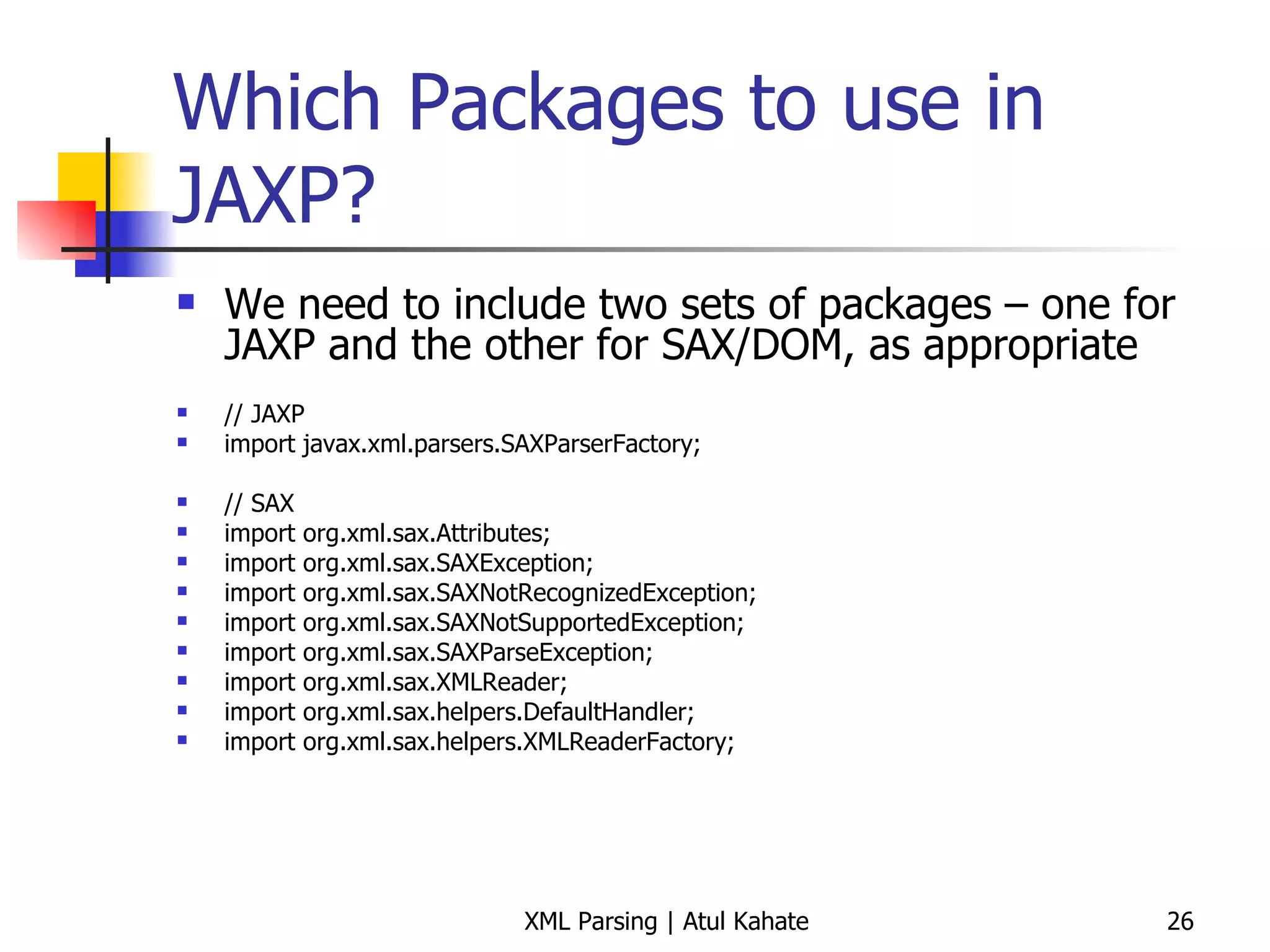
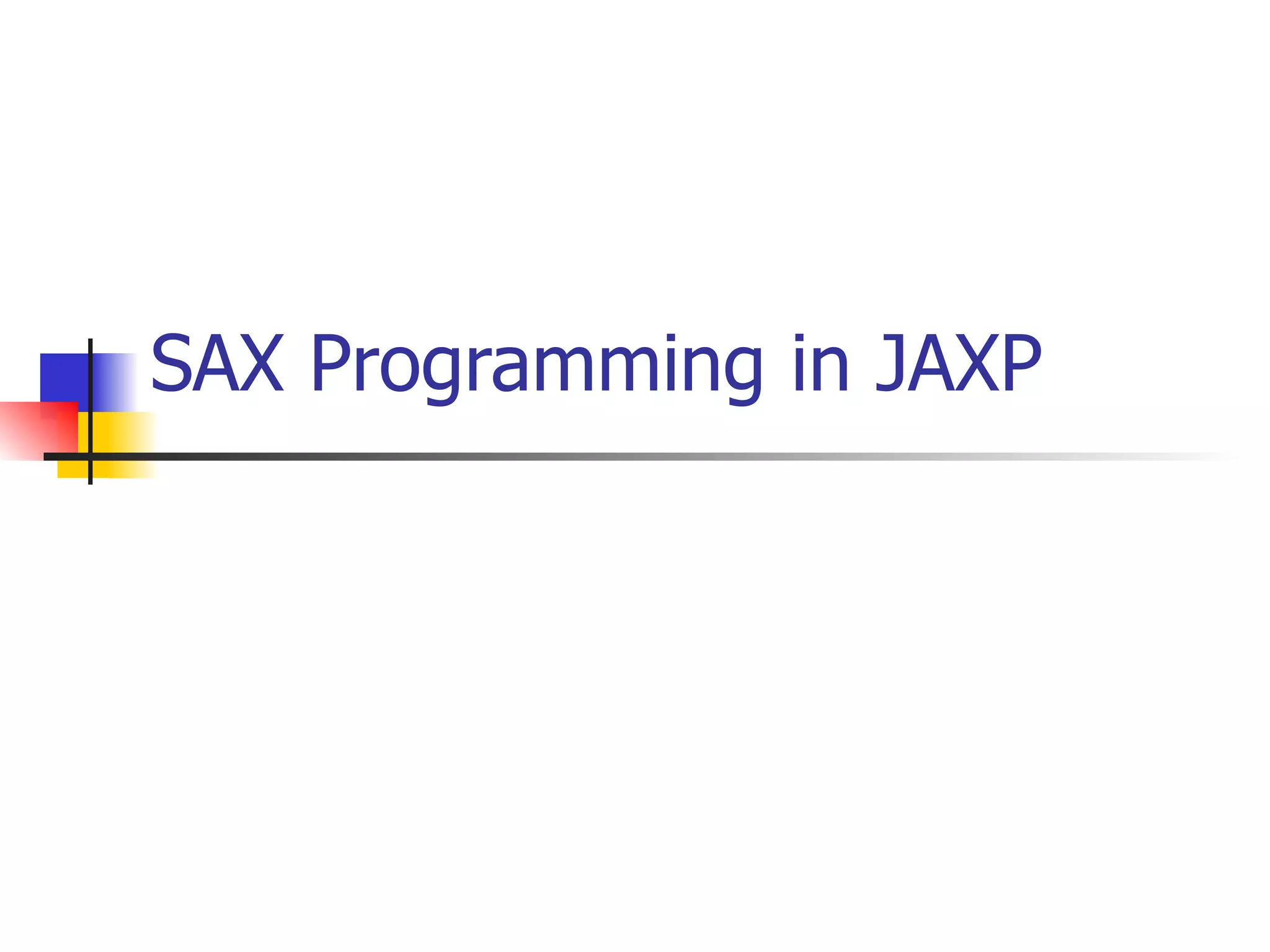
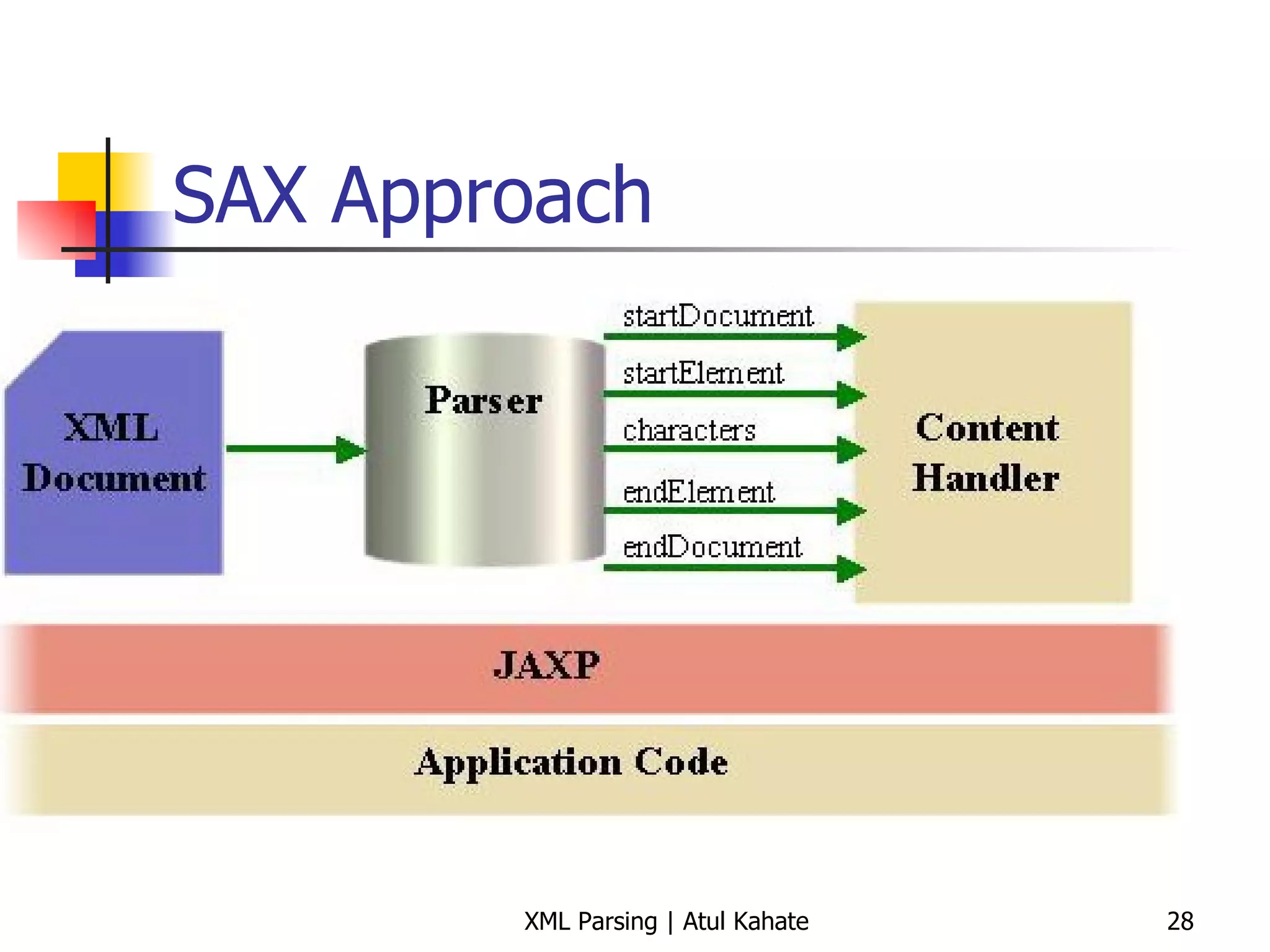
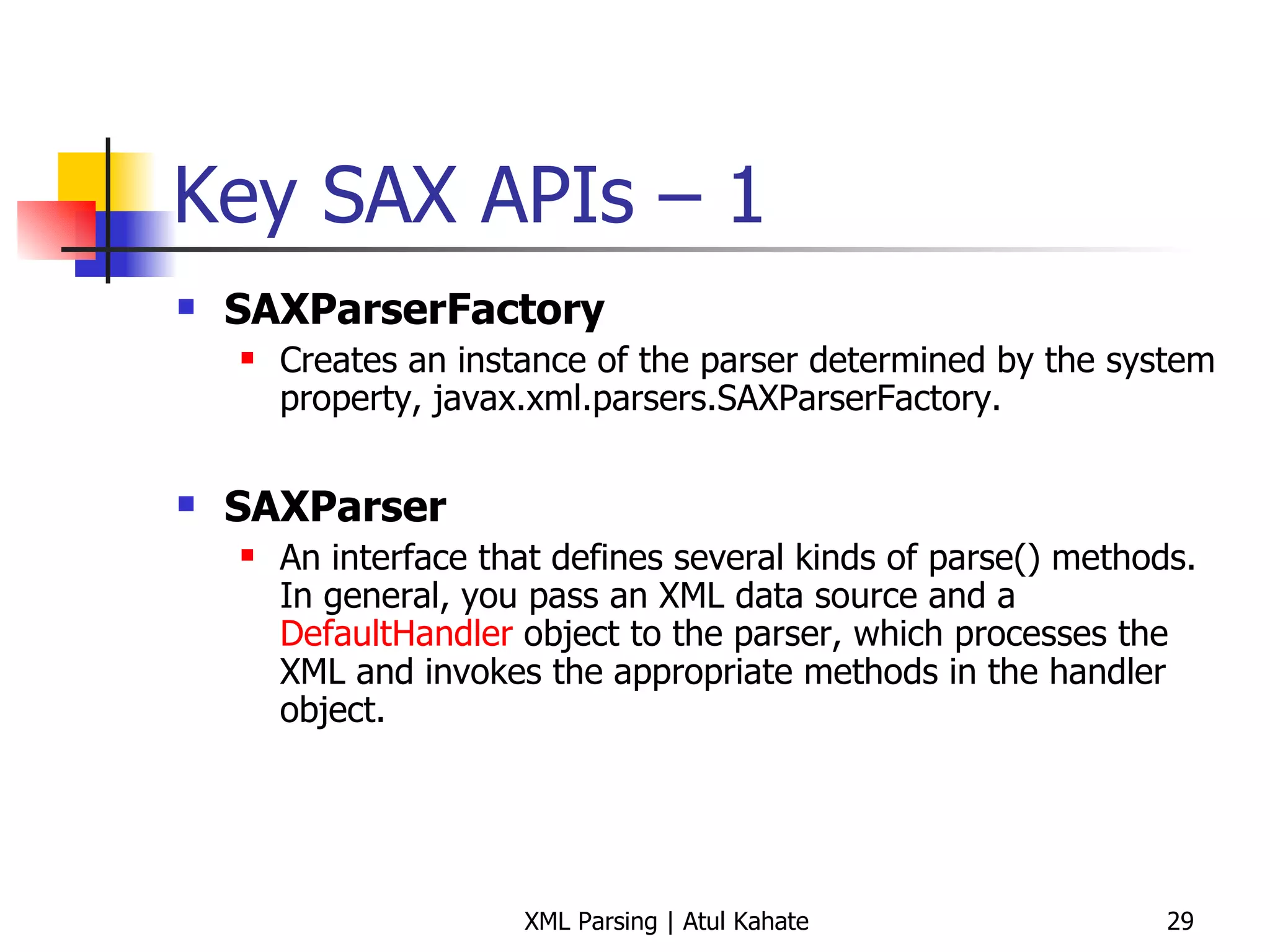
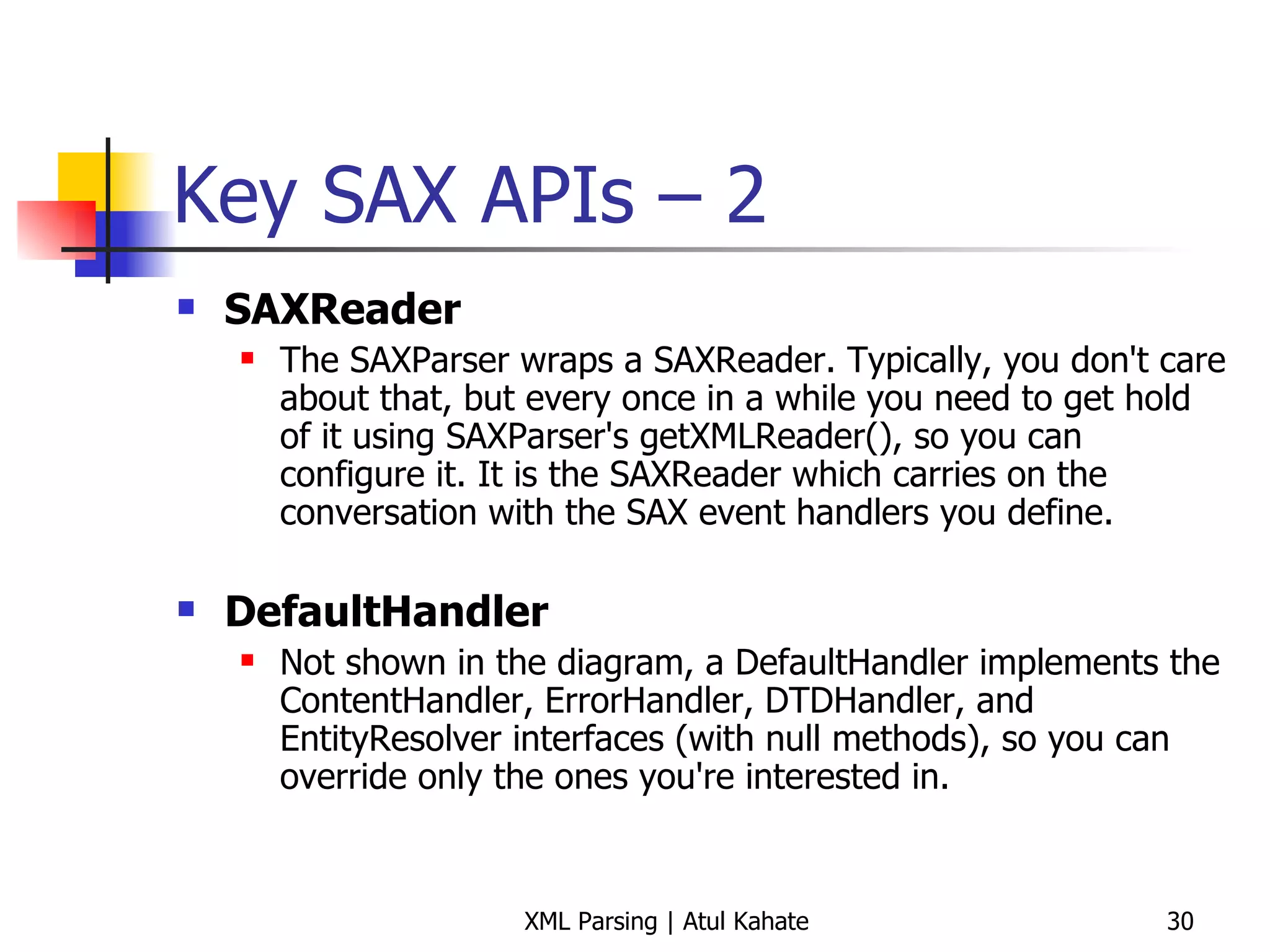
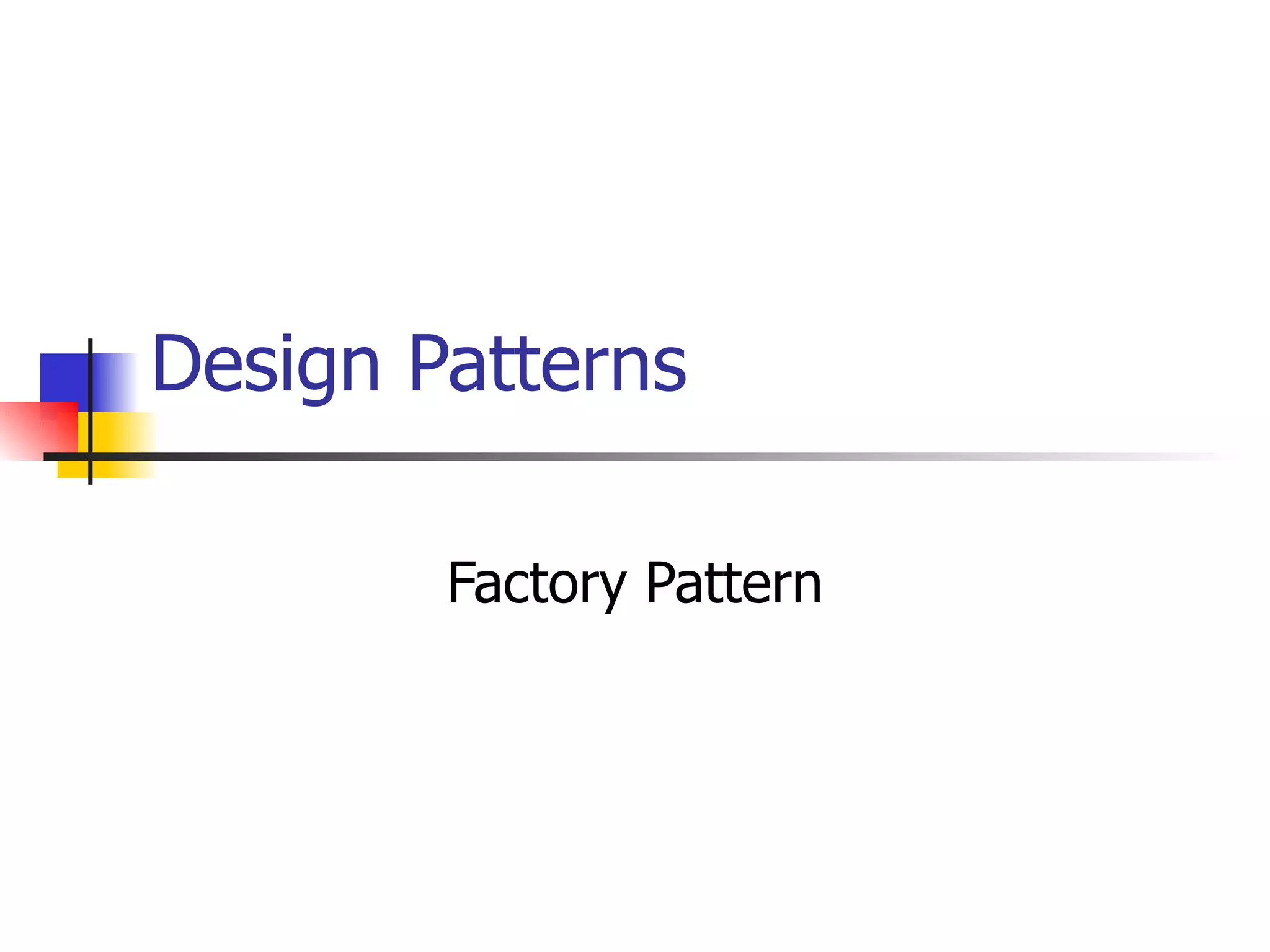
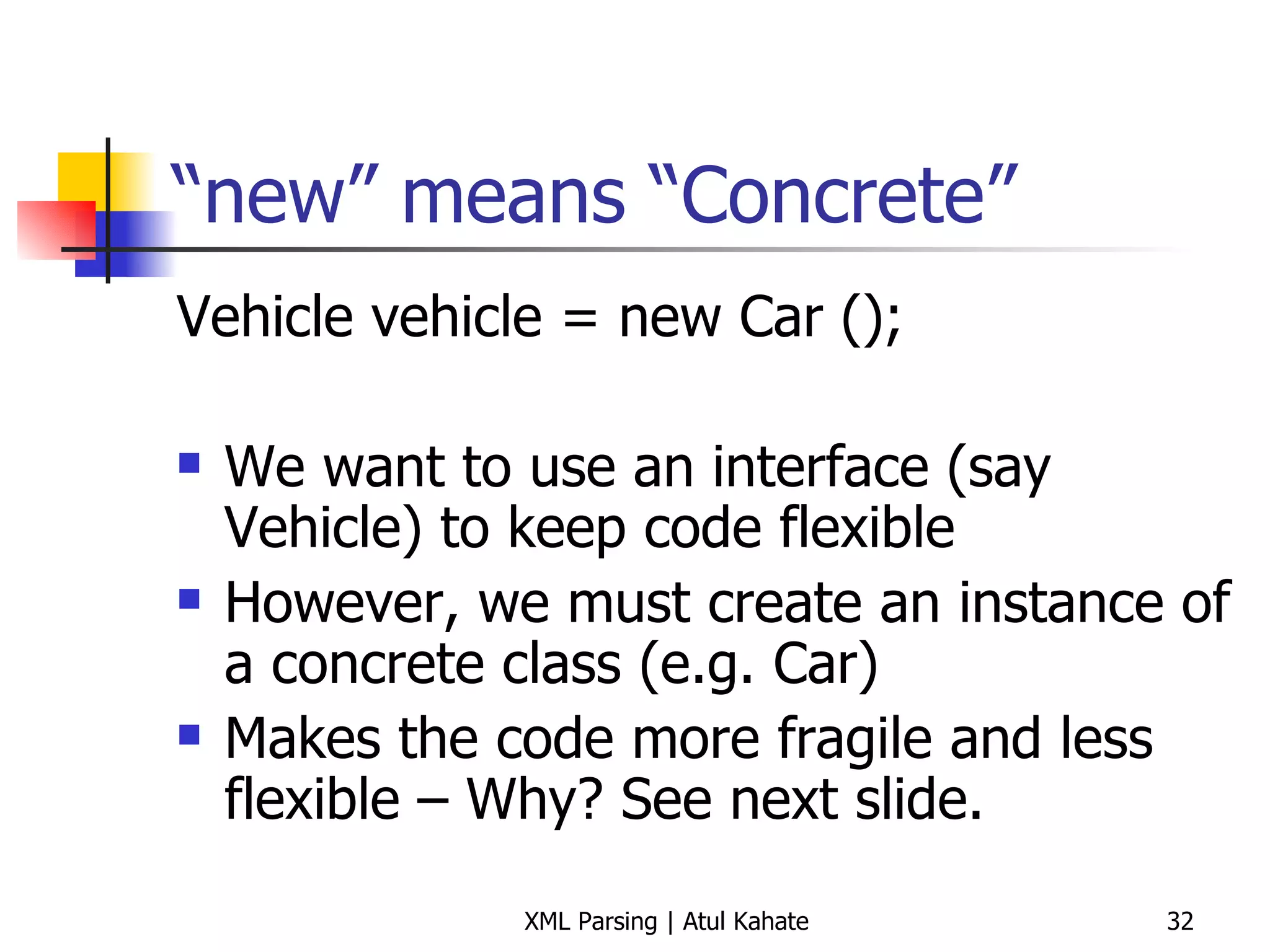
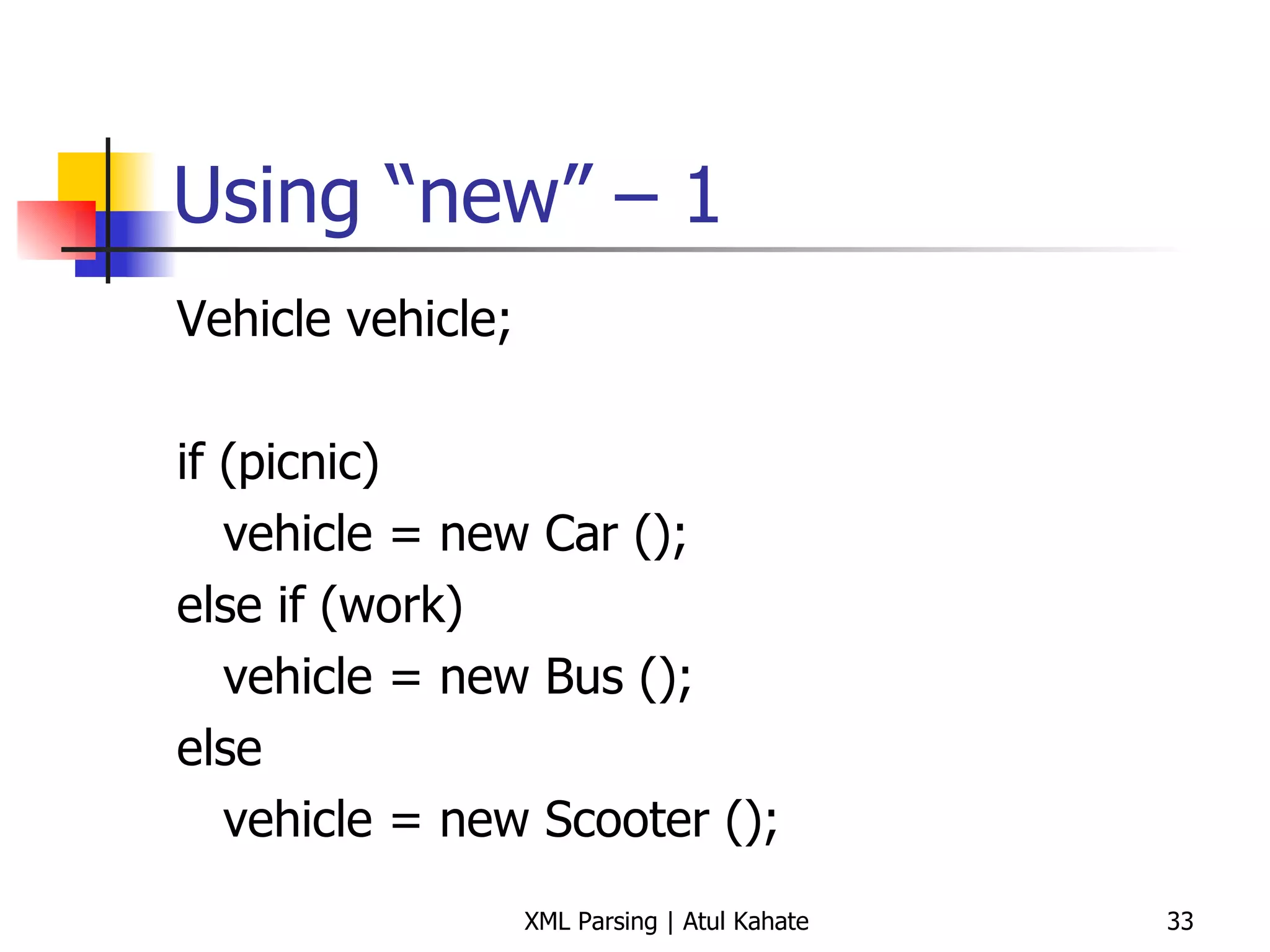
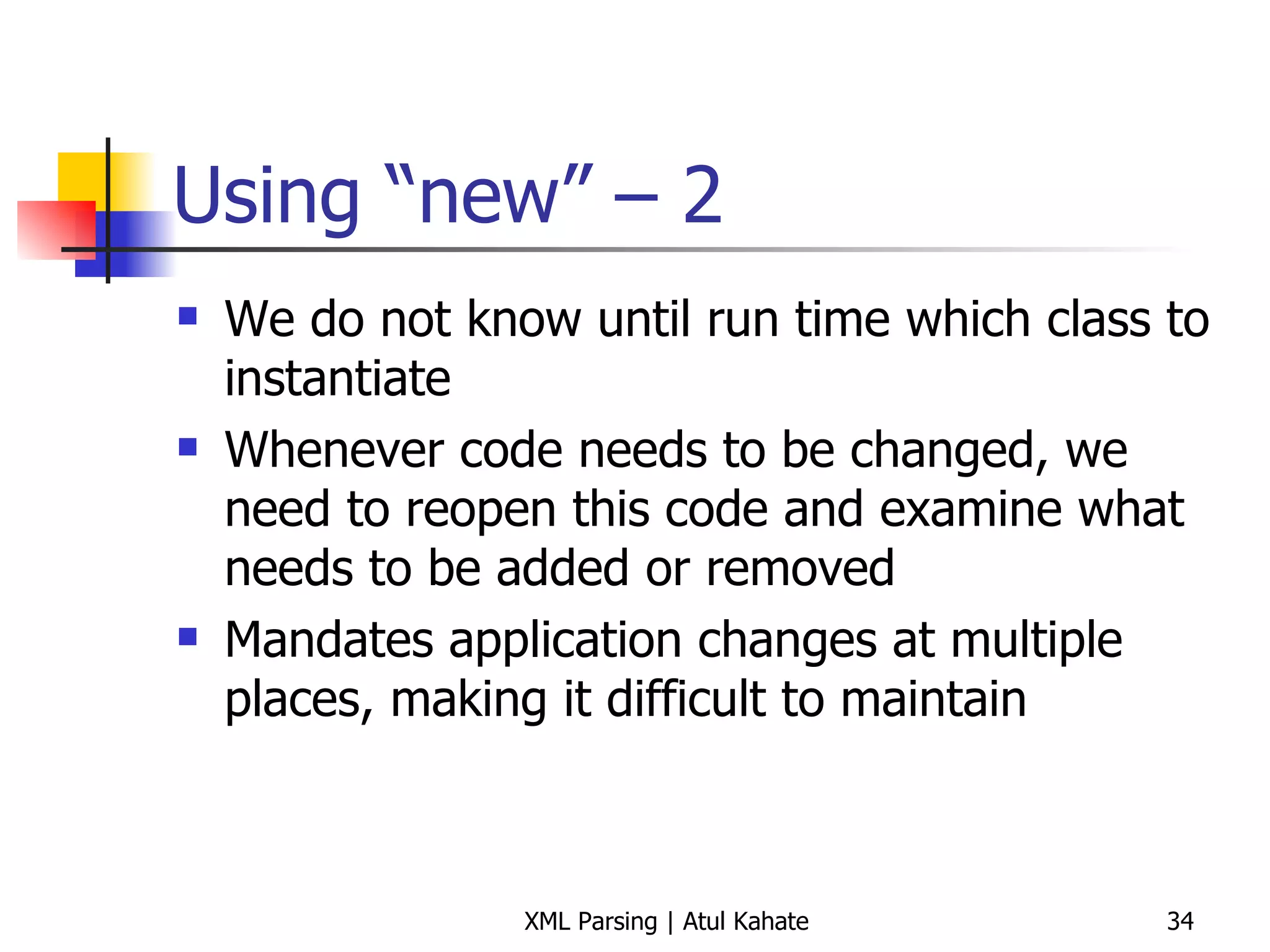
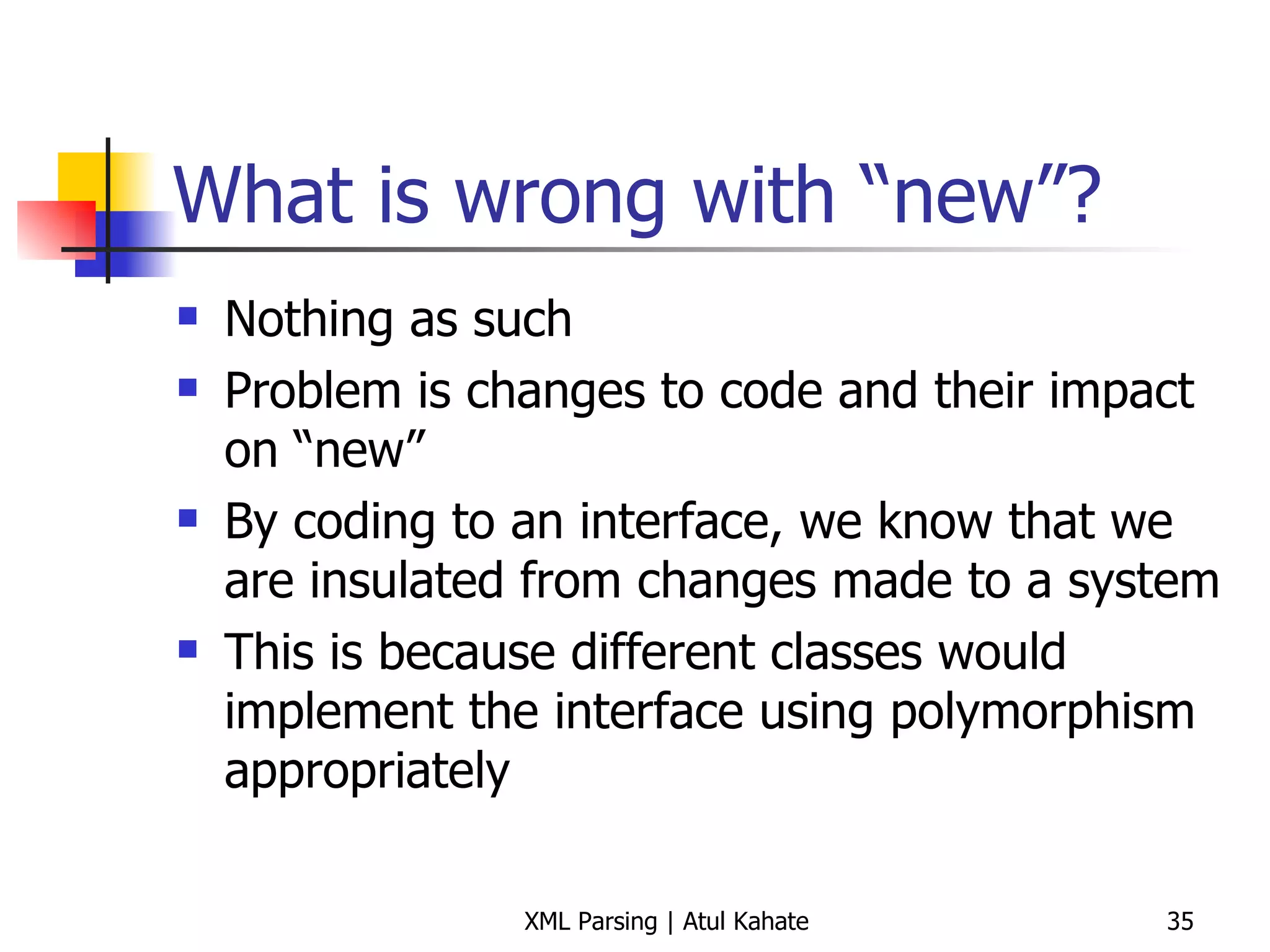
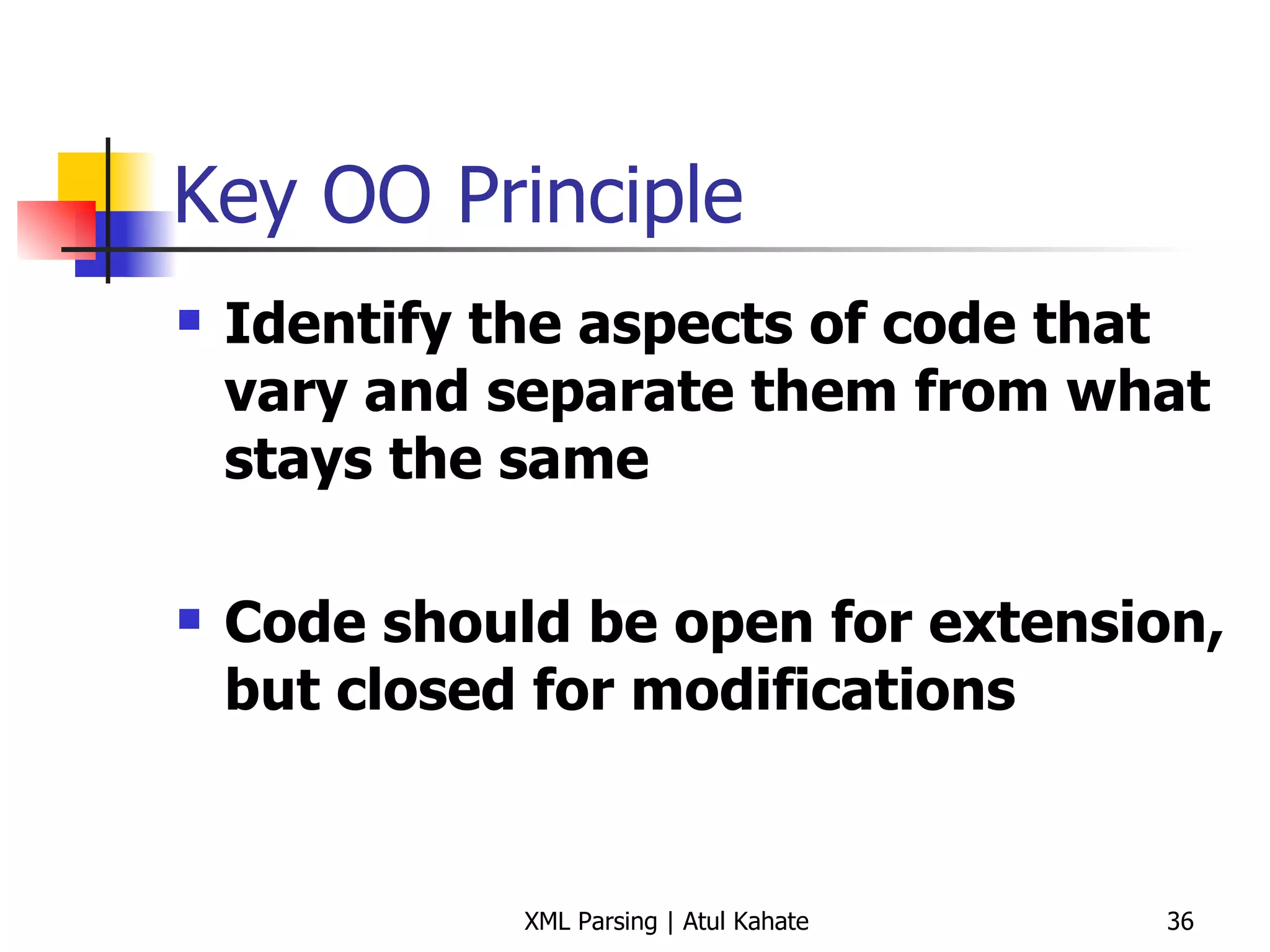
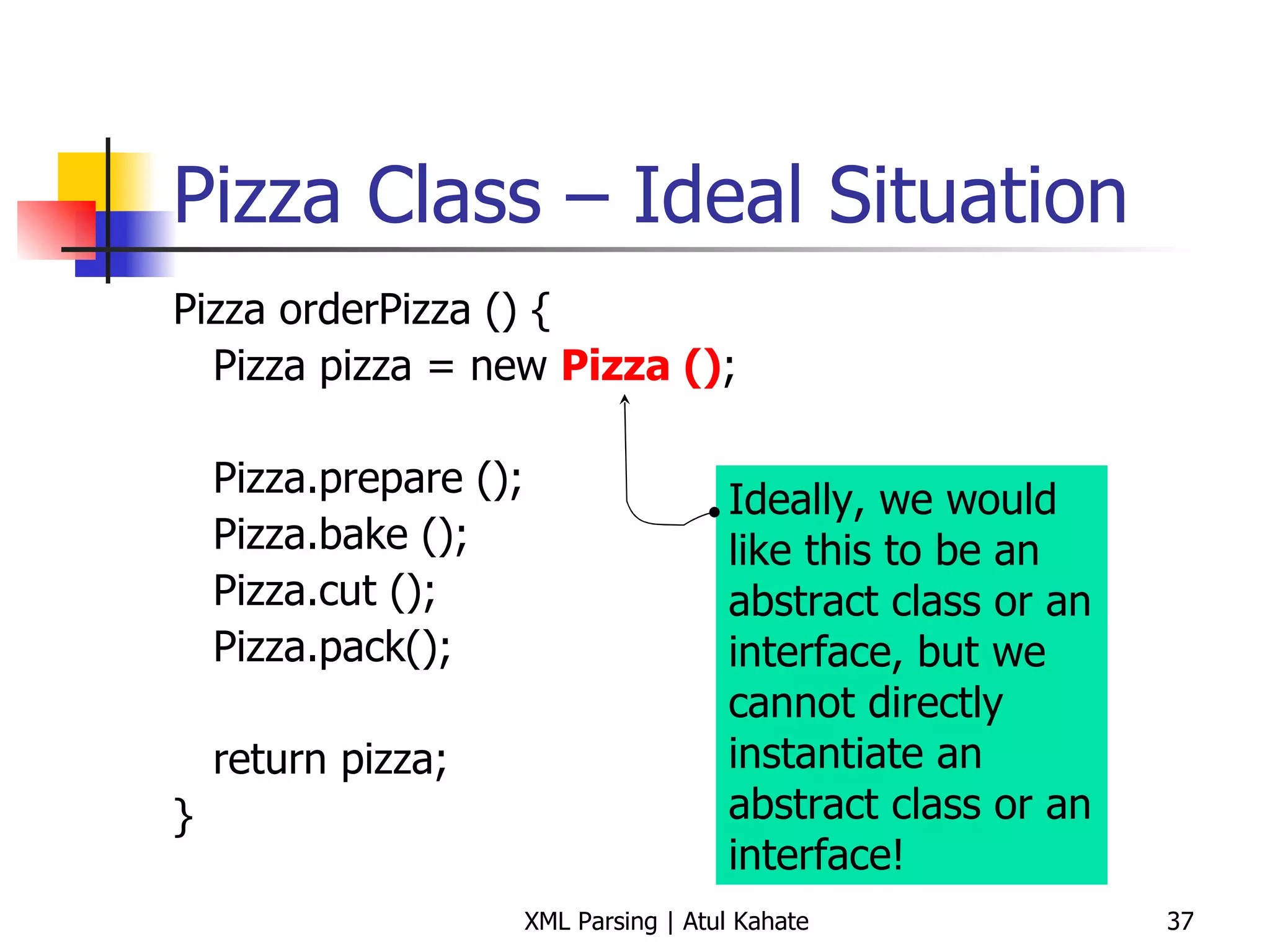
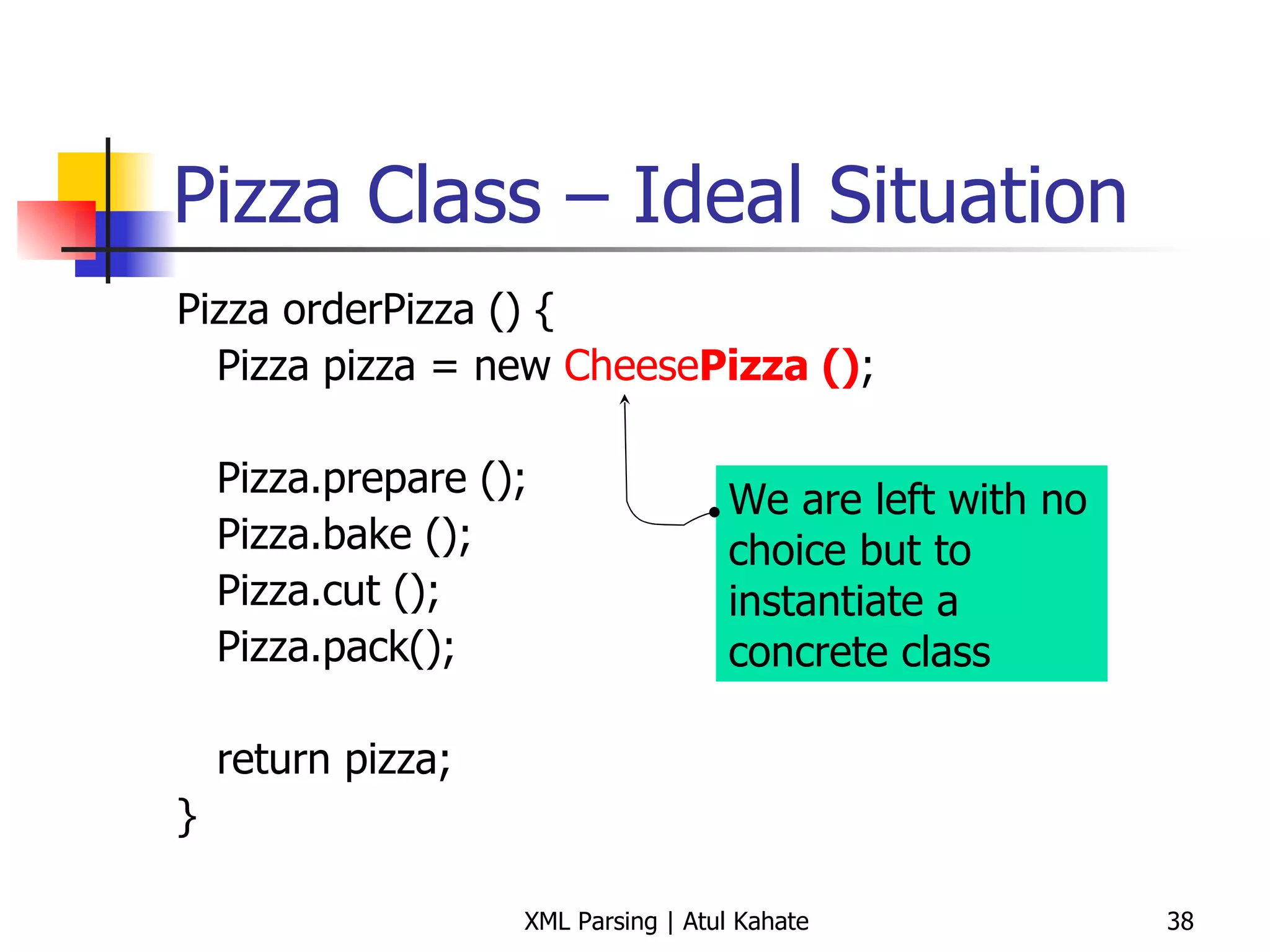
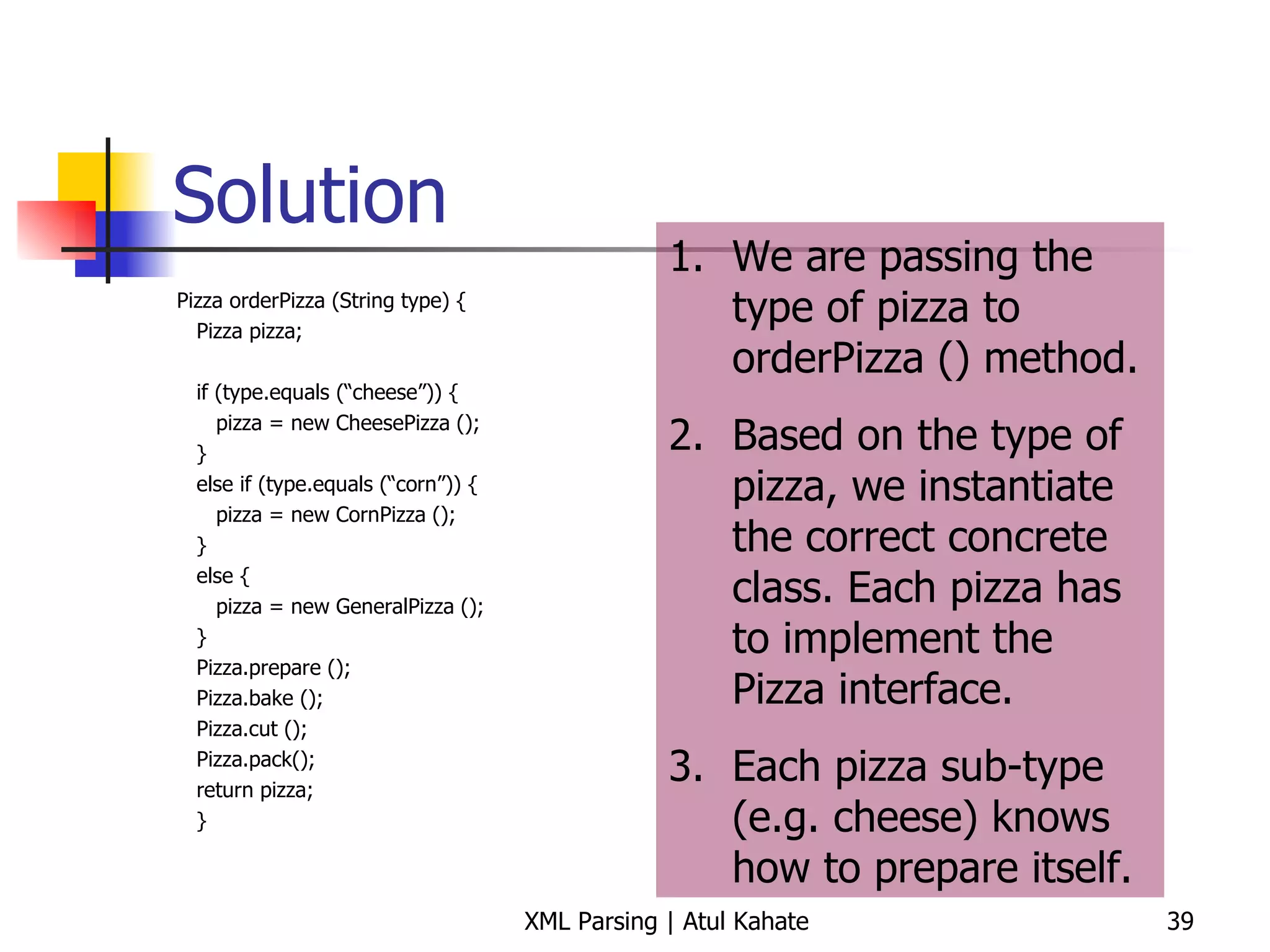
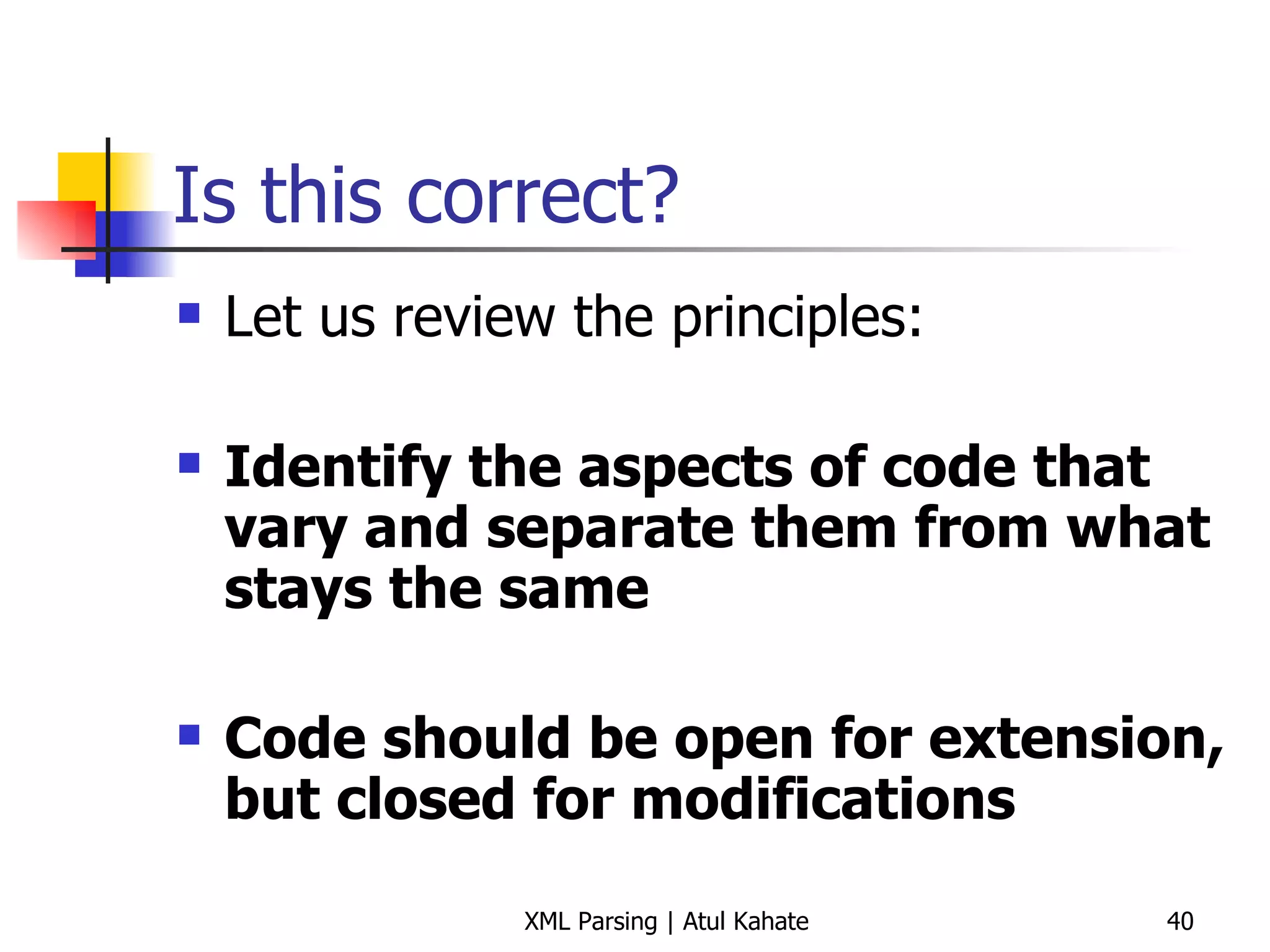
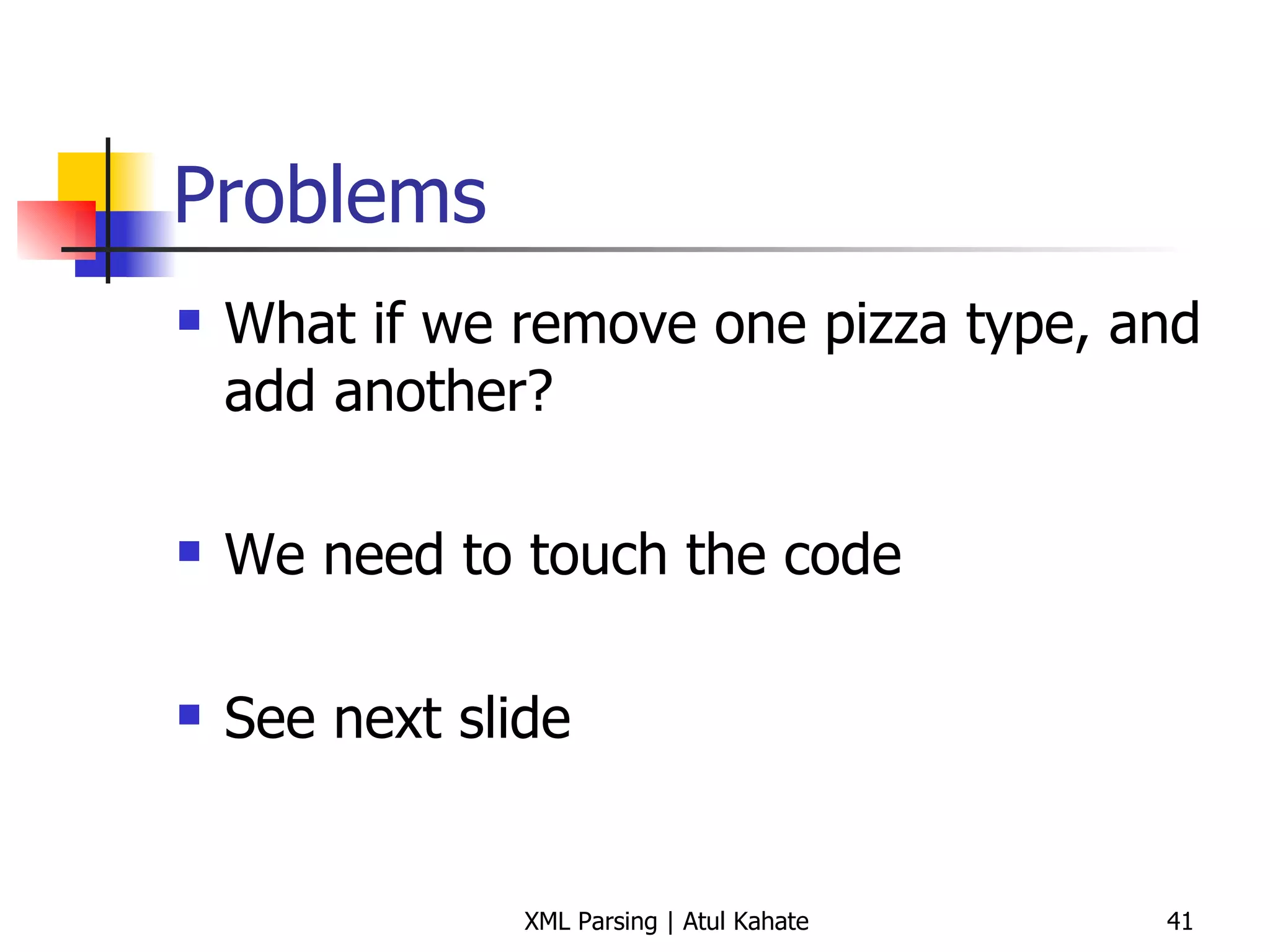
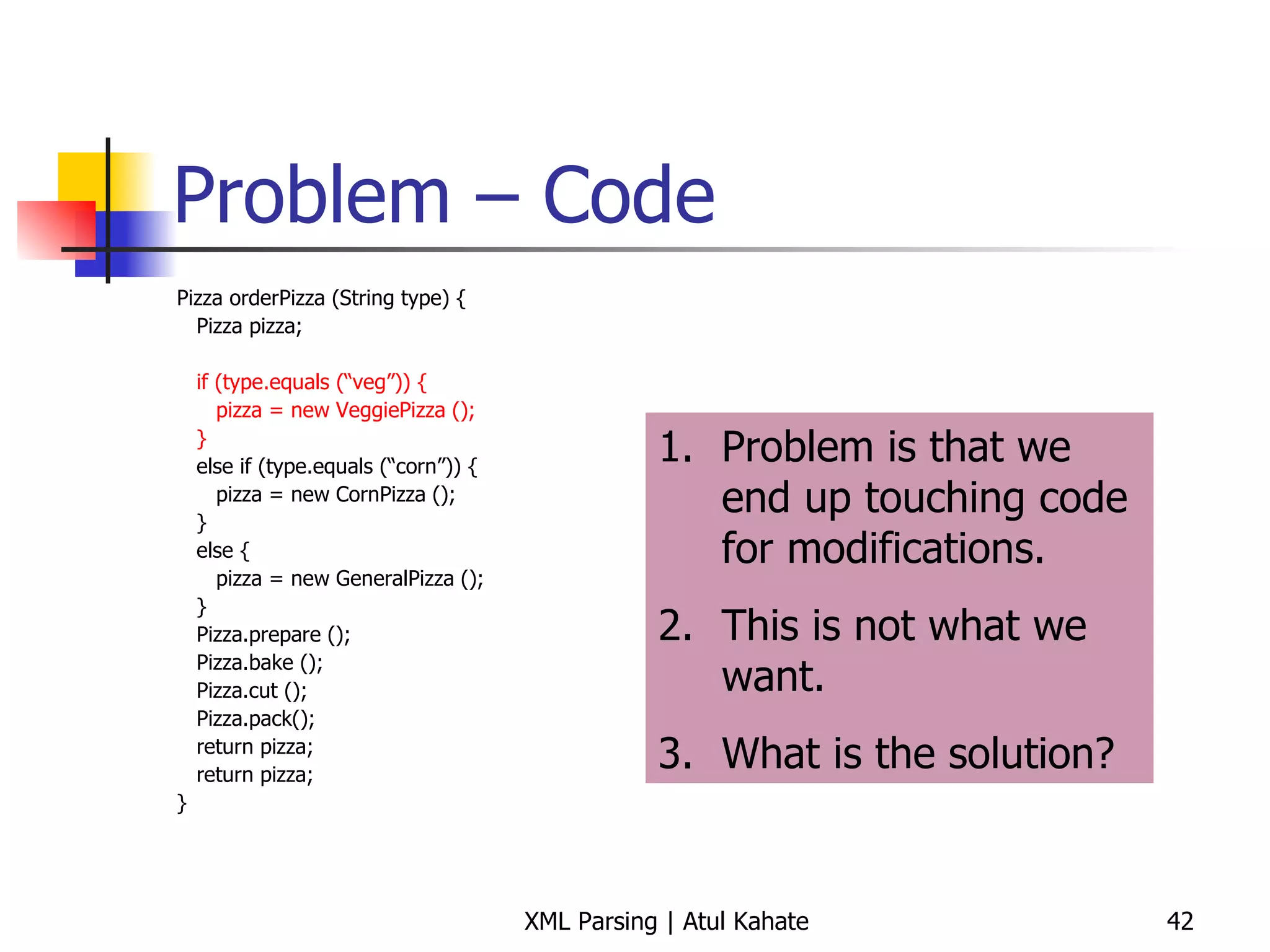
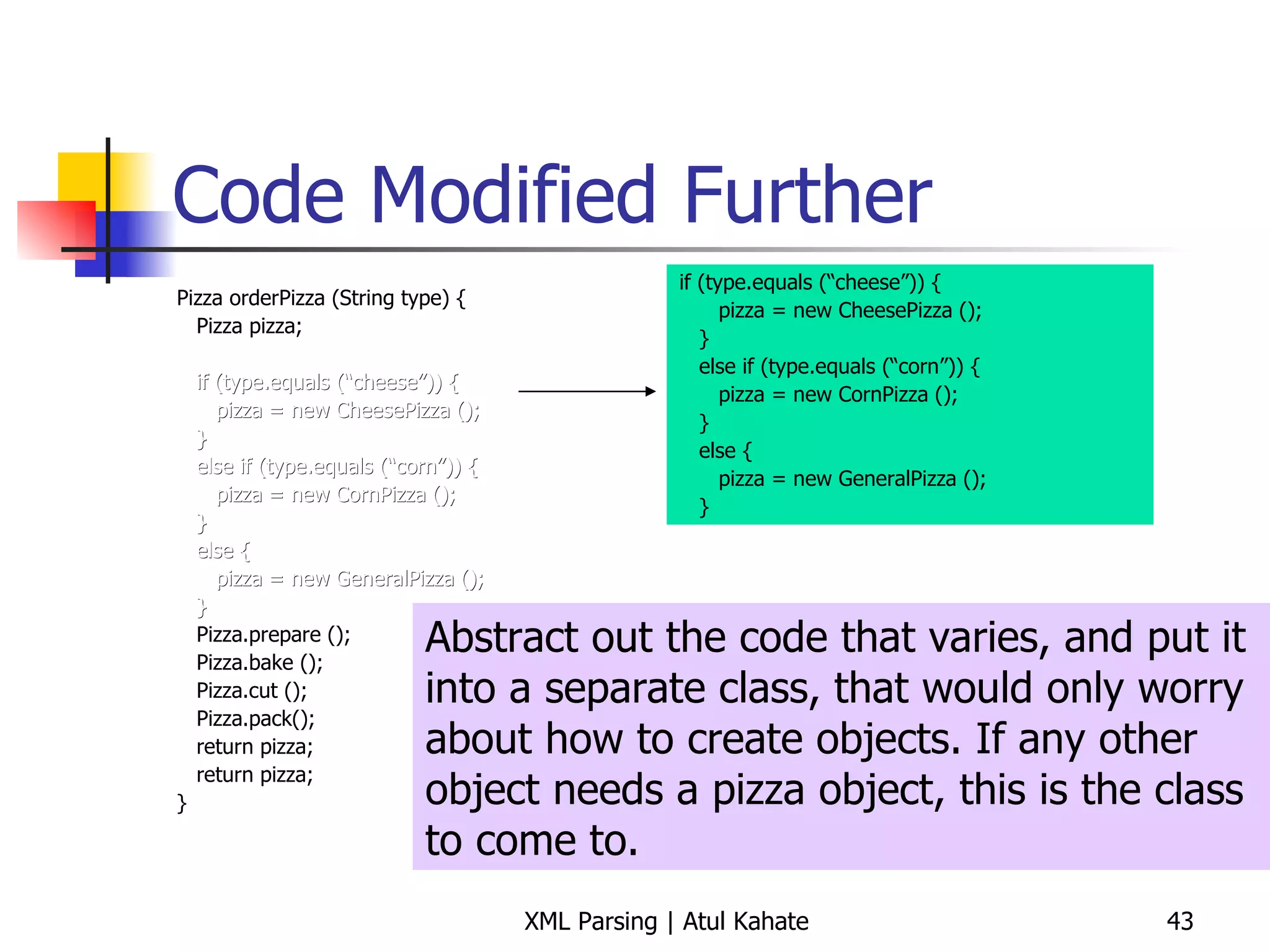
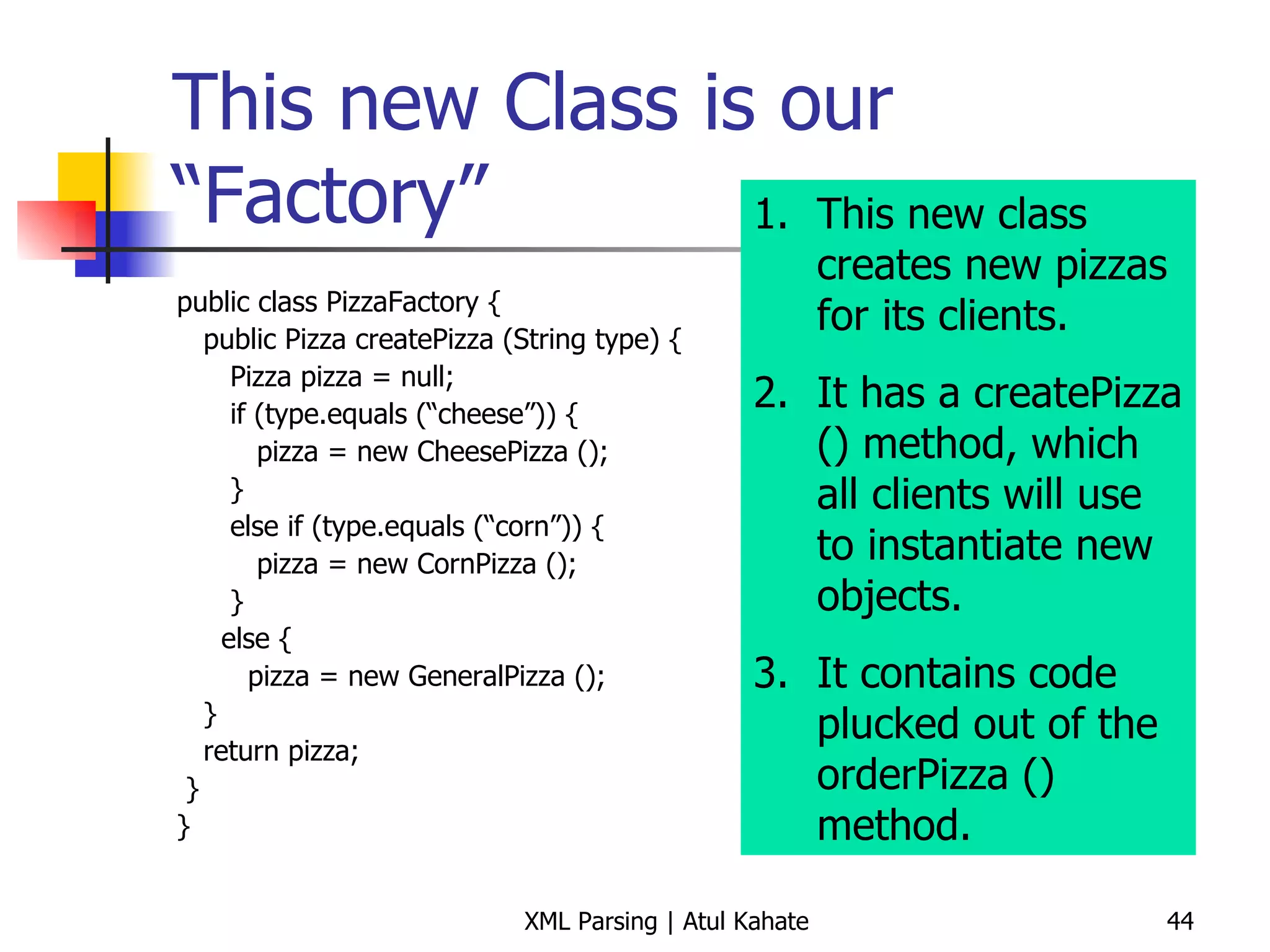
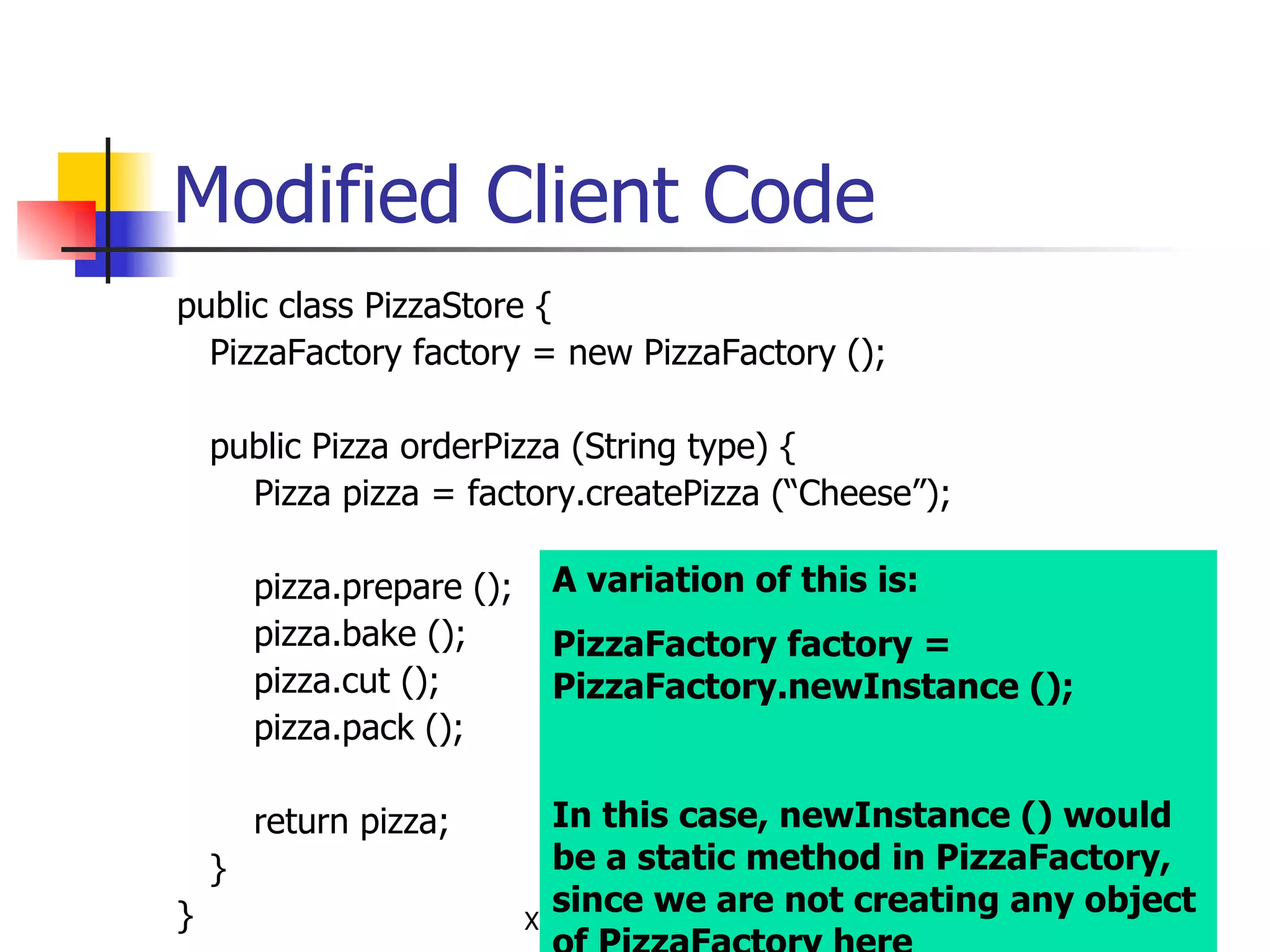
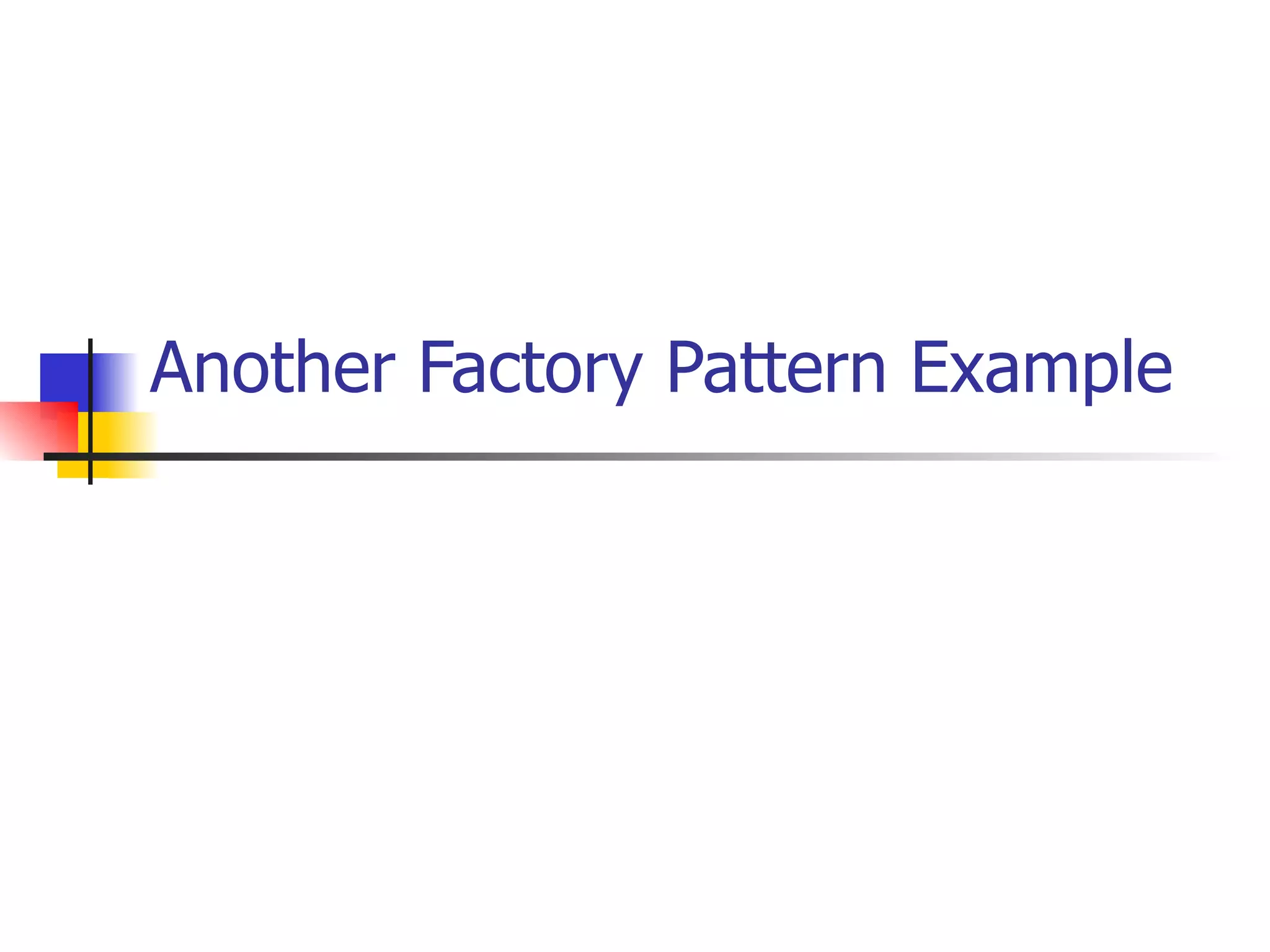
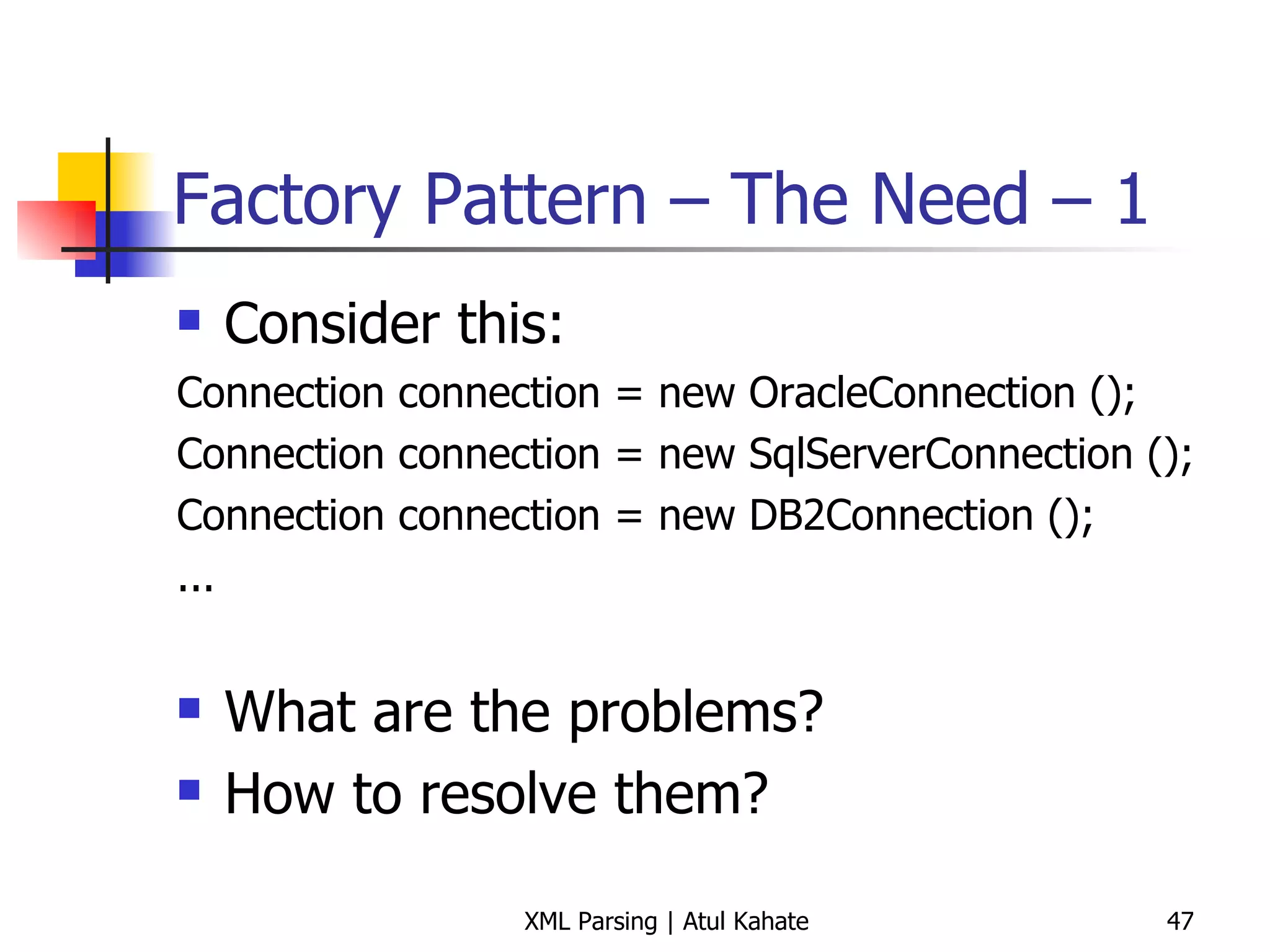
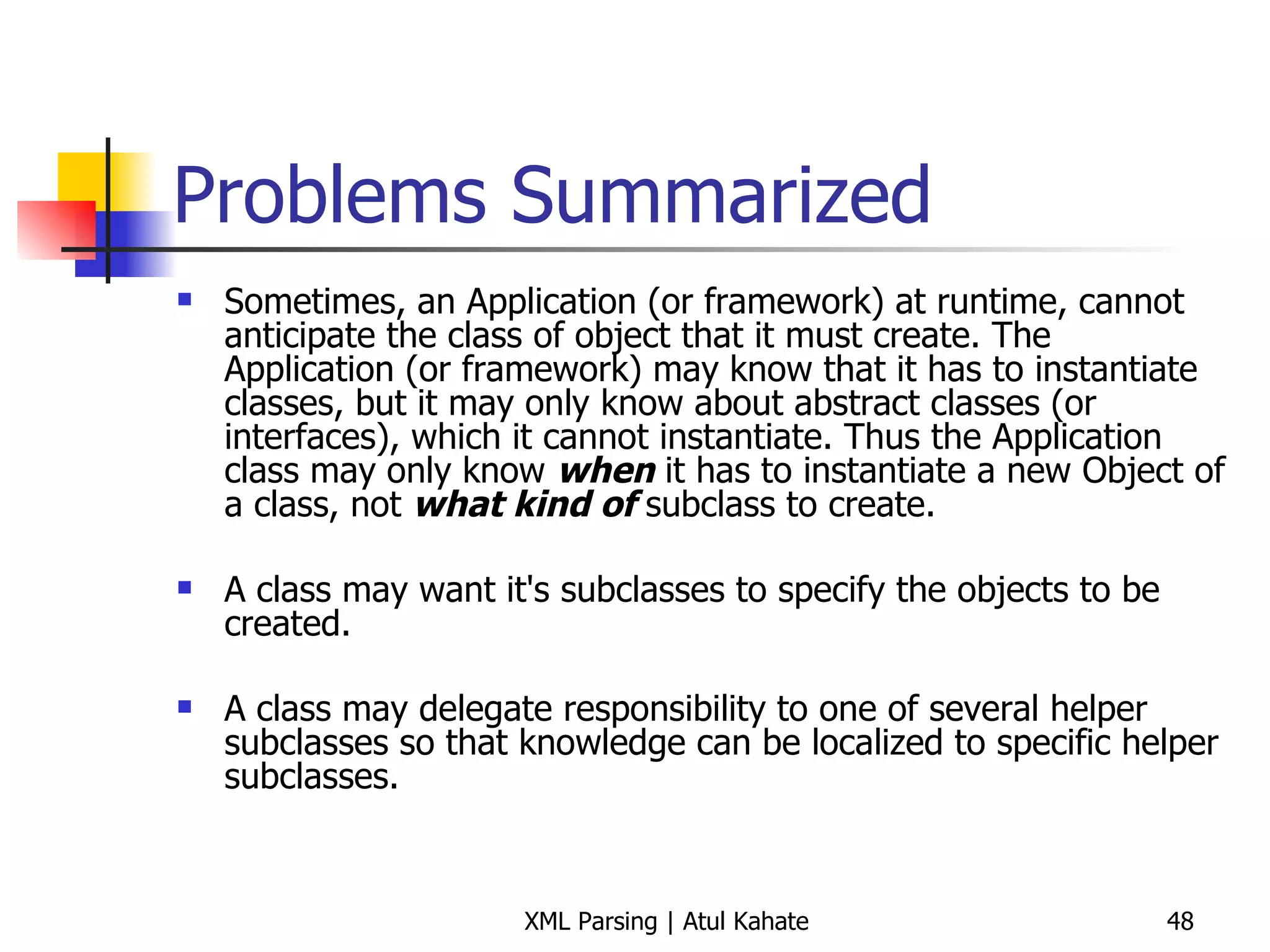
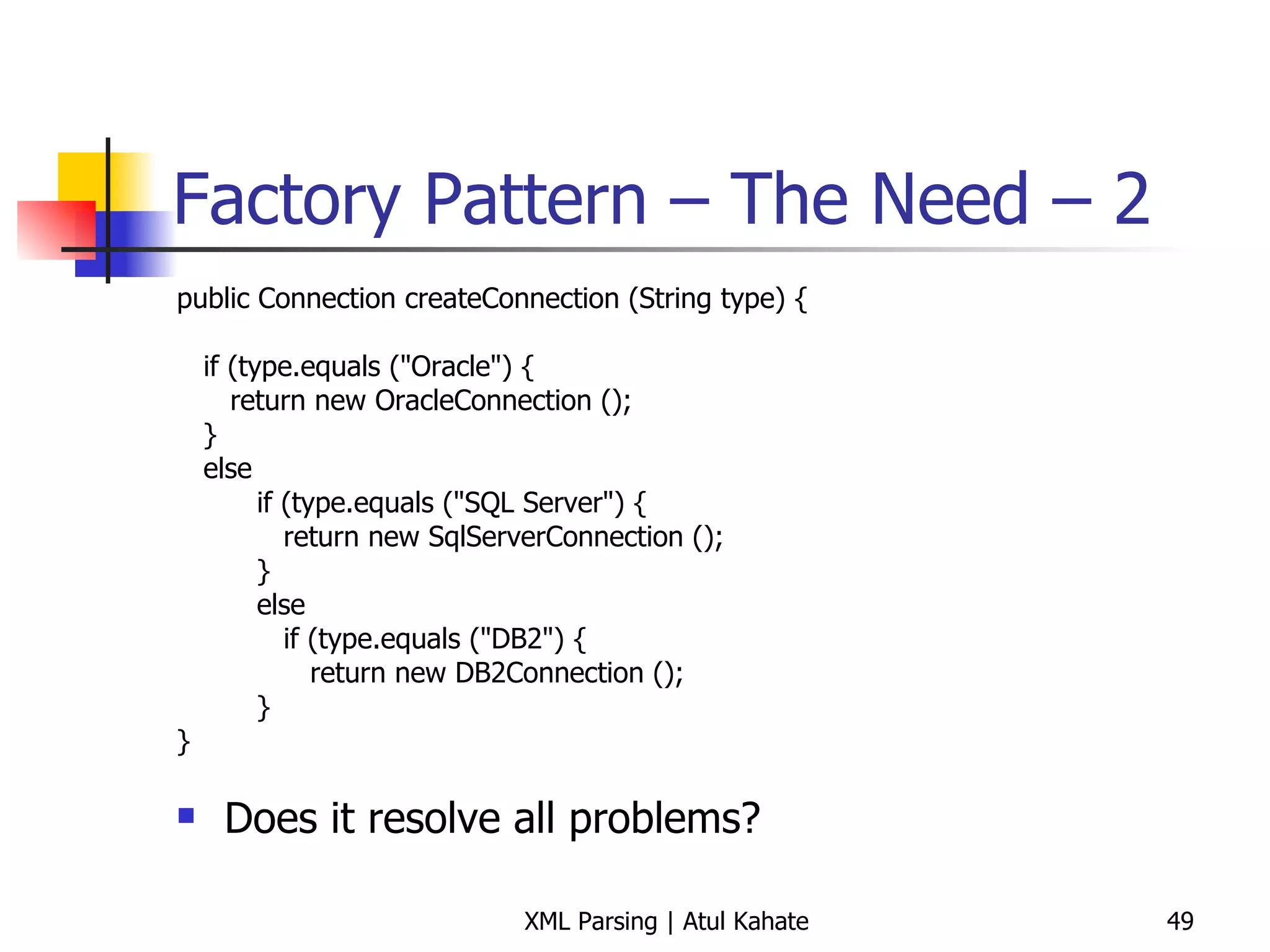
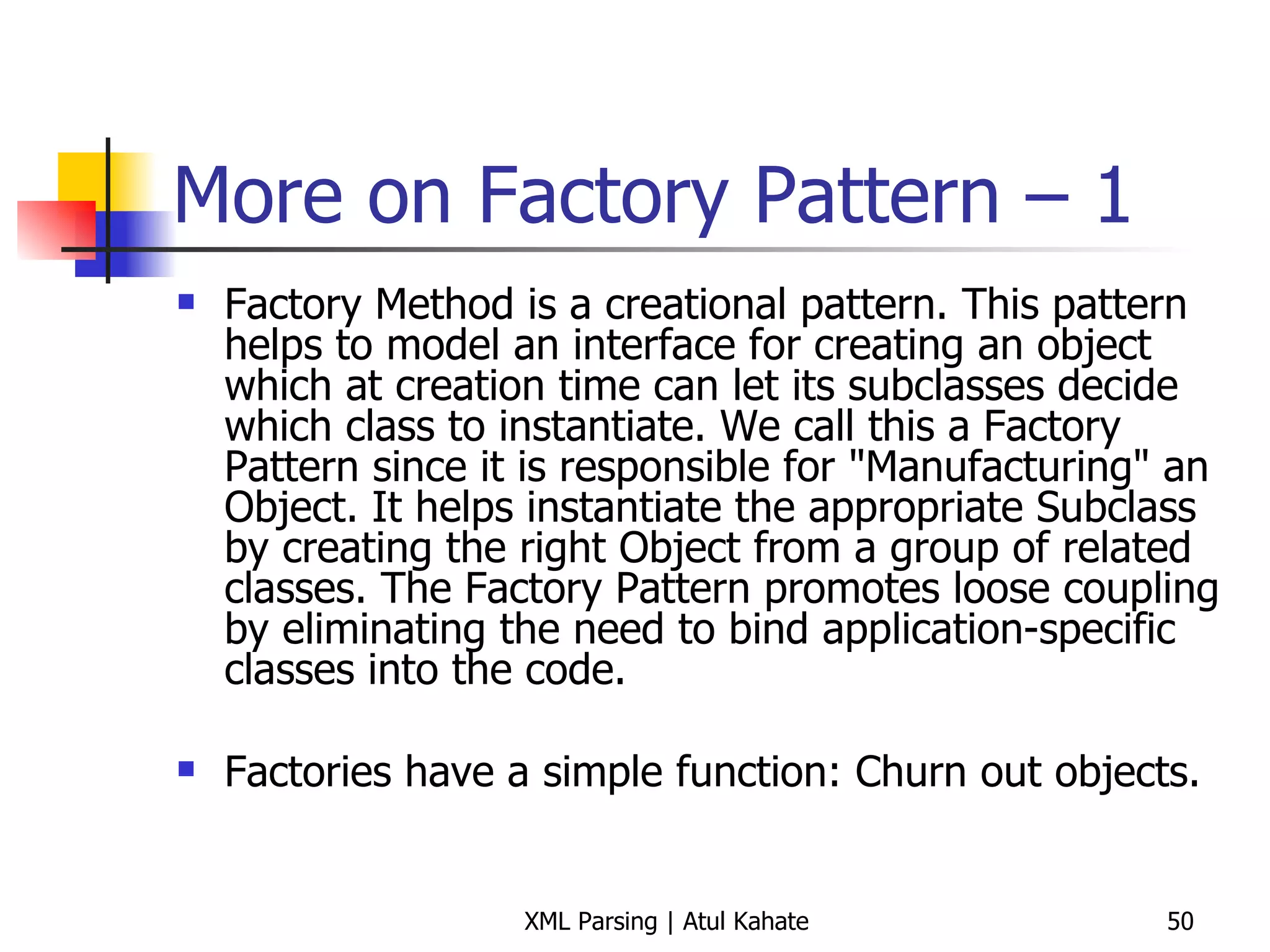
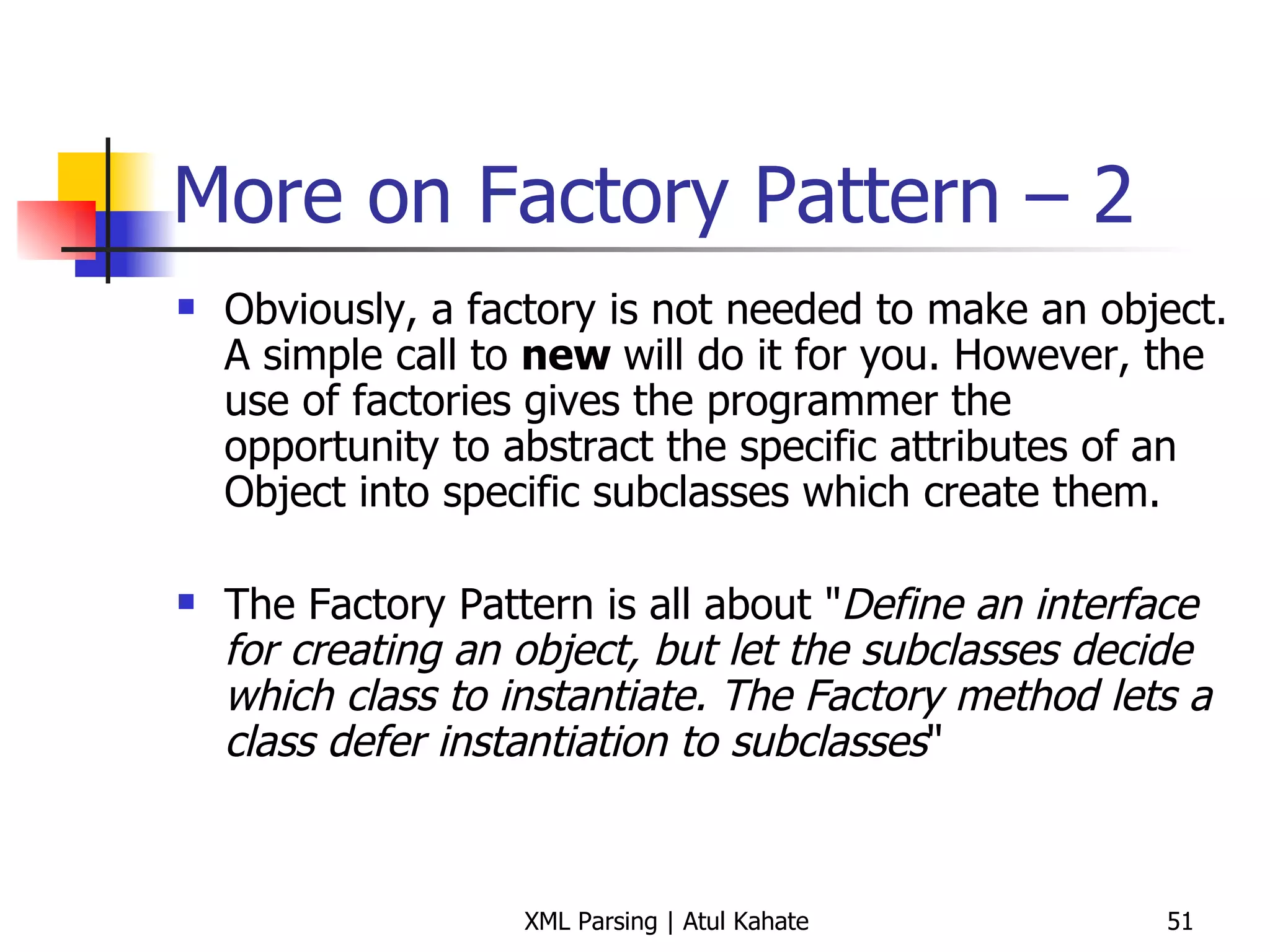
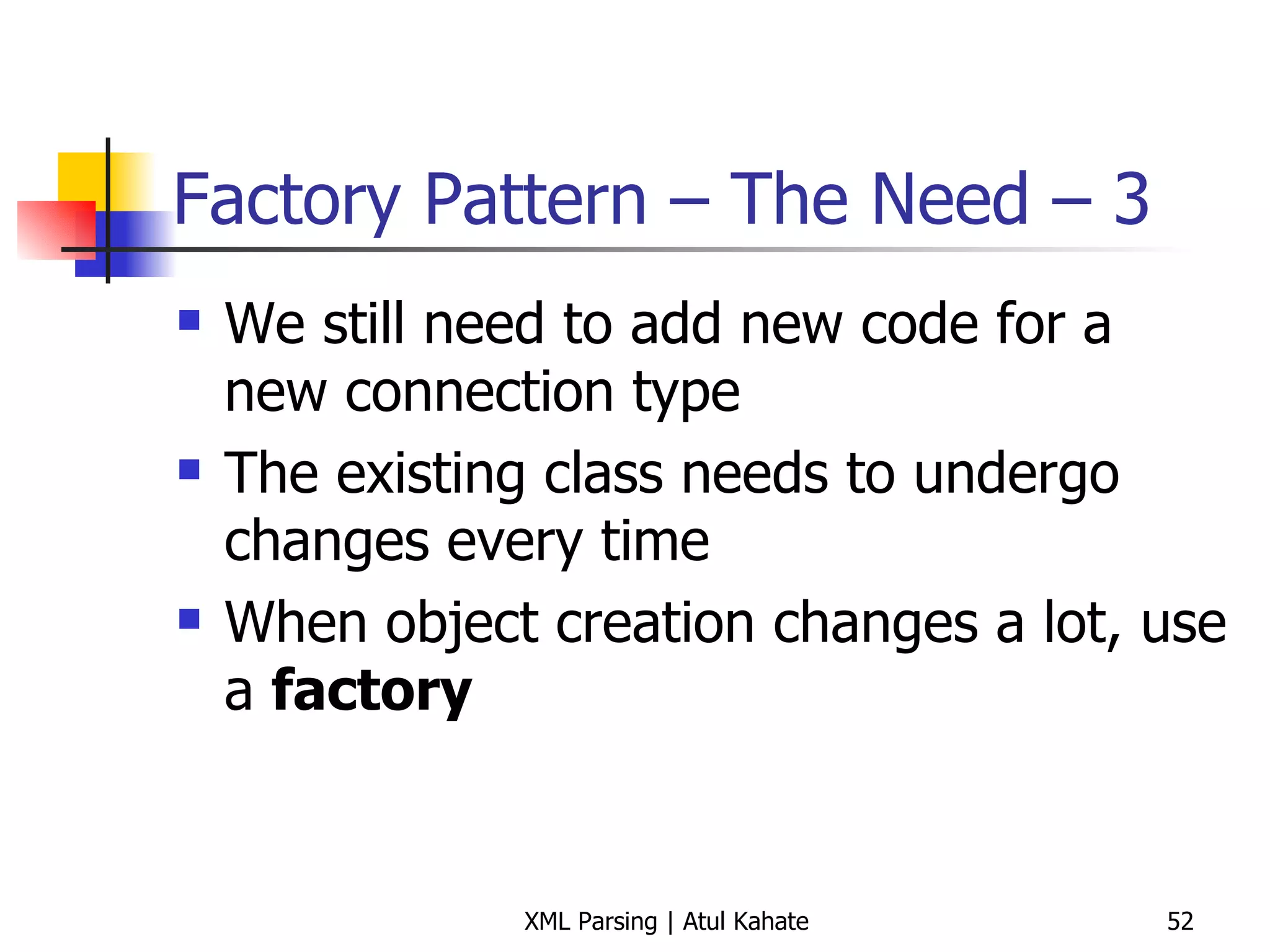
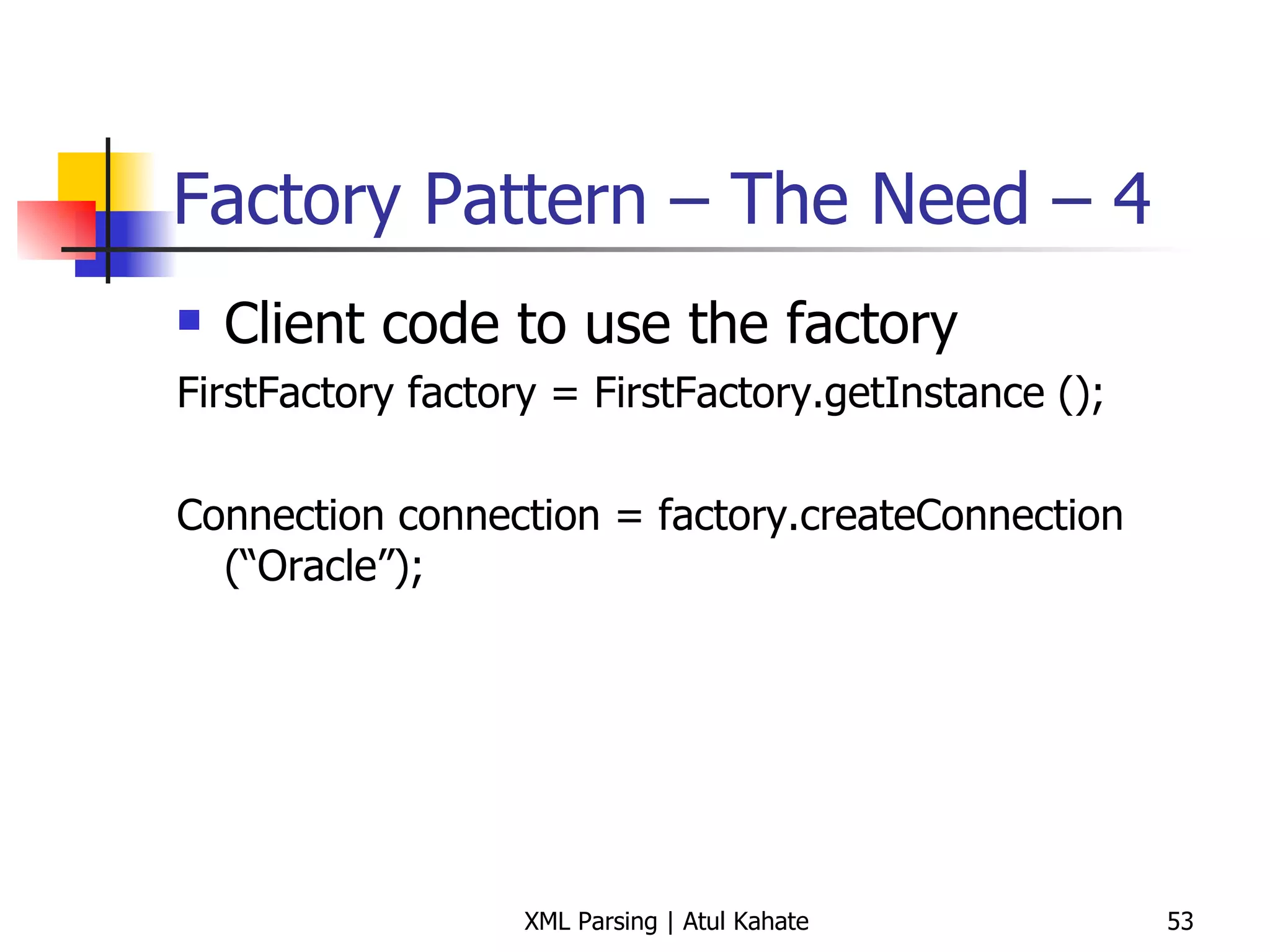
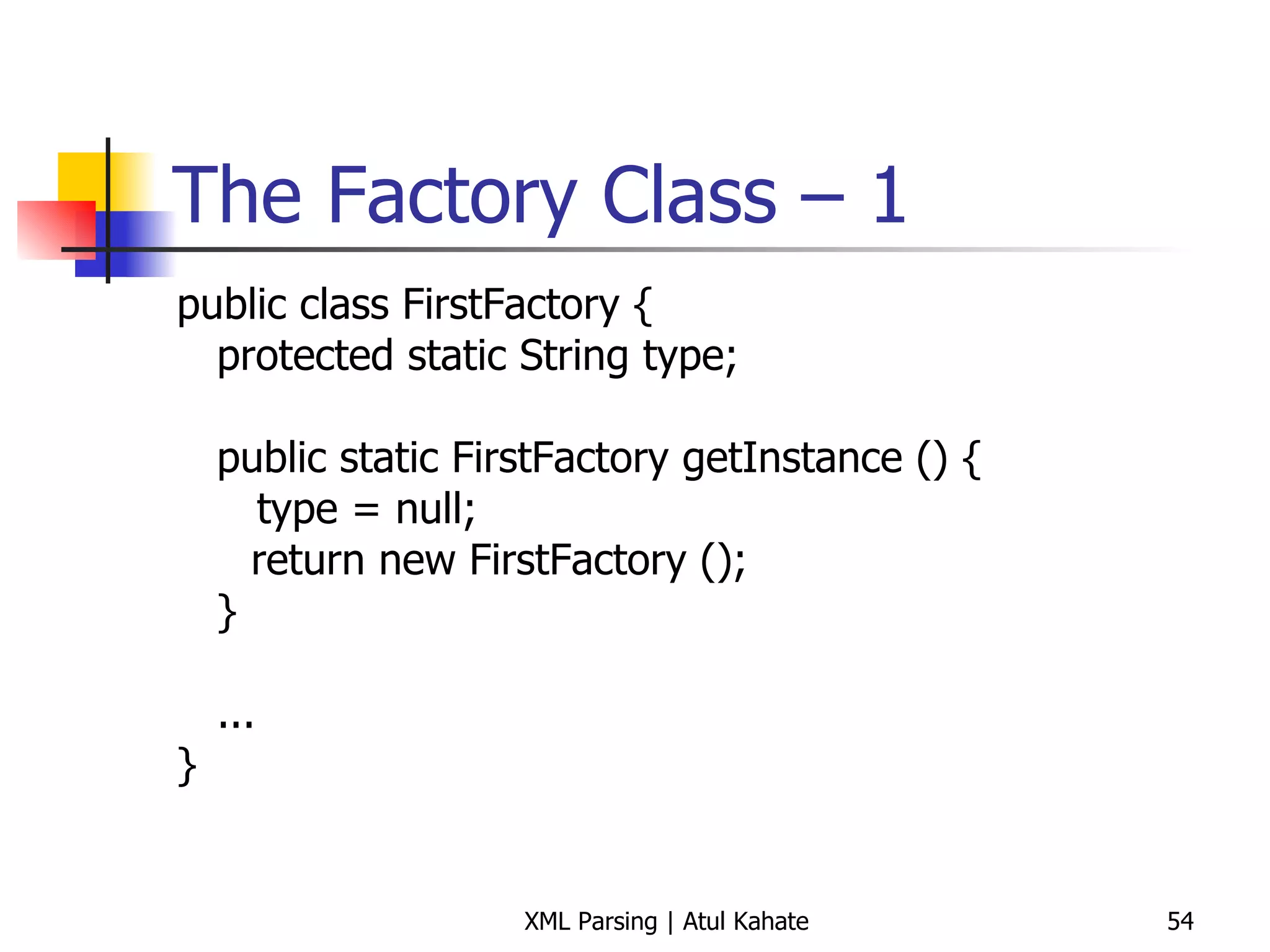
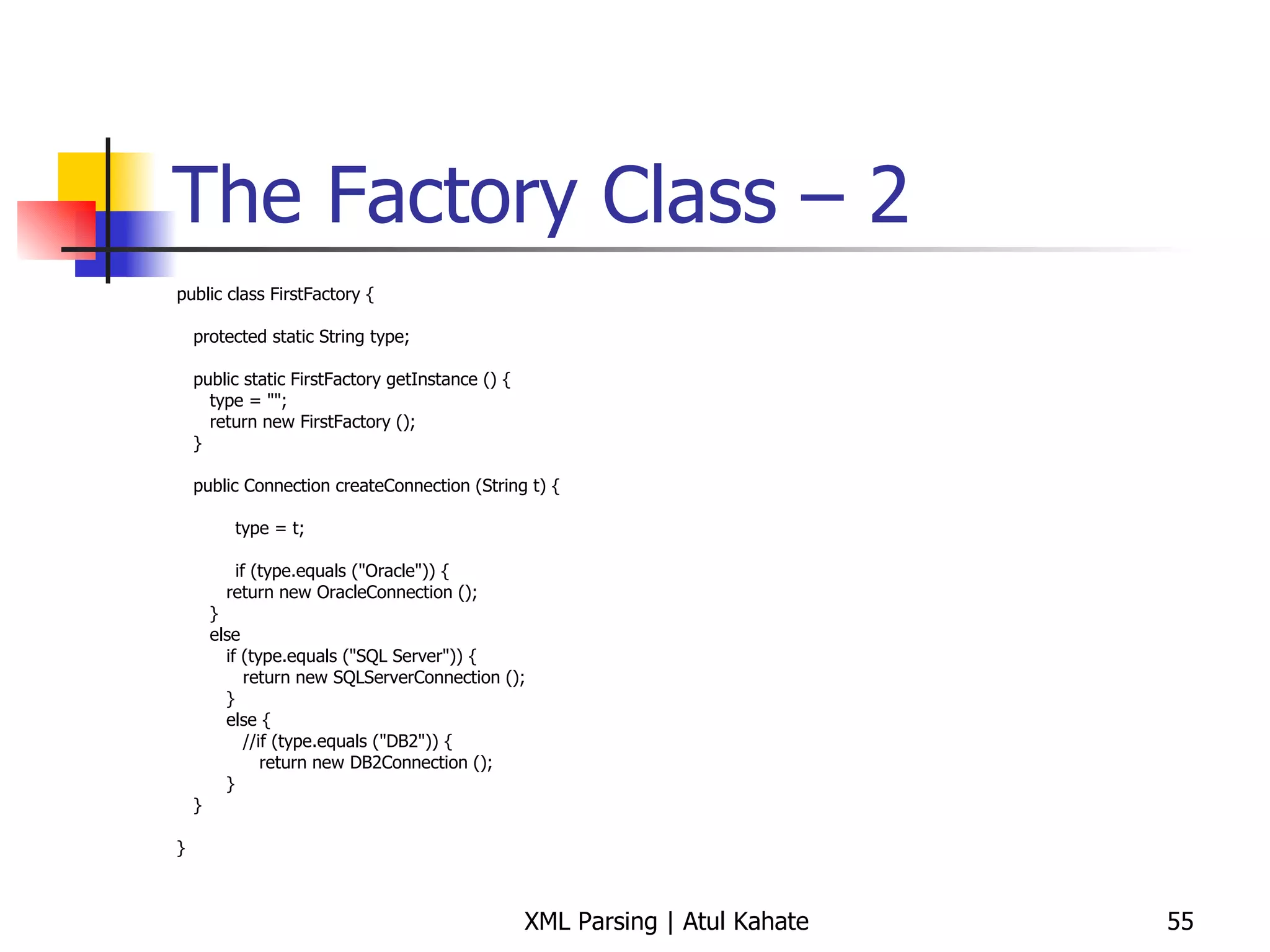
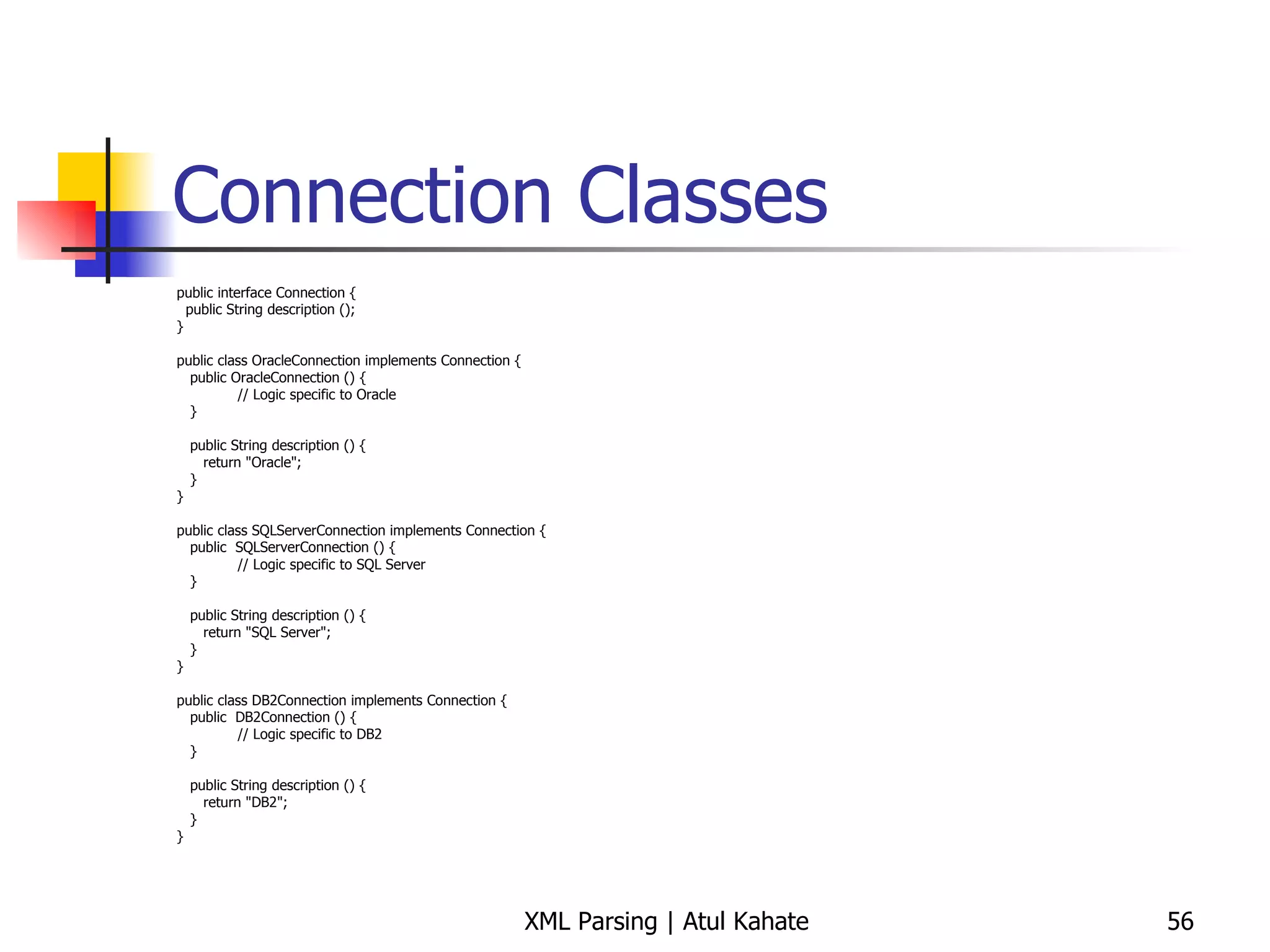
![Client Code public class TestConnection { public static void main (String args []) { FirstFactory factory = FirstFactory.getInstance (); Connection connection = factory.createConnection ("DB2"); System.out.println ("You are connected with " + connection.description ()); } }](https://image.slidesharecdn.com/6-xmlparsing-111212100111-phpapp02/75/6-xml-parsing-57-2048.jpg)

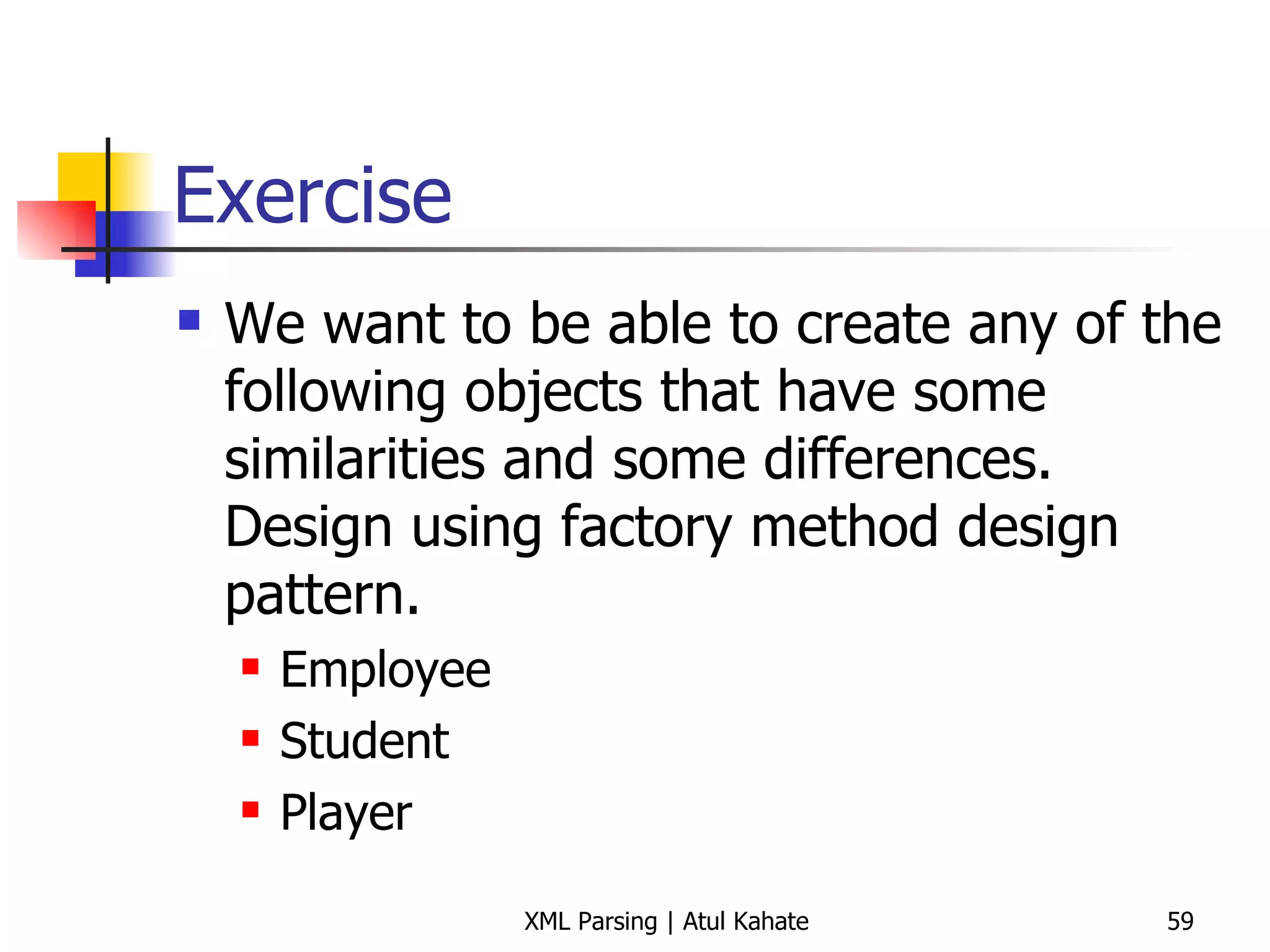

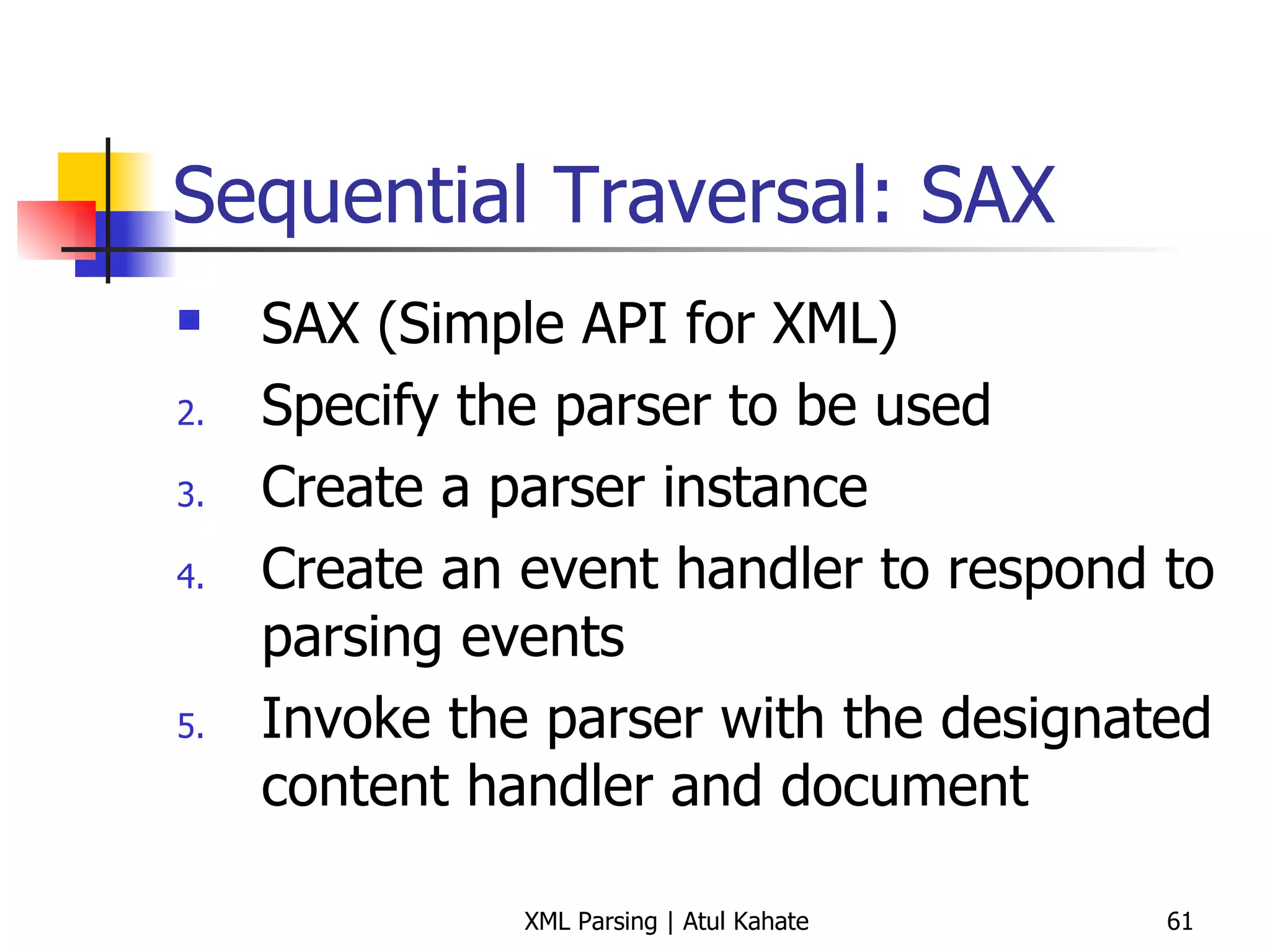
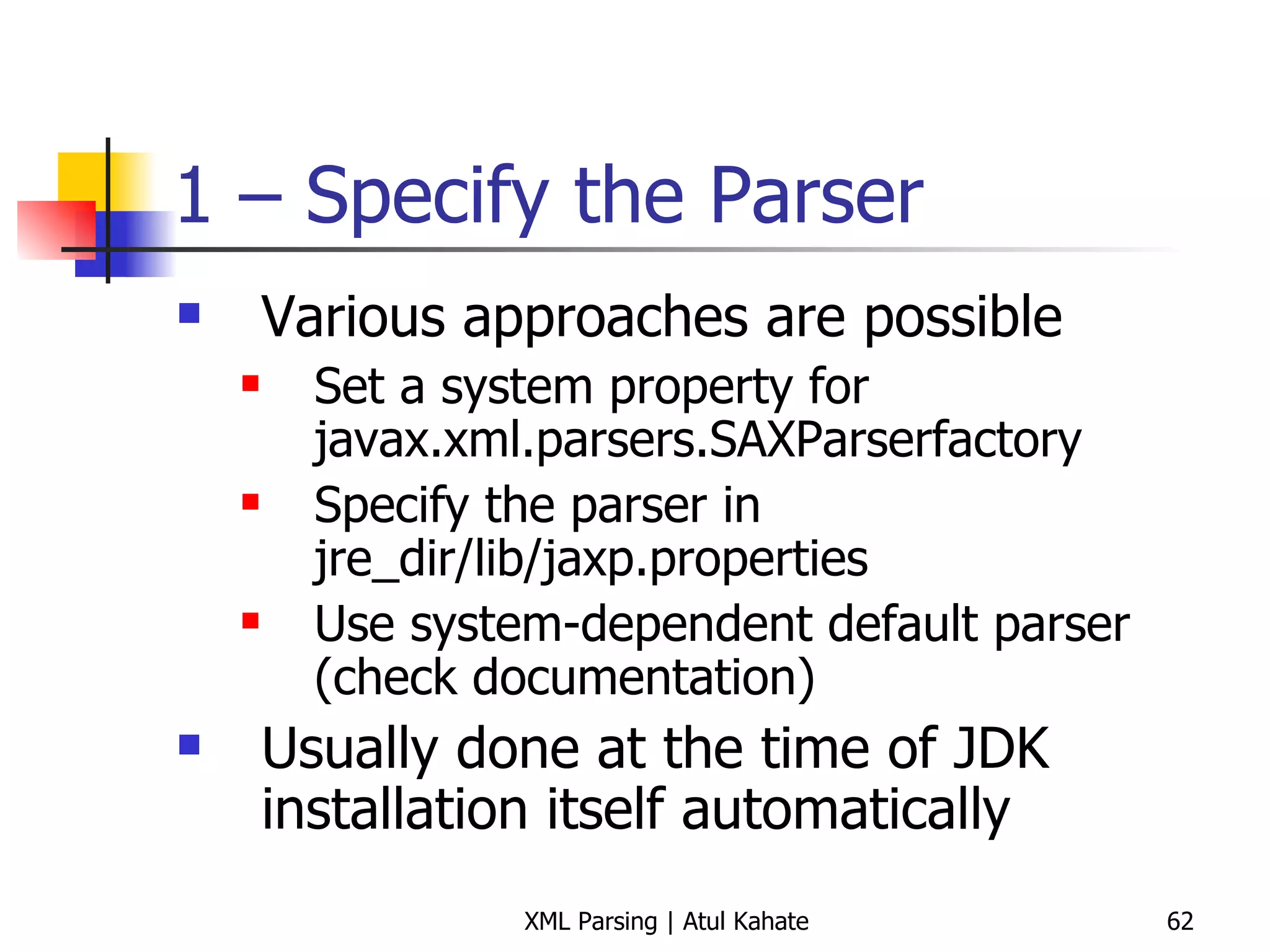
![1 – Specify the Parser Example Public static void main (String [] args) { String jaxpPropertyName = “javax.xml.parsers.SAXParserFactory”; … }](https://image.slidesharecdn.com/6-xmlparsing-111212100111-phpapp02/75/6-xml-parsing-63-2048.jpg)
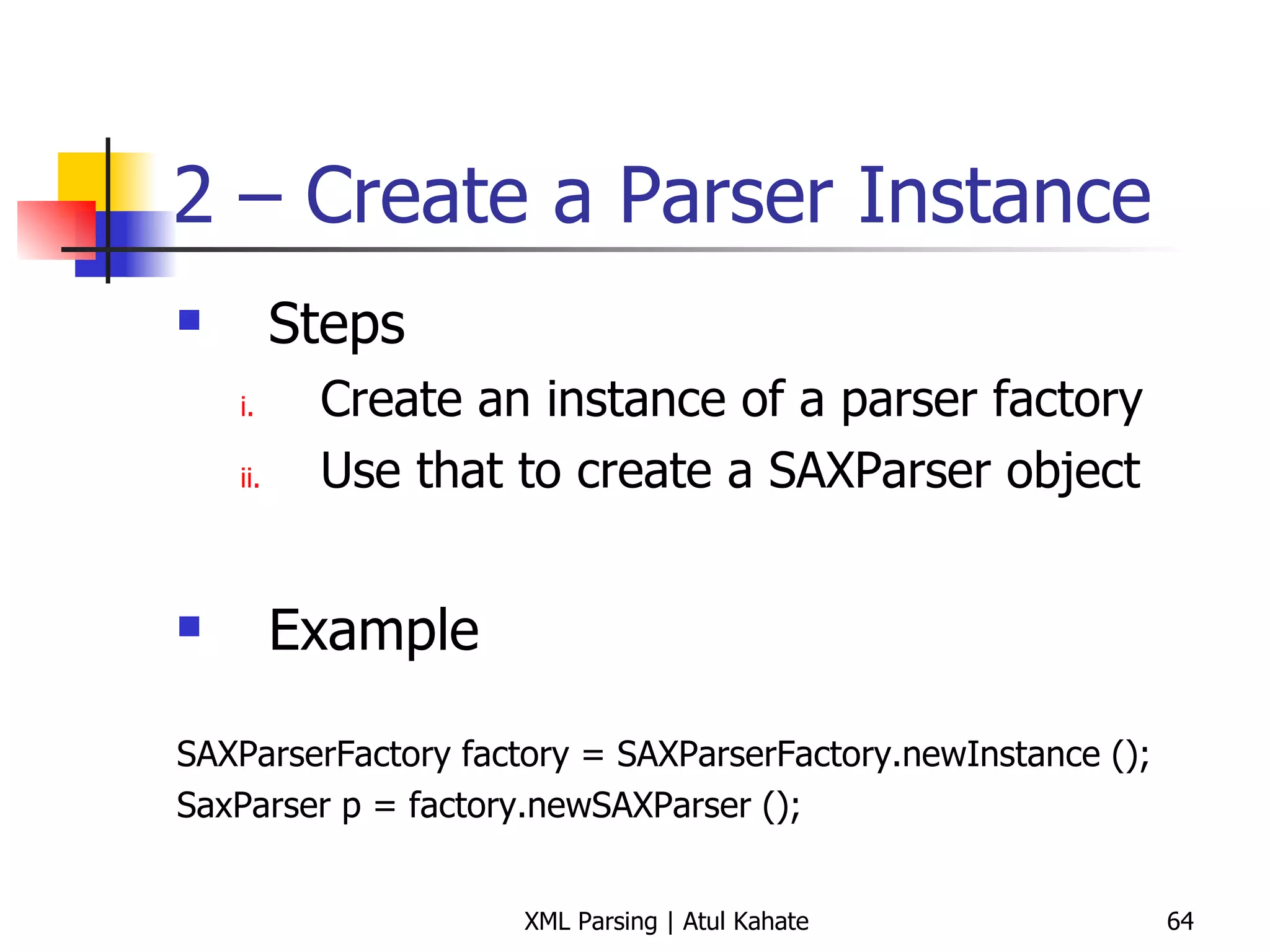
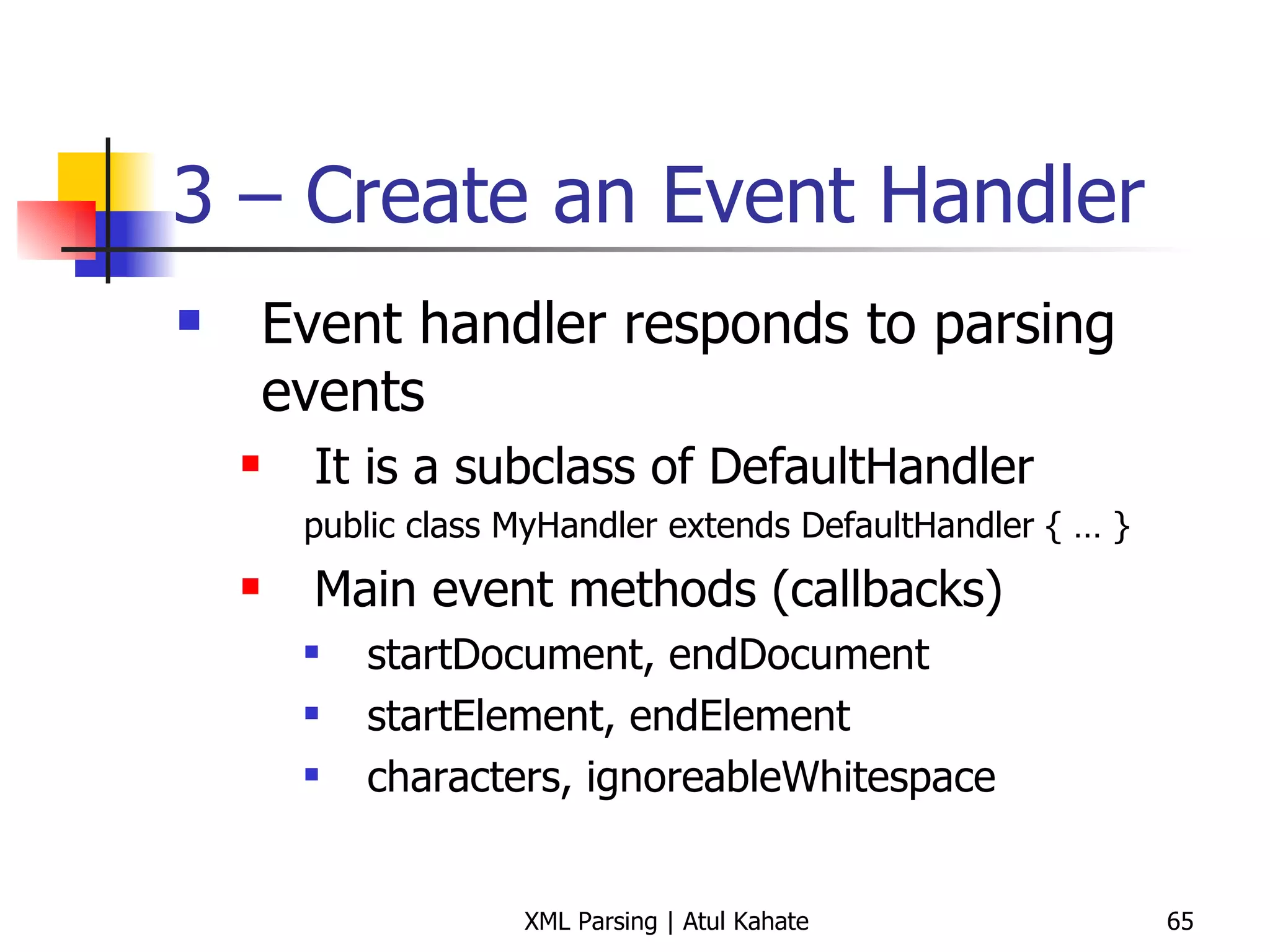
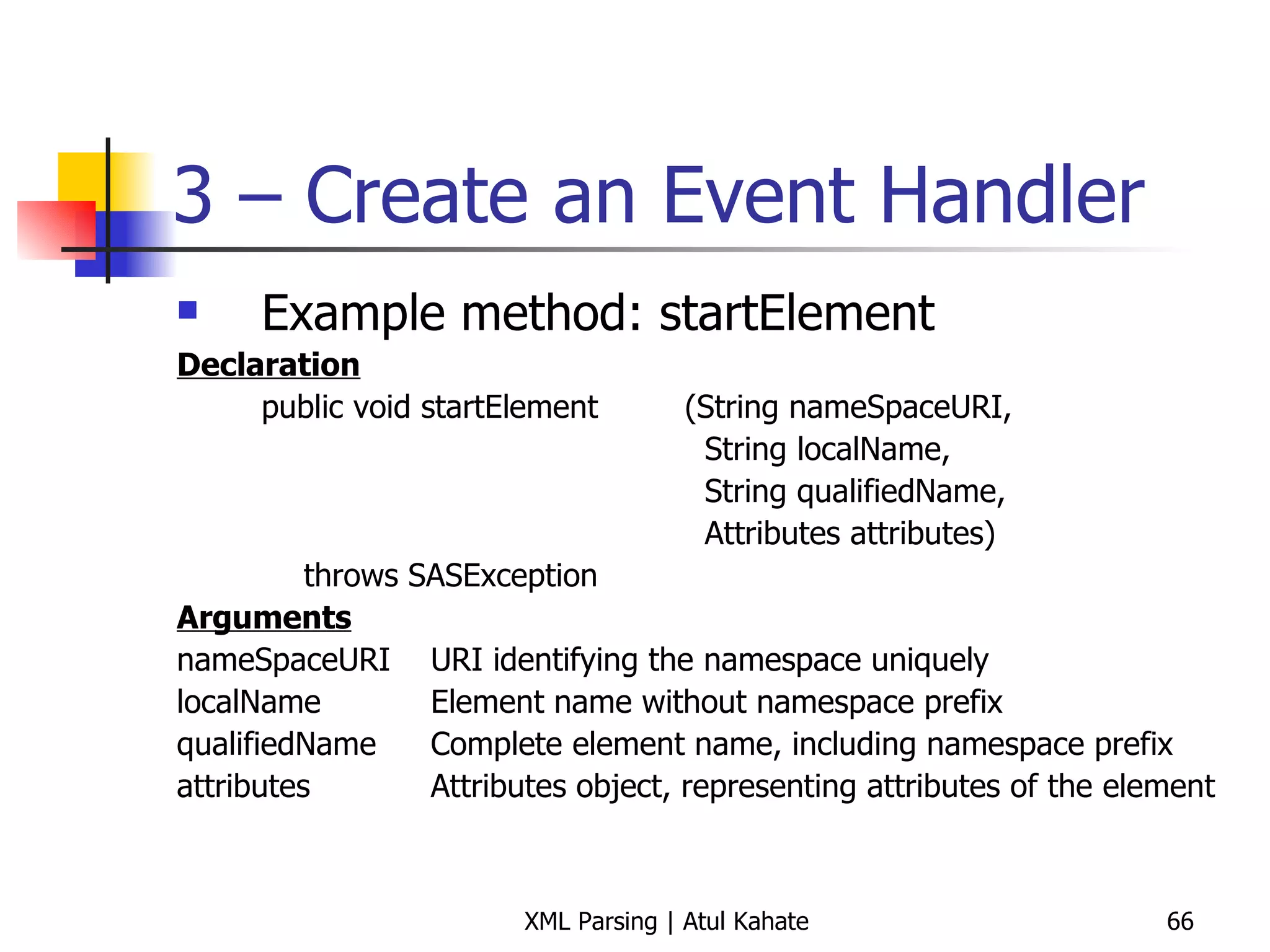
![3 – Create an Event Handler nameSpaceURI <cwp:book xmlns:cwp= “http://www.test.com/xml/”> qualifiedName attribute[1] < cwp:chapter number=“23” part=“Server programming” > <cwp: title > XML made easy </cwp:title> </cwp:chapter> localName </cwp:book>](https://image.slidesharecdn.com/6-xmlparsing-111212100111-phpapp02/75/6-xml-parsing-67-2048.jpg)
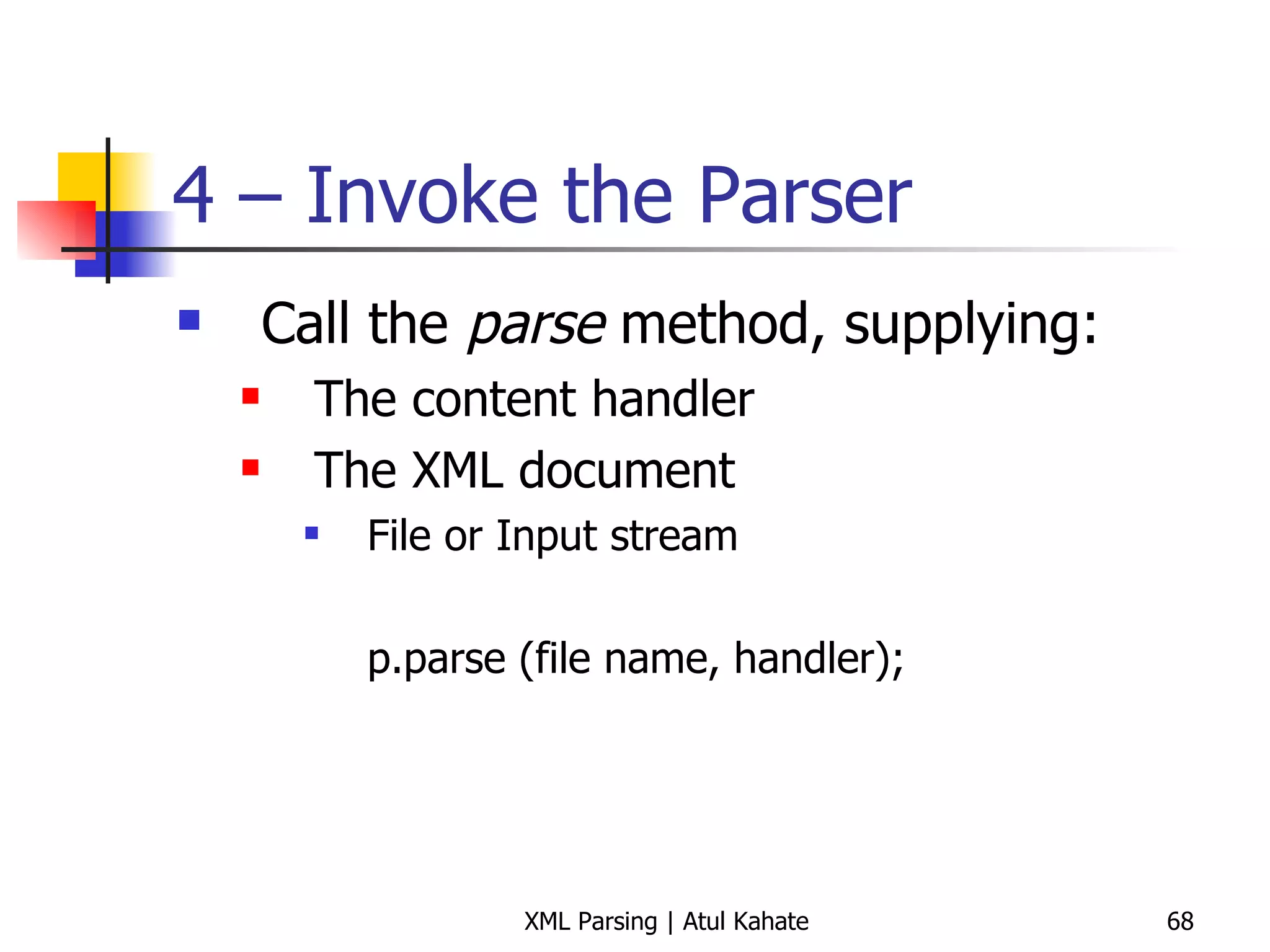
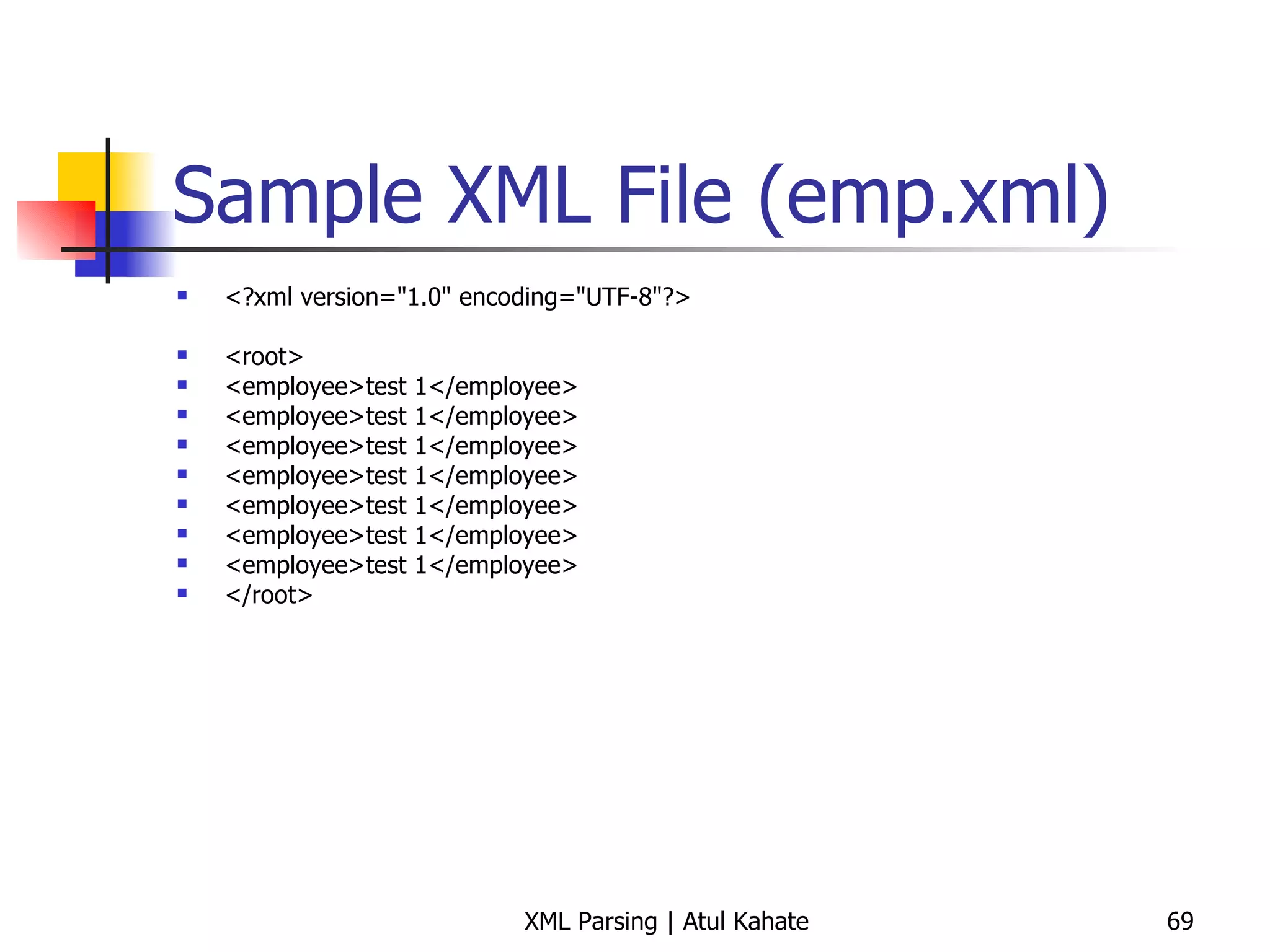
![Java Program to Count Total Number of Elements import javax.xml.parsers.SAXParser; import javax.xml.parsers.SAXParserFactory; import org.xml.sax.*; import org.xml.sax.helpers.DefaultHandler; public class SAXEmployeeCount extends DefaultHandler { int tagCount = 0; public void startElement (String uri, String localName, String rawName, Attributes attributes) { tagCount++; } public void endDocument() { System.out.println("There are " + tagCount + " elements."); } public static void main(String[] args) { SAXEmployeeCount handler = new SAXEmployeeCount (); try { SAXParserFactory spf = SAXParserFactory.newInstance (); SAXParser parser = spf.newSAXParser (); parser.parse("employee.xml", handler); } catch (Exception ex) { System.out.println(ex); } } }](https://image.slidesharecdn.com/6-xmlparsing-111212100111-phpapp02/75/6-xml-parsing-70-2048.jpg)
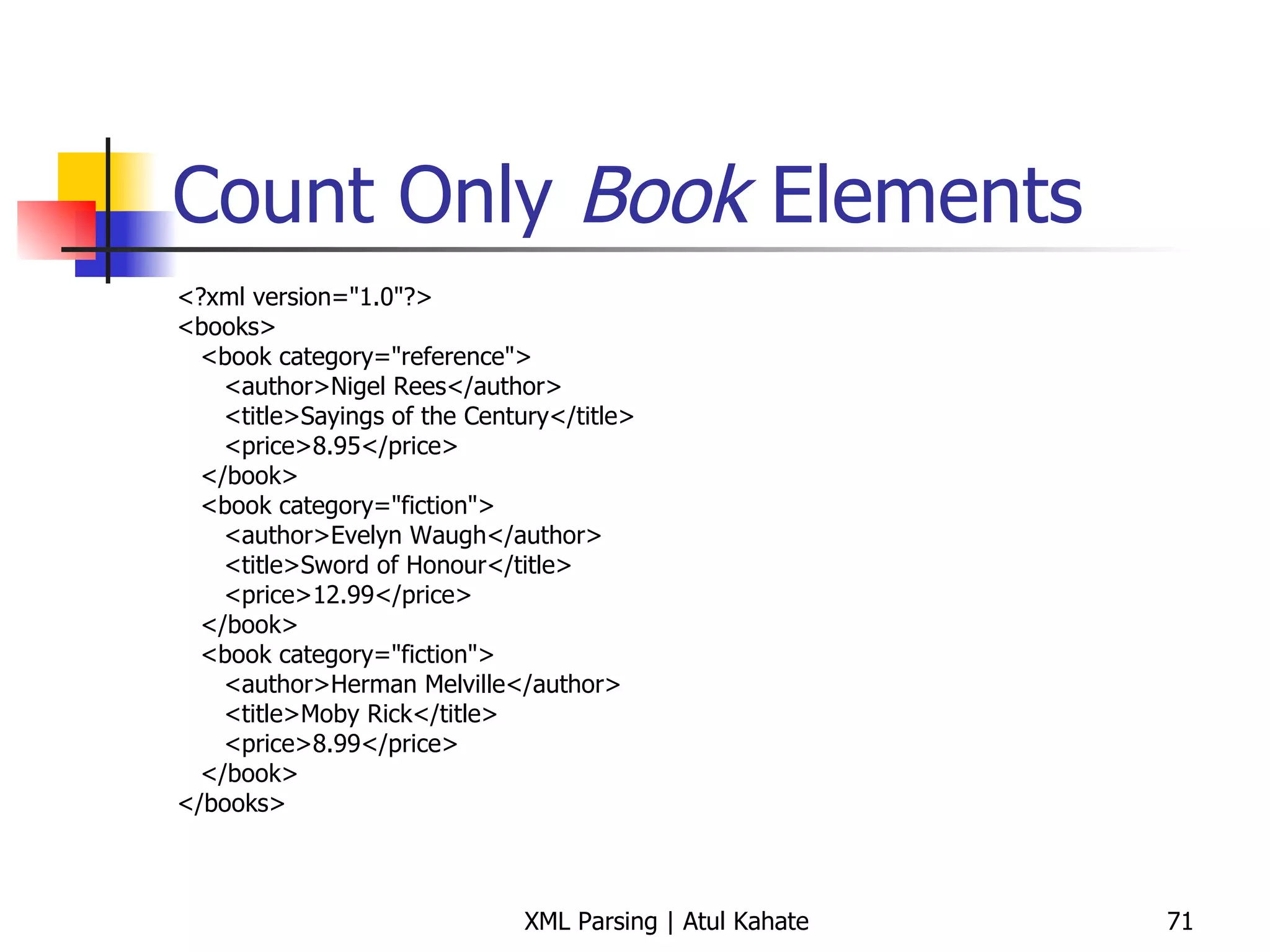
![Parsing Code in JAXP import java.io.IOException; import java.lang.*; import javax.xml.parsers.SAXParser; import javax.xml.parsers.SAXParserFactory; import org.xml.sax.Attributes; import org.xml.sax.Locator; import org.xml.sax.SAXException; import org.xml.sax.SAXNotRecognizedException; import org.xml.sax.SAXNotSupportedException; import org.xml.sax.SAXParseException; import org.xml.sax.XMLReader; import org.xml.sax.ext.LexicalHandler; import org.xml.sax.helpers.DefaultHandler; import org.xml.sax.helpers.ParserAdapter; import org.xml.sax.helpers.XMLReaderFactory; public class BookCount extends DefaultHandler{ private int count = 0; public void startDocument() throws SAXException { System.out.println("Start document ..."); } public void startElement(String uri, String local, String raw, Attributes attrs) throws SAXException { int year = 0; String attrValue; System.out.println ("Current element = " + raw); if (raw.equals ("book")) { count++; } } public void endDocument() throws SAXException { System.out.println("The total number of books = " + count); } public static void main (String[] args) throws Exception { BookCount handler = new BookCount (); try { SAXParserFactory spf = SAXParserFactory.newInstance (); SAXParser parser = spf.newSAXParser (); parser.parse ("book.xml", handler); } catch (SAXException e) { System.err.println(e.getMessage()); } } }](https://image.slidesharecdn.com/6-xmlparsing-111212100111-phpapp02/75/6-xml-parsing-72-2048.jpg)
![Specifying Parser Name import java.io.IOException; import javax.xml.parsers.SAXParser; import javax.xml.parsers.SAXParserFactory; import org.xml.sax.Attributes; import org.xml.sax.Locator; import org.xml.sax.SAXException; import org.xml.sax.SAXNotRecognizedException; import org.xml.sax.SAXNotSupportedException; import org.xml.sax.SAXParseException; import org.xml.sax.XMLReader; import org.xml.sax.ext.LexicalHandler; import org.xml.sax.helpers.DefaultHandler; import org.xml.sax.helpers.ParserAdapter; import org.xml.sax.helpers.XMLReaderFactory; public class SAXApp extends DefaultHandler{ // default parser to use protected static final String DEFAULT_PARSER_NAME = "org.apache.xerces.parsers.SAXParser"; private int count = 0; public void countTopics () throws IOException, SAXException { // create parser try { System.out.println ("Inside countTopics"); } catch (Exception e) { e.printStackTrace(System.err); } } public void startElement(String uri, String local, String raw, Attributes attrs) throws SAXException { if (raw.equals("topic")) count++; System.out.println (raw); } public void endDocument() throws SAXException { System.out.println("There are " + count + " topics"); } public static void main (String[] args) throws Exception{ System.out.println ("Inside main ..."); SAXApp handler = new SAXApp(); try { SAXParserFactory spf = SAXParserFactory.newInstance (); SAXParser parser = spf.newSAXParser (); parser.parse ("contents.xml", handler); } catch (SAXException e) { System.err.println(e.getMessage()); } } }](https://image.slidesharecdn.com/6-xmlparsing-111212100111-phpapp02/75/6-xml-parsing-73-2048.jpg)
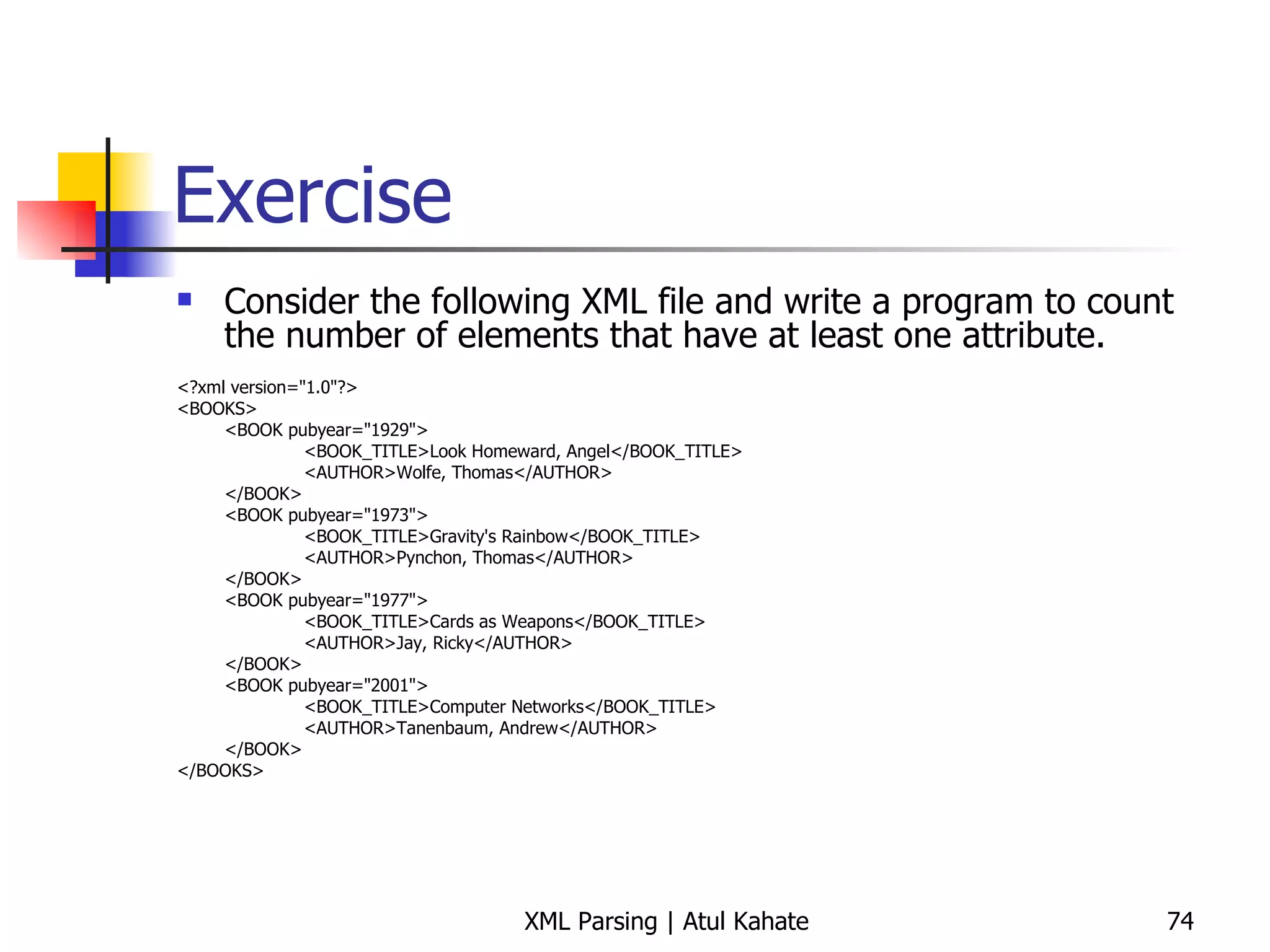
![Solution import java.io.IOException; import javax.xml.parsers.SAXParser; import javax.xml.parsers.SAXParserFactory; import org.xml.sax.Attributes; import org.xml.sax.Locator; import org.xml.sax.SAXException; import org.xml.sax.SAXNotRecognizedException; import org.xml.sax.SAXNotSupportedException; import org.xml.sax.SAXParseException; import org.xml.sax.XMLReader; import org.xml.sax.ext.LexicalHandler; import org.xml.sax.helpers.DefaultHandler; import org.xml.sax.helpers.ParserAdapter; import org.xml.sax.helpers.XMLReaderFactory; public class countAttr extends DefaultHandler{ private int count = 0; public void startDocument() throws SAXException { System.out.println("Start document ..."); } public void startElement(String uri, String local, String raw, Attributes attrs) throws SAXException { System.out.println ("Current element = " + raw); if (attrs.getLength () != 0) { count++; } } public void endDocument() throws SAXException { System.out.println("The total number of attributes = " + count); } public static void main (String[] args) throws Exception { countAttr handler = new countAttr (); try { SAXParserFactory spf = SAXParserFactory.newInstance (); SAXParser parser = spf.newSAXParser (); parser.parse ("countAttr.xml", handler); } catch (SAXException e) { System.err.println(e.getMessage()); } } }](https://image.slidesharecdn.com/6-xmlparsing-111212100111-phpapp02/75/6-xml-parsing-75-2048.jpg)
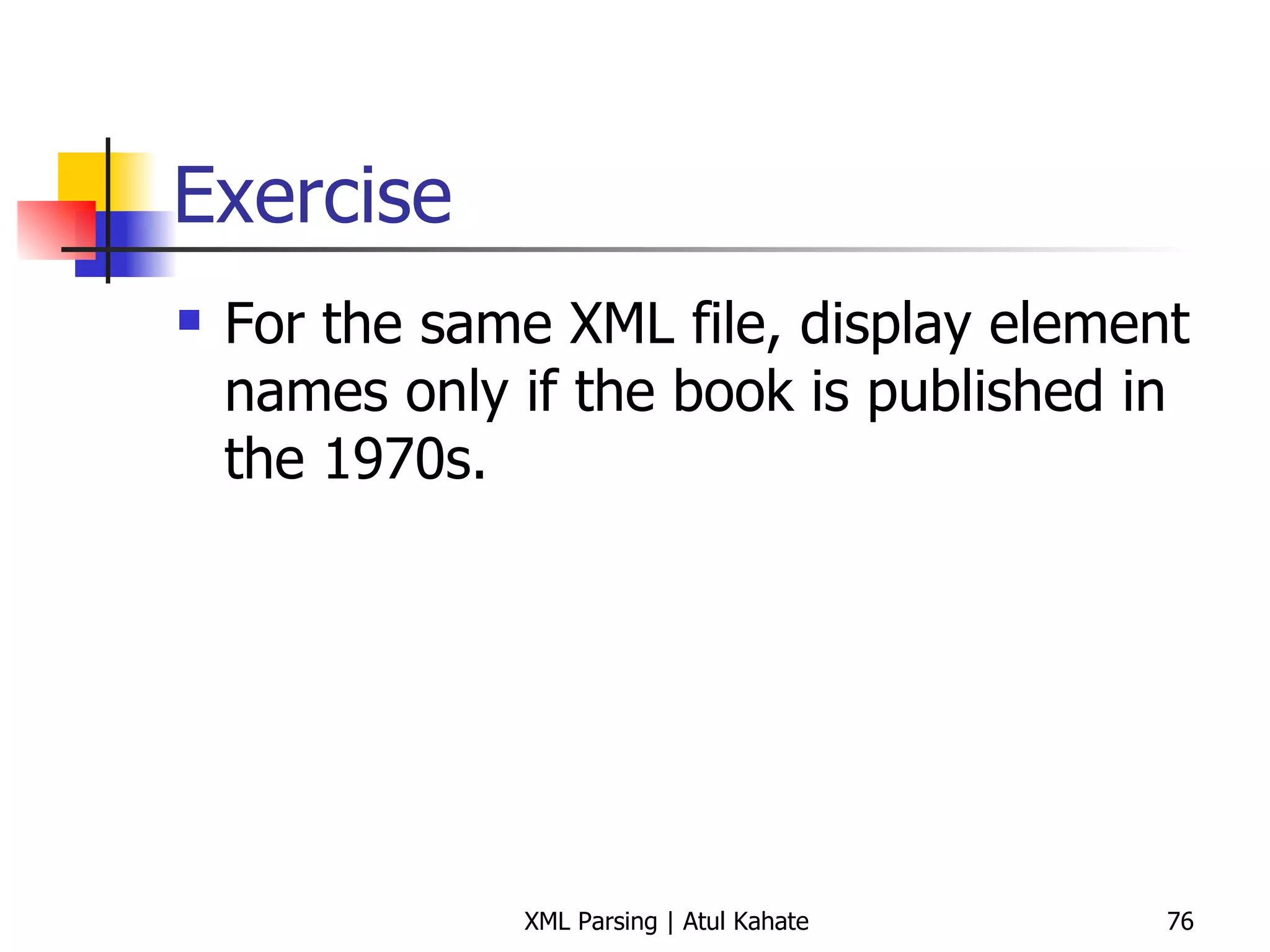
![Solution import java.io.IOException; import java.lang.*; import javax.xml.parsers.SAXParser; import javax.xml.parsers.SAXParserFactory; import org.xml.sax.Attributes; import org.xml.sax.Locator; import org.xml.sax.SAXException; import org.xml.sax.SAXNotRecognizedException; import org.xml.sax.SAXNotSupportedException; import org.xml.sax.SAXParseException; import org.xml.sax.XMLReader; import org.xml.sax.ext.LexicalHandler; import org.xml.sax.helpers.DefaultHandler; import org.xml.sax.helpers.ParserAdapter; import org.xml.sax.helpers.XMLReaderFactory; public class seventiesBooks extends DefaultHandler{ private int count = 0; public void startDocument() throws SAXException { System.out.println("Start document ..."); } public void startElement(String uri, String local, String raw, Attributes attrs) throws SAXException { int year = 0; String attrValue; System.out.println ("Current element = " + raw); if (attrs.getLength () > 0) { attrValue = attrs.getValue (0); year = Integer.parseInt (attrValue); if (year < 1970) { count++; } } } public void endDocument() throws SAXException { System.out.println("The total number of matching elements = " + count); } public static void main (String[] args) throws Exception { seventiesBooks handler = new seventiesBooks(); try { SAXParserFactory spf = SAXParserFactory.newInstance (); SAXParser parser = spf.newSAXParser (); parser.parse ("countAttr.xml", handler); } catch (SAXException e) { System.err.println(e.getMessage()); } } }](https://image.slidesharecdn.com/6-xmlparsing-111212100111-phpapp02/75/6-xml-parsing-77-2048.jpg)
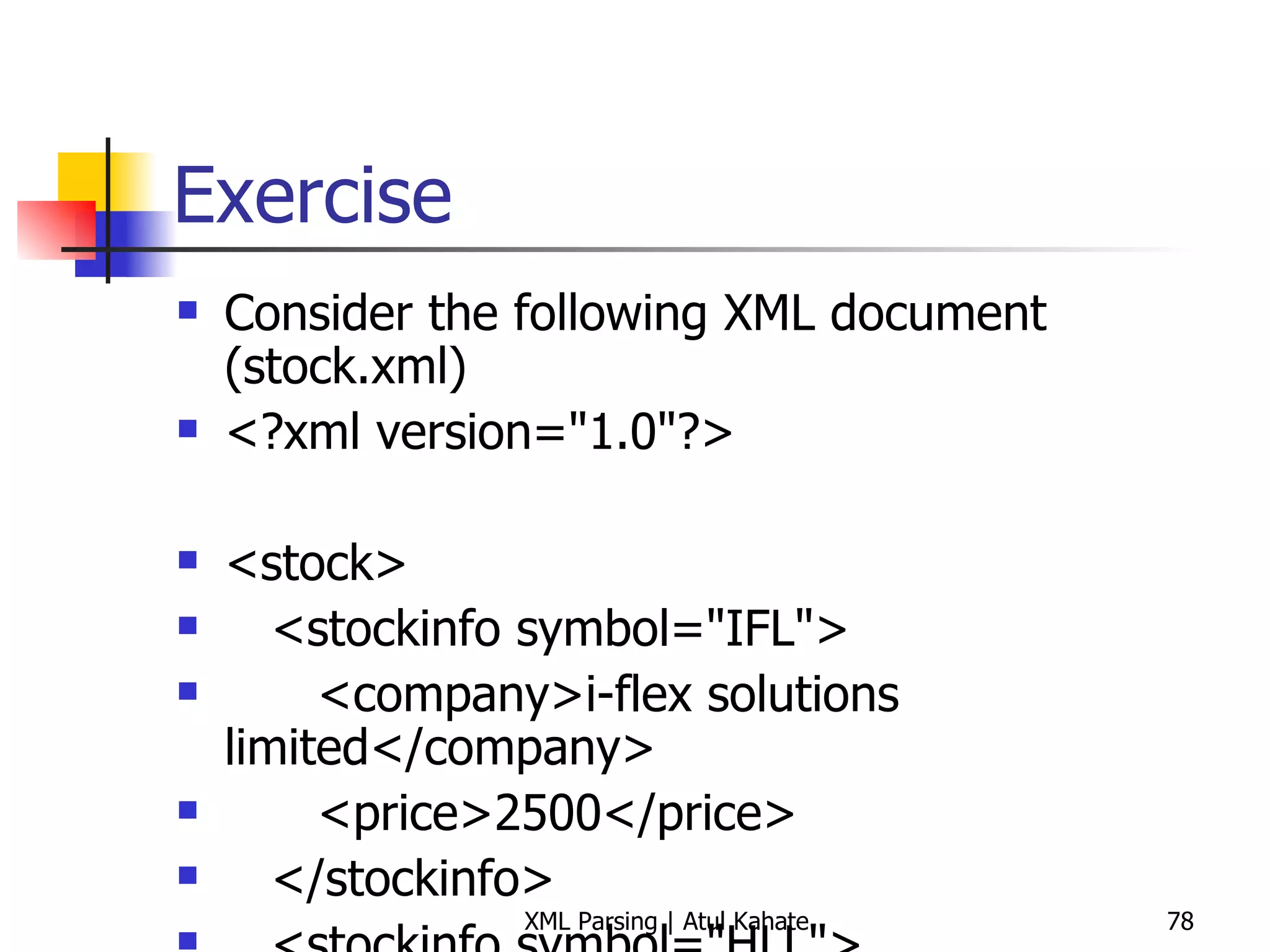
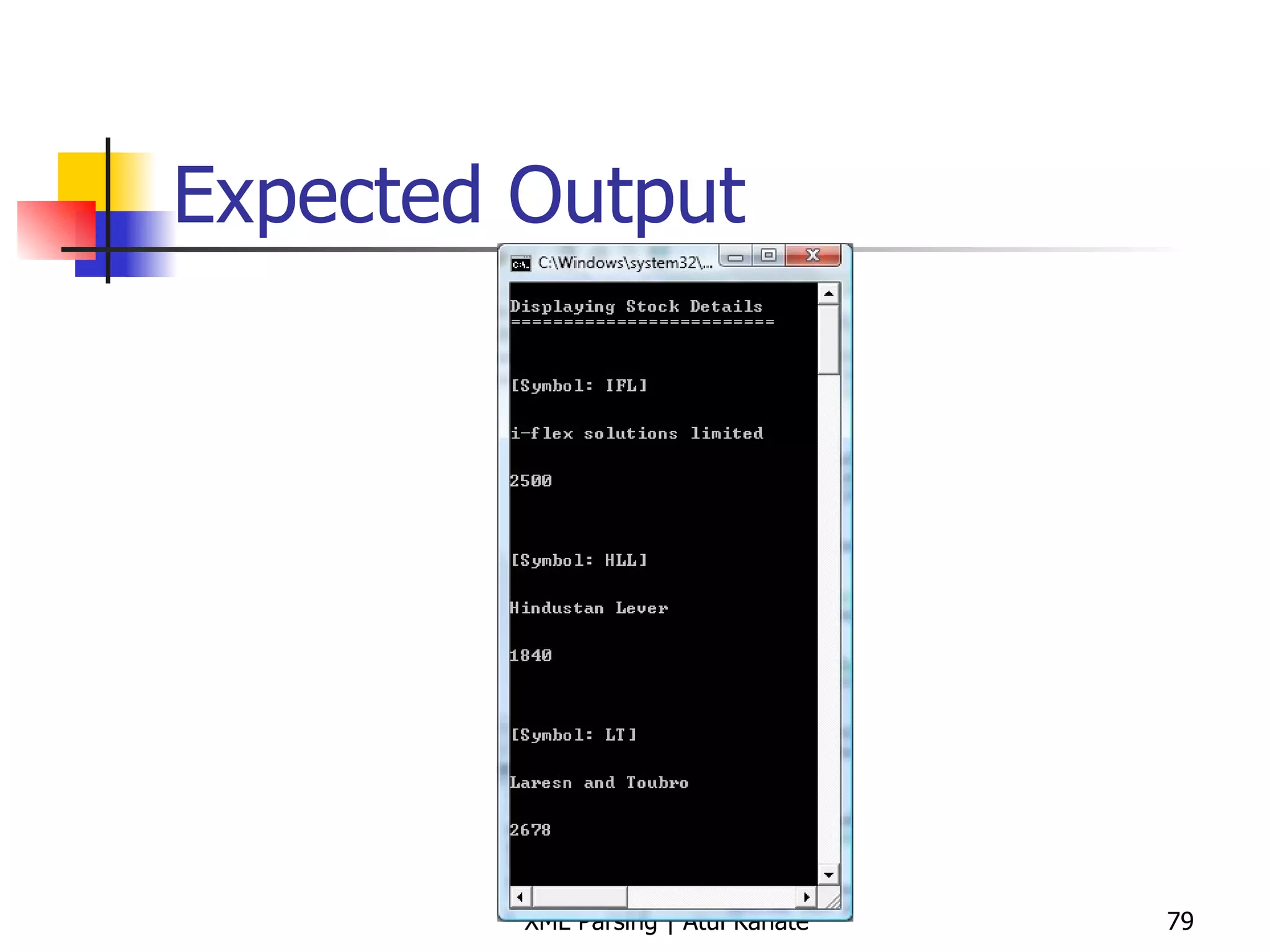
![Solution import java.io.*; import org.xml.sax.*; import org.xml.sax.helpers.*; import javax.xml.parsers.*; public class DisplayStockDetails extends DefaultHandler { public void startDocument () throws SAXException { System.out.println ("\nDisplaying Stock Details"); System.out.println ("=========================\n"); } public void endDocument () throws SAXException { System.out.println ("\nEnd of Details"); System.out.println ("==============\n"); } public void startElement (String uri, String local, String raw, Attributes attrs) throws SAXException { // Skip processing root element if (local.equals ("stock")) return; // Skip processing if there are no attributes if (attrs == null) return; for (int i=0; i<attrs.getLength (); i++) { System.out.println ("[Symbol: " + attrs.getValue (i) + "]"); } } public void endElement (String uri, String local, String raw) throws SAXException { // System.out.println (); } public void characters (char[] ch, int start, int length) throws SAXException { System.out.println (new String (ch, start, length)); } public static void main (String[] args) throws Exception { DisplayStockDetails handler = new DisplayStockDetails (); try { SAXParserFactory spf = SAXParserFactory.newInstance (); SAXParser parser = spf.newSAXParser (); parser.parse ("stock.xml", handler); } catch (SAXException e) { System.err.println(e.getMessage()); } } }](https://image.slidesharecdn.com/6-xmlparsing-111212100111-phpapp02/75/6-xml-parsing-80-2048.jpg)
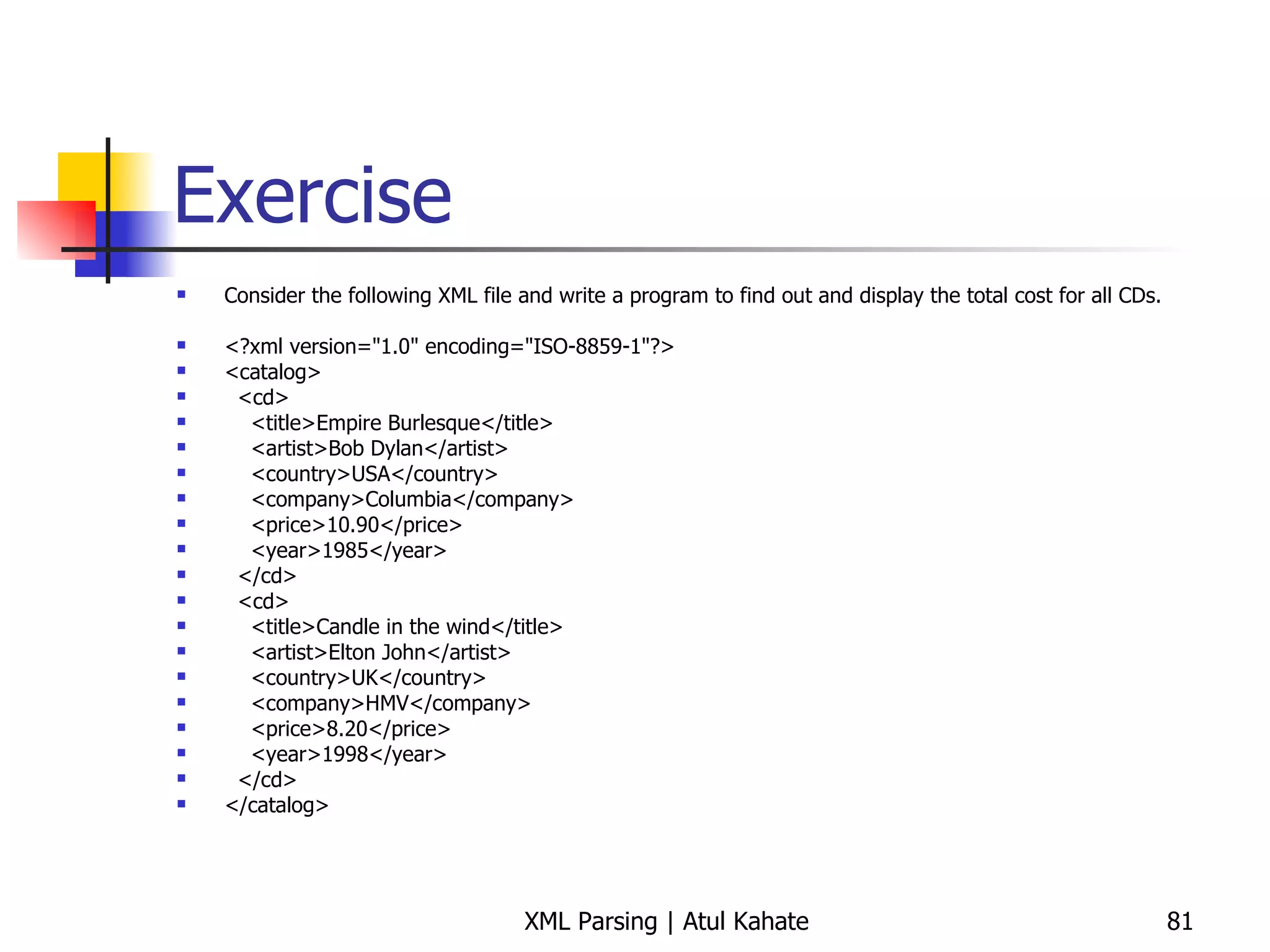
![Solution import java.io.IOException; import java.lang.*; import javax.xml.parsers.SAXParser; import javax.xml.parsers.SAXParserFactory; import org.xml.sax.Attributes; import org.xml.sax.Locator; import org.xml.sax.SAXException; import org.xml.sax.SAXNotRecognizedException; import org.xml.sax.SAXNotSupportedException; import org.xml.sax.SAXParseException; import org.xml.sax.XMLReader; import org.xml.sax.ext.LexicalHandler; import org.xml.sax.helpers.DefaultHandler; import org.xml.sax.helpers.ParserAdapter; import org.xml.sax.helpers.XMLReaderFactory; public class CDPrice extends DefaultHandler{ private int count = 0, total = 0; private boolean flagIsAvailable = false, flagIsCurrentElementPrice = false; public void startDocument() throws SAXException { System.out.println("Start document ..."); } public void startElement(String uri, String local, String raw, Attributes attrs) throws SAXException { int year = 0; String attrValue; System.out.println ("Current element = " + raw); if (raw.equals ("price")) { flagIsCurrentElementPrice = true; System.out.println ("INSIDE if of startElement ==="); } } public void characters (char [] ch, int start, int len) throws SAXException { if (flagIsCurrentElementPrice) { System.out.println ("ch = " + ch); System.out.println ("start = " + start); System.out.println ("len = " + len); StringBuffer buffer = new StringBuffer (); for (int i=0; i<len; i++) { buffer.append (ch[start+i]); } System.out.println ("*** buffer = " + buffer + " ***"); String str = buffer.substring (0); int uprice = Integer.parseInt(str); total += uprice; flagIsCurrentElementPrice = false; System.out.println ("Current total = " + total); } } public void endDocument() throws SAXException { System.out.println("The total price of available CDs = " + total); } public static void main (String[] args) throws Exception { CDPrice handler = new CDPrice(); try { SAXParserFactory spf = SAXParserFactory.newInstance (); SAXParser parser = spf.newSAXParser (); parser.parse ("cdcatalog2.xml", handler); } catch (SAXException e) { System.err.println(e.getMessage()); } } }](https://image.slidesharecdn.com/6-xmlparsing-111212100111-phpapp02/75/6-xml-parsing-82-2048.jpg)
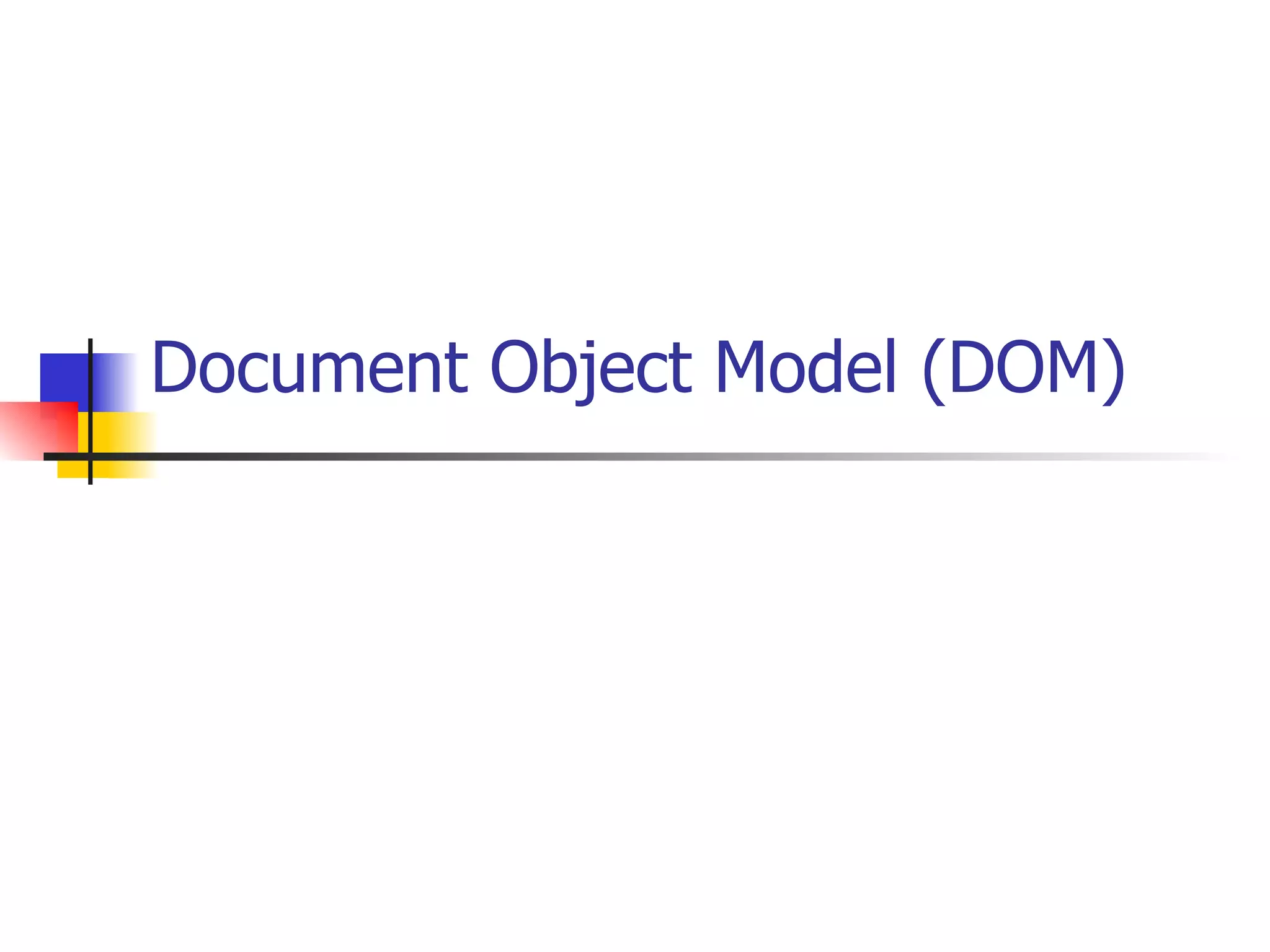
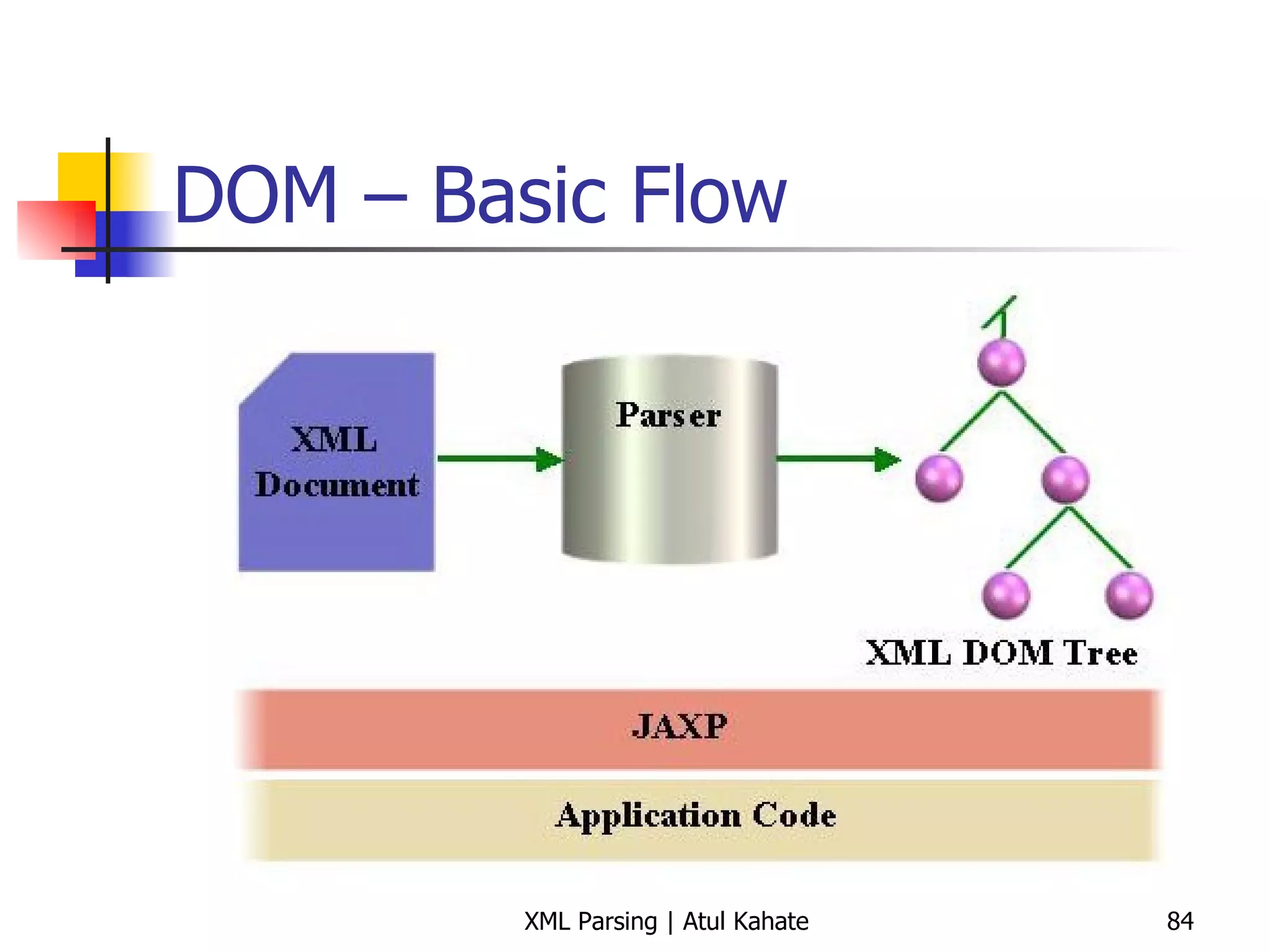
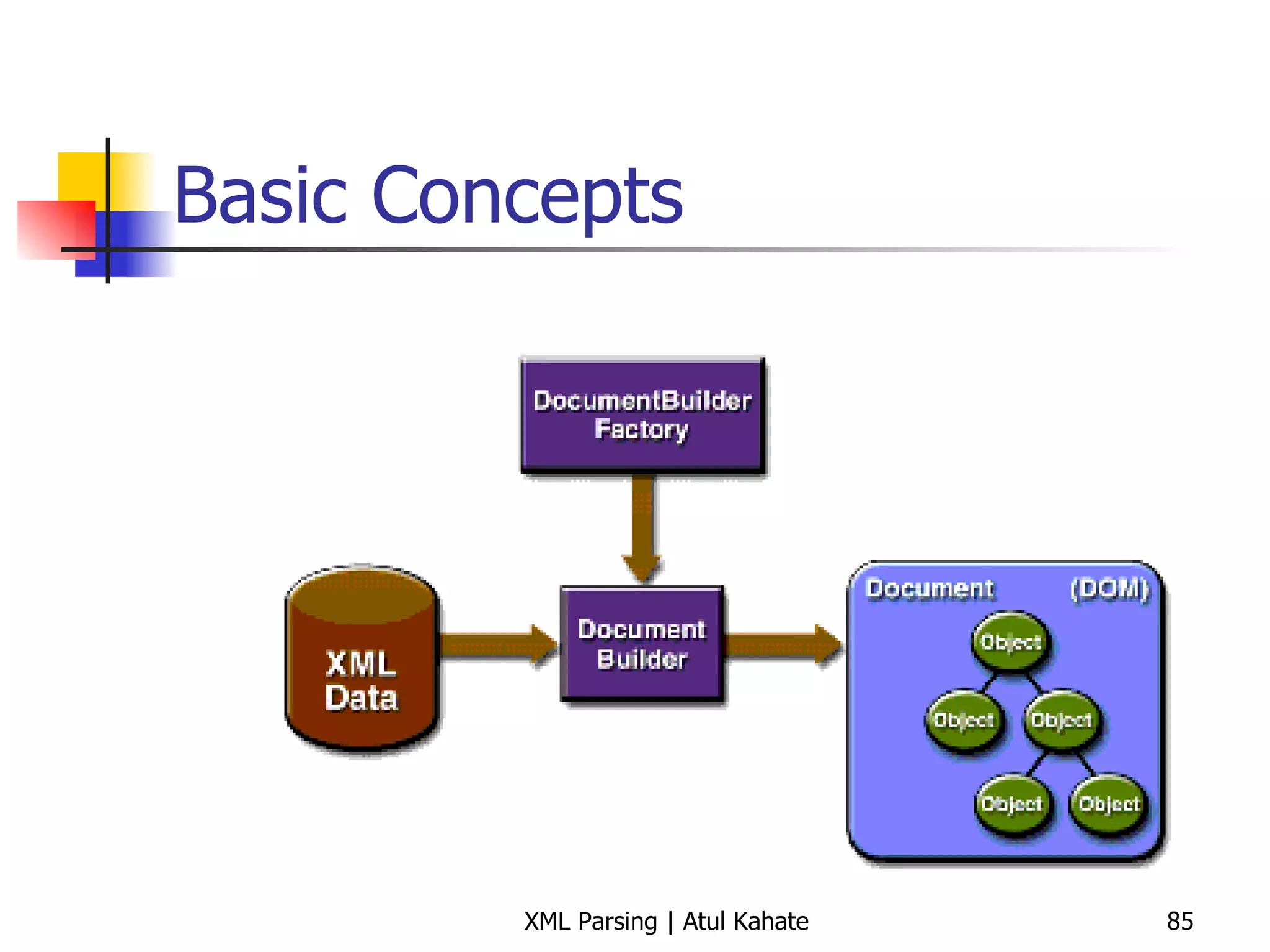
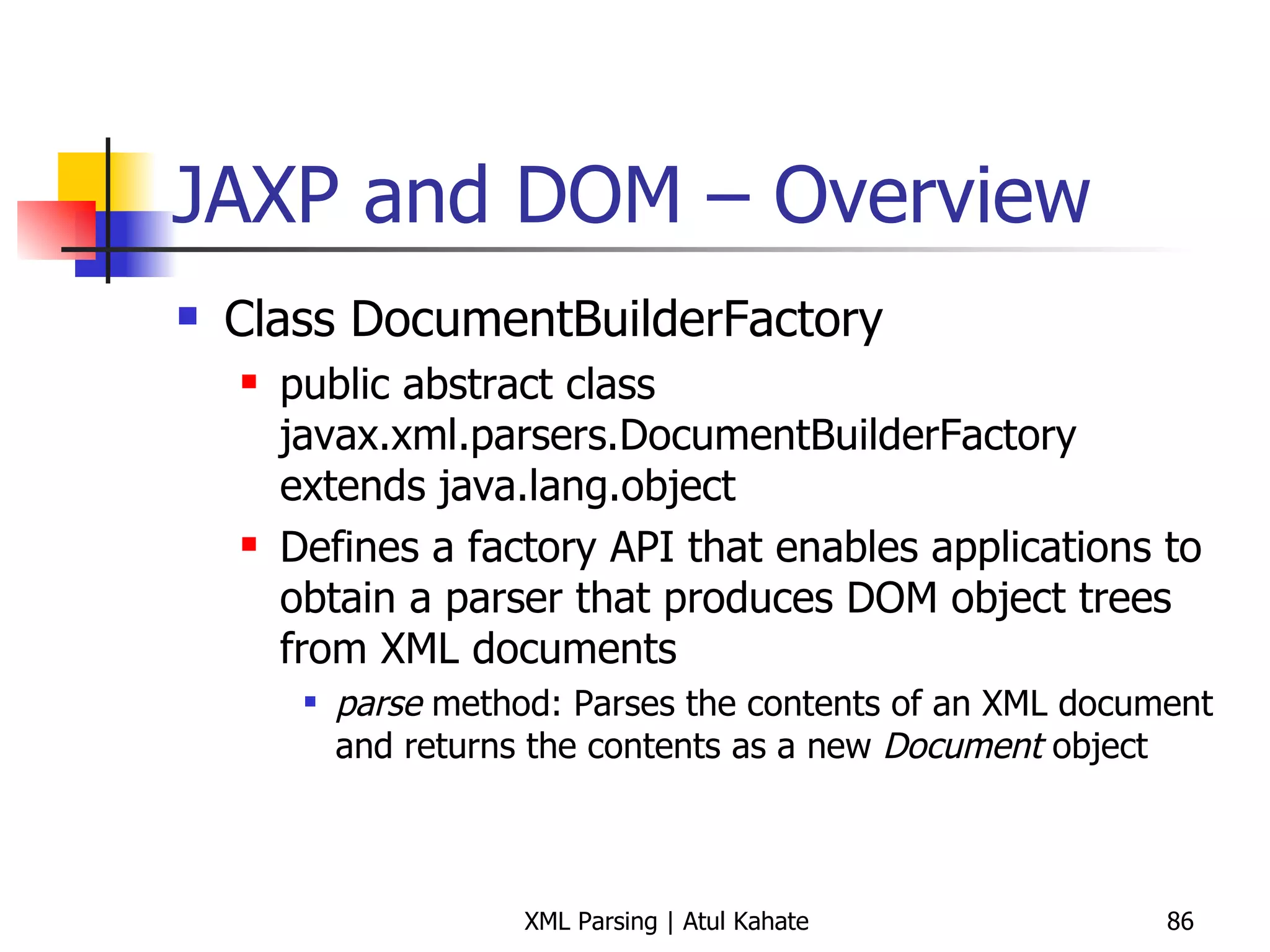
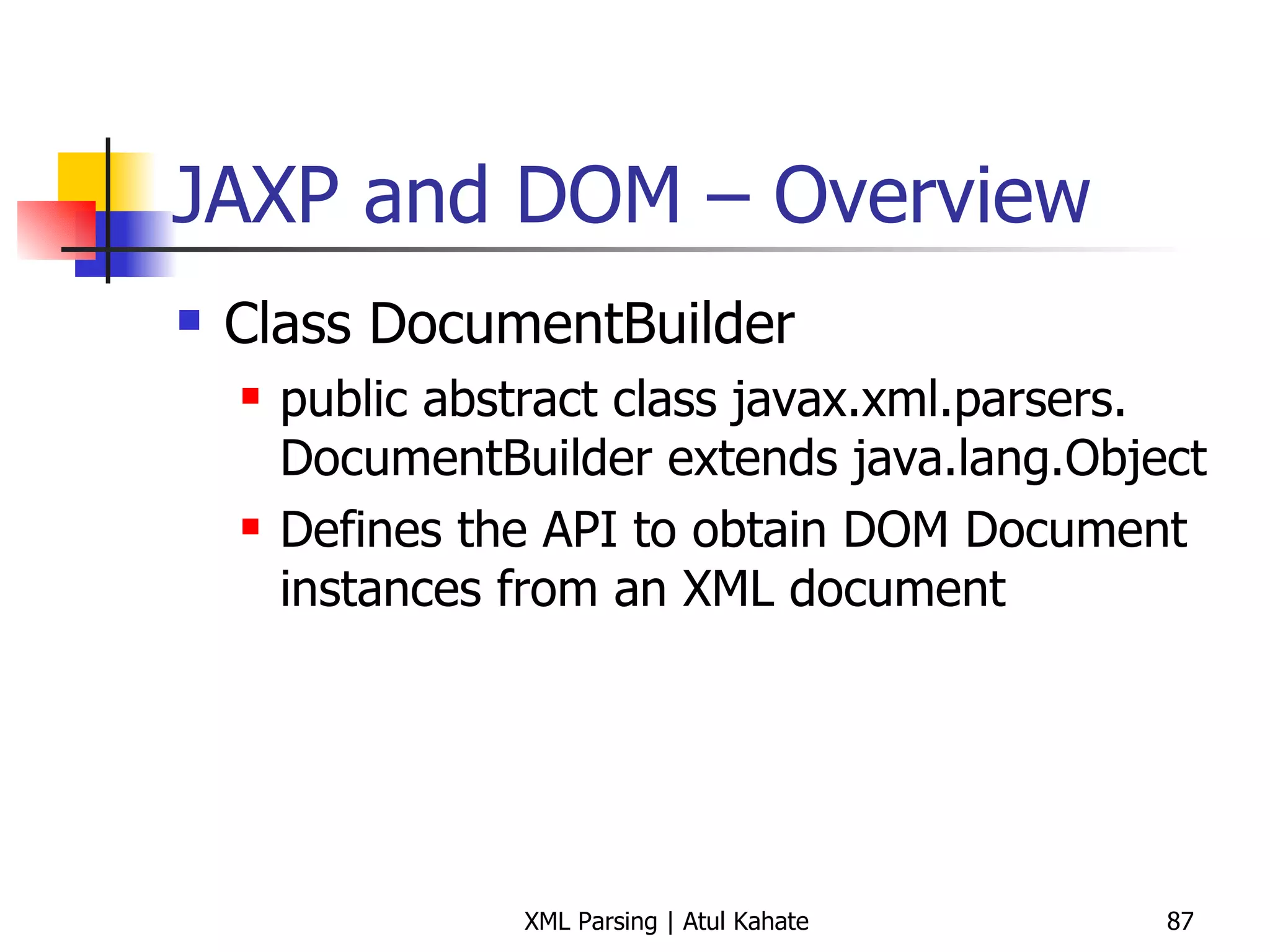
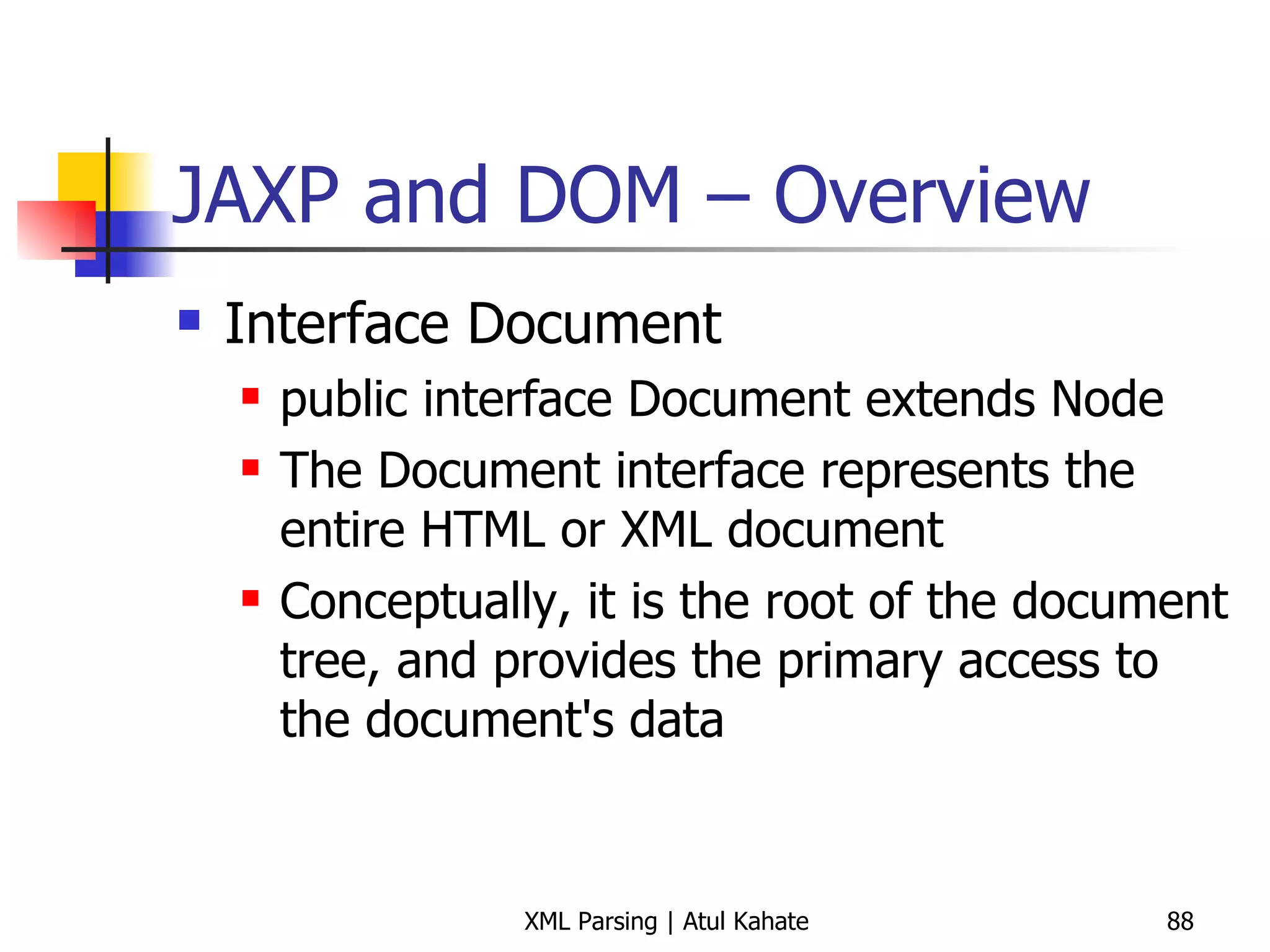
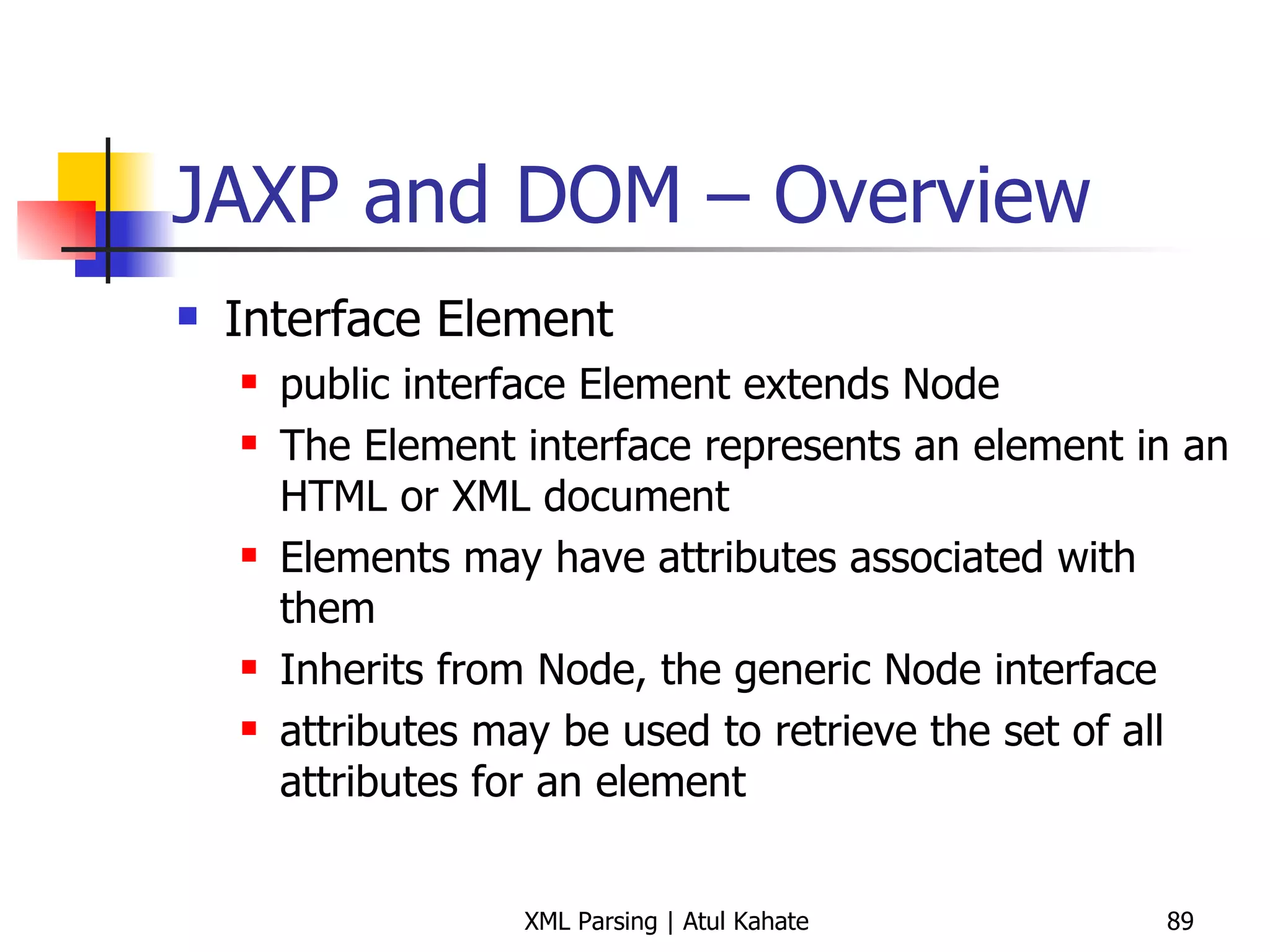
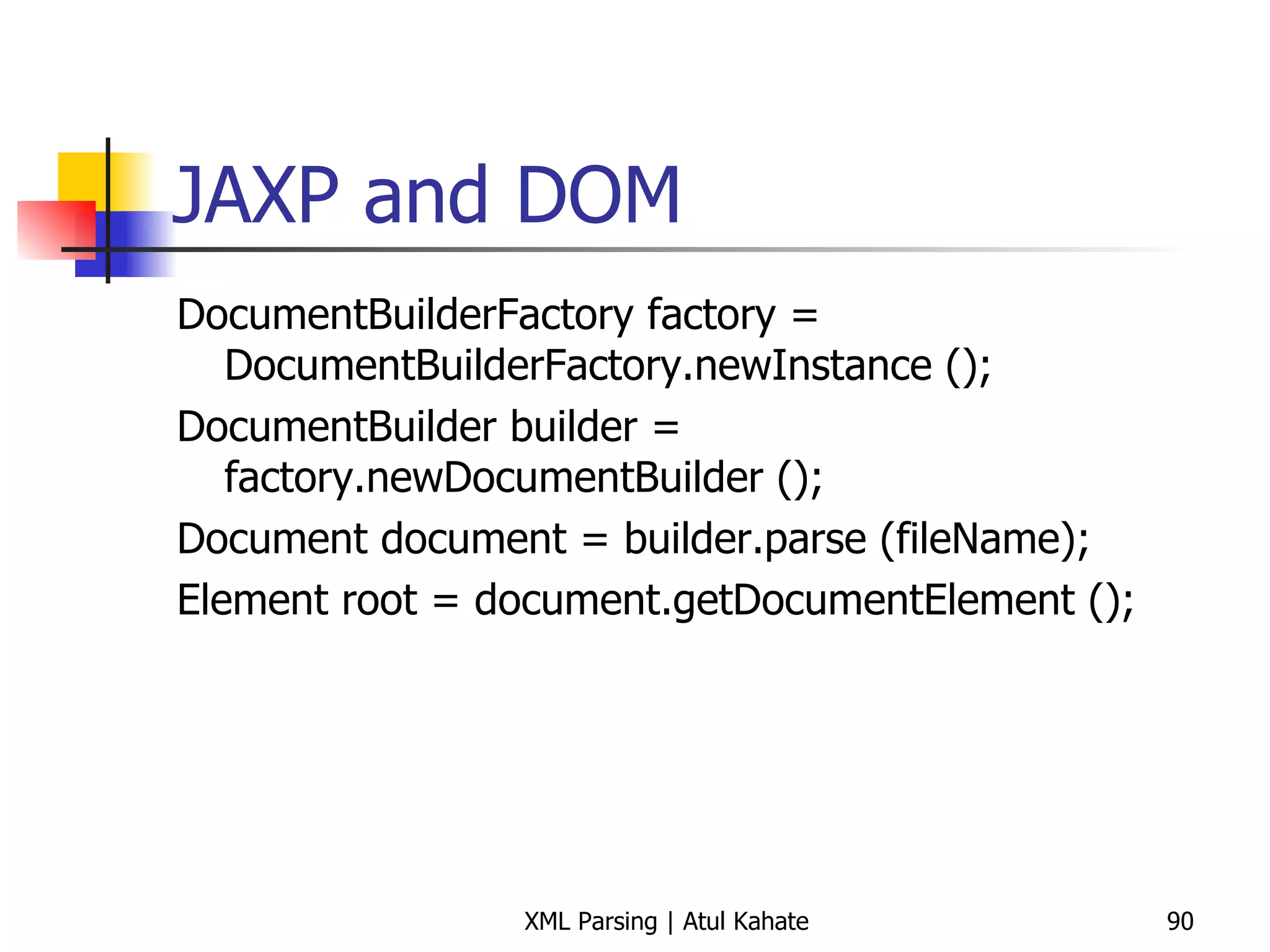
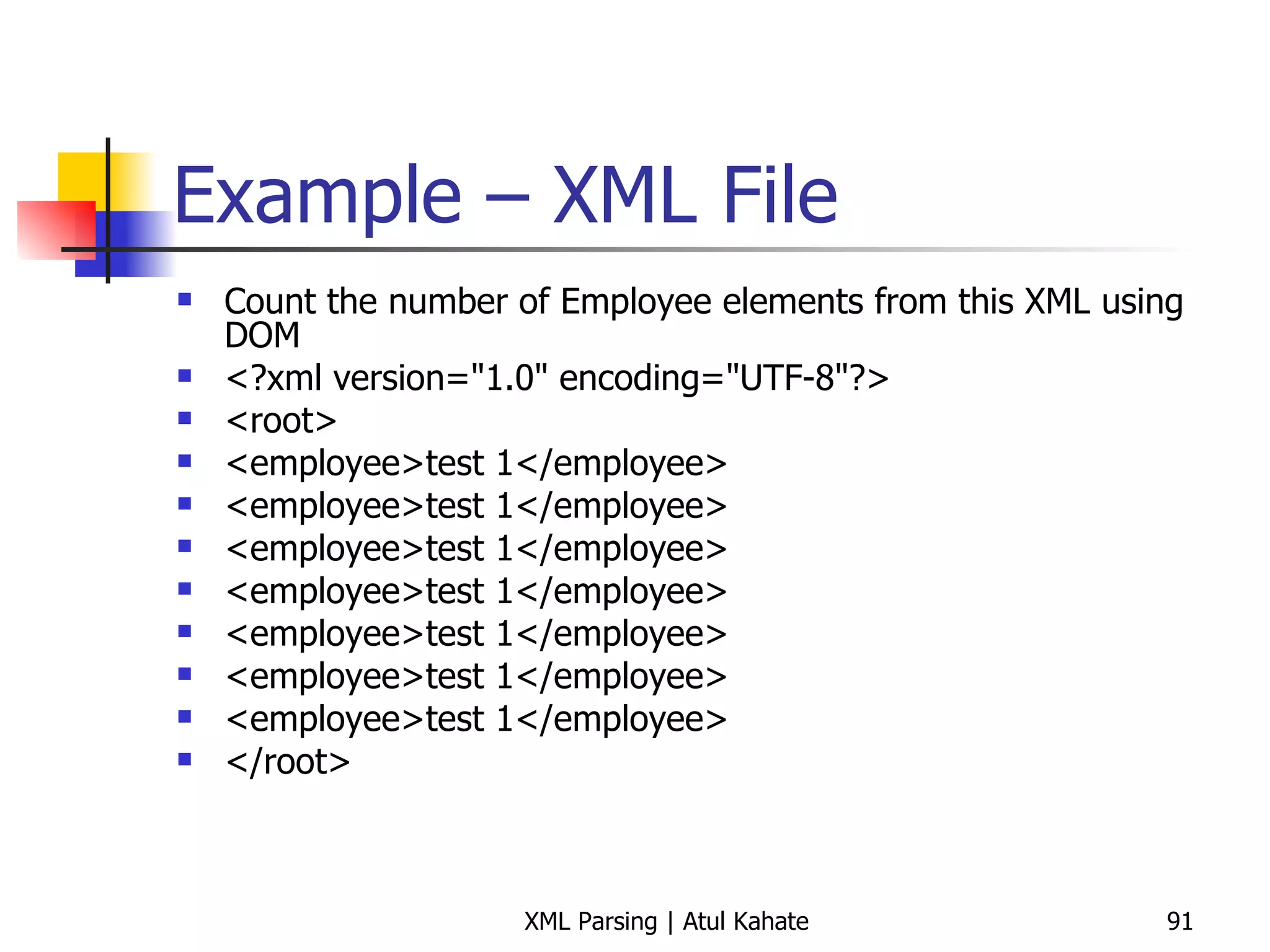
![Example – Java Code package javaapplication1; import org.w3c.dom.*; public class Main { public static void main(String[] args) { try { DocumentBuilderFactory factory = DocumentBuilderFactory.newInstance (); DocumentBuilder builder = factory.newDocumentBuilder (); Document document = builder.parse ("cdcatalog.xml"); Element root = document.getDocumentElement (); NodeList nodes = document.getElementsByTagName("employee"); System.out.println("There are " + nodes.getLength() + " elements."); } catch (Exception ex) { System.out.println(ex); } } }](https://image.slidesharecdn.com/6-xmlparsing-111212100111-phpapp02/75/6-xml-parsing-92-2048.jpg)
![Check if a File is Well-Formed package sicsr; import javax.xml.parsers.*; public class IsWellFormed { /** * @param args */ public static void main(String[] args) { try { DocumentBuilderFactory domFactory = DocumentBuilderFactory. newInstance (); DocumentBuilder domBuilder = domFactory.newDocumentBuilder(); domBuilder.parse( "NWF.xml" ); } catch (org.xml.sax.SAXException ex) { System. out .println( "File is not well-formed" ); } catch (FactoryConfigurationError ex) { System. out .println(ex.toString ()); } catch (ParserConfigurationException ex) { System. out .println(ex.toString ()); } catch (Exception ex) { System. out .println(ex.toString ()); } } }](https://image.slidesharecdn.com/6-xmlparsing-111212100111-phpapp02/75/6-xml-parsing-93-2048.jpg)
![JAXP Code to Open an XML File import org.w3c.dom.*; import javax.xml.parsers.*; import org.xml.sax.*; public class DOMExample1 { public static void main (String[] args) { try { DocumentBuilderFactory factory = DocumentBuilderFactory.newInstance (); DocumentBuilder builder = factory.newDocumentBuilder (); Document document = builder.parse ("cdcatalog.xml"); Element root = document.getDocumentElement (); System.out.println ("In main ... XML file openend successfully ..."); } catch (ParserConfigurationException e1) { System.out.println ("Exception: " + e1); } catch (SAXException e2) { System.out.println ("Exception: " + e2); } catch (java.io.IOException e3) { System.out.println ("Exception: " + e3); } } }](https://image.slidesharecdn.com/6-xmlparsing-111212100111-phpapp02/75/6-xml-parsing-94-2048.jpg)
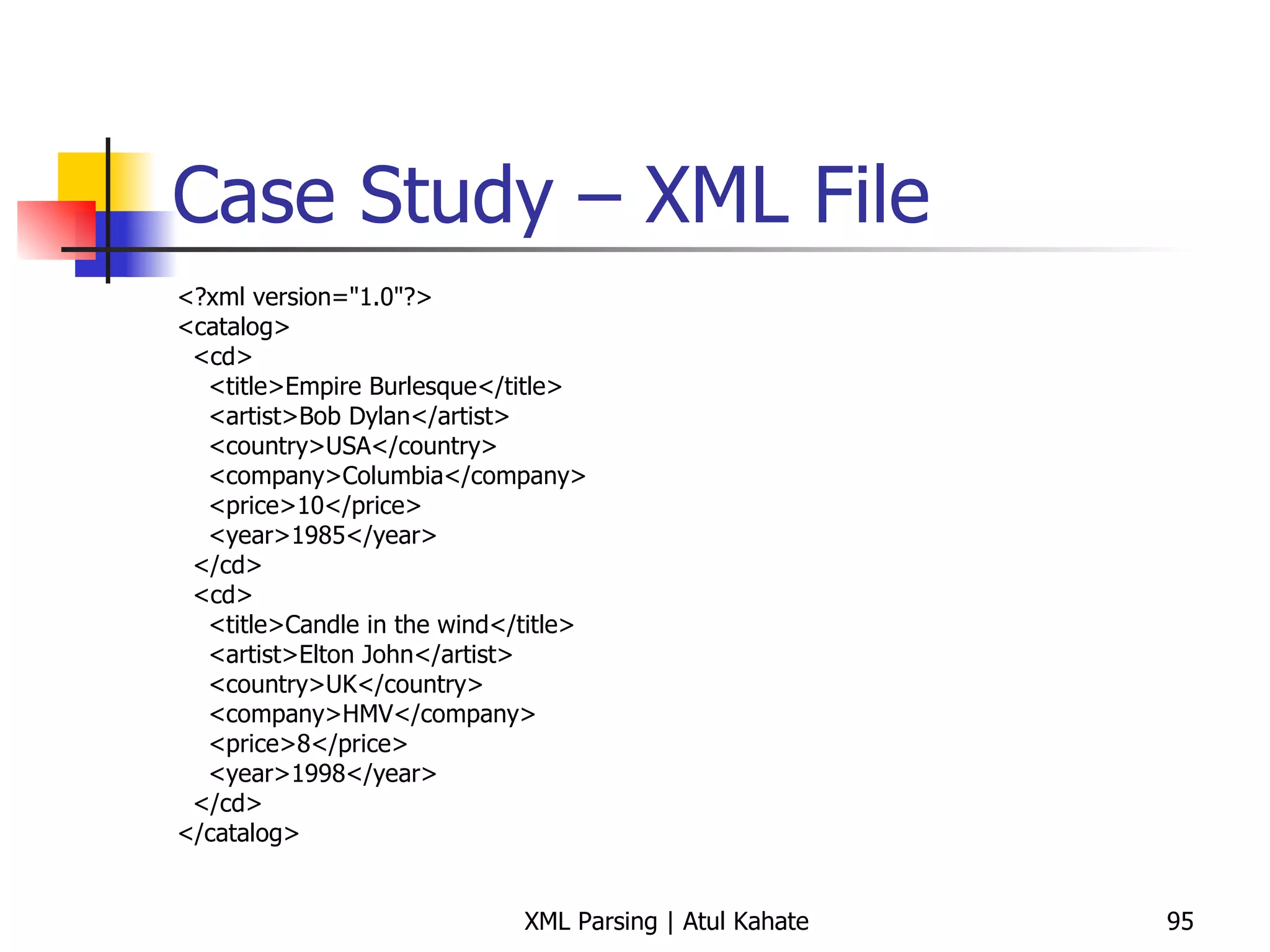
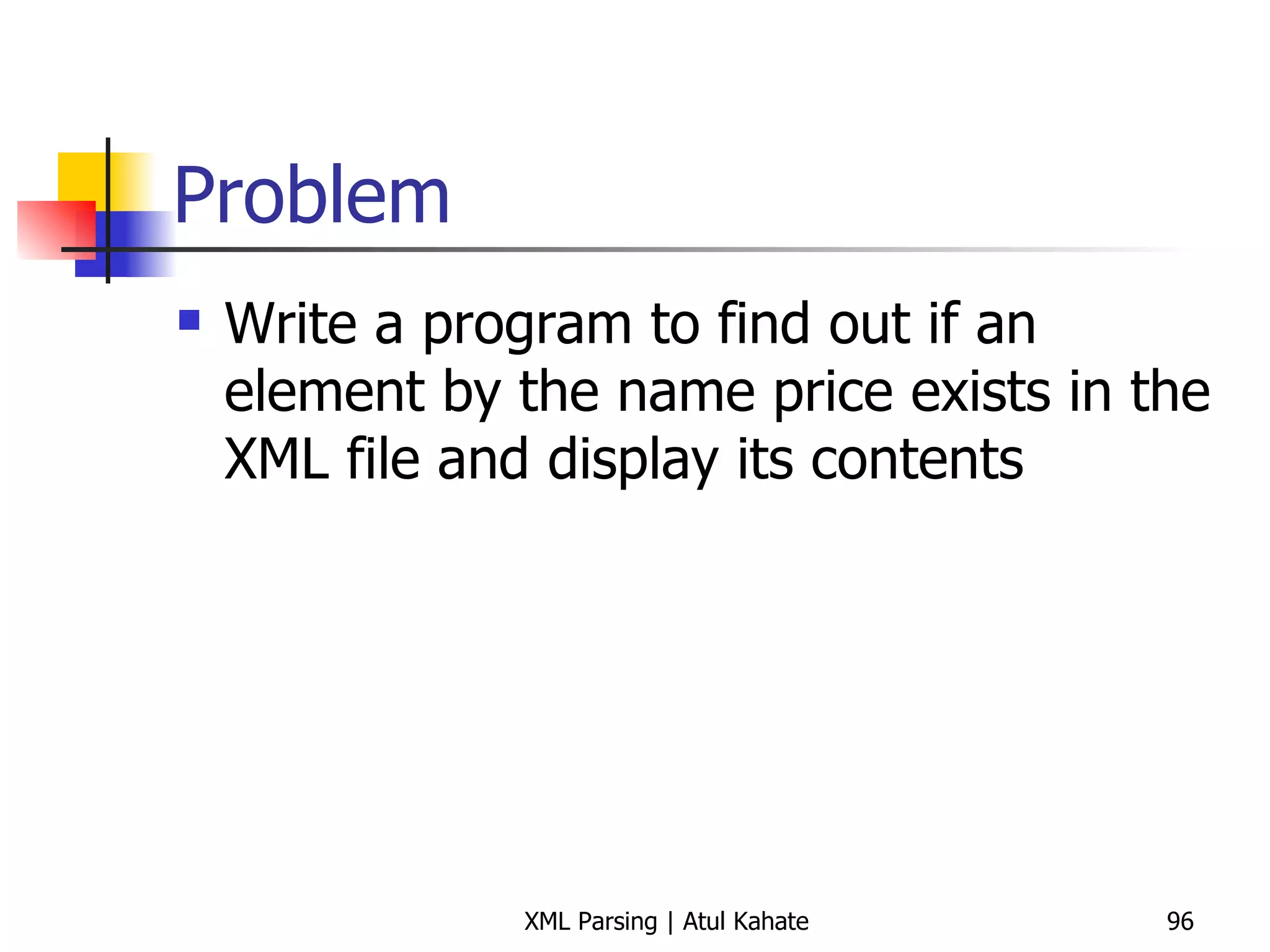
![Solution import org.w3c.dom.*; import javax.xml.parsers.*; import org.xml.sax.*; public class DOMExample2 { public static void main (String[] args) { NodeList elements; String elementName = "price"; try { DocumentBuilderFactory factory = DocumentBuilderFactory.newInstance (); DocumentBuilder builder = factory.newDocumentBuilder (); Document document = builder.parse ("cdcatalog.xml"); Element root = document.getDocumentElement (); System.out.println ("In main ... XML file openend successfully ..."); elements = document.getElementsByTagName(elementName); // is there anything to do? if (elements == null) { return; } // print all elements int elementCount = elements.getLength(); System.out.println ("Count = " + elementCount); for (int i = 0; i < elementCount; i++) { Element element = (Element) elements.item(i); System.out.println ("Element Name = " + element.getNodeName()); System.out.println ("Element Type = " + element.getNodeType()); System.out.println ("Element Value = " + element.getNodeValue()); System.out.println ("Has attributes = " + element.hasAttributes()); } } catch (ParserConfigurationException e1) { System.out.println ("Exception: " + e1); } catch (SAXException e2) { System.out.println ("Exception: " + e2); } catch (DOMException e2) { System.out.println ("Exception: " + e2); } catch (java.io.IOException e3) { System.out.println ("Exception: " + e3); } } }](https://image.slidesharecdn.com/6-xmlparsing-111212100111-phpapp02/75/6-xml-parsing-97-2048.jpg)
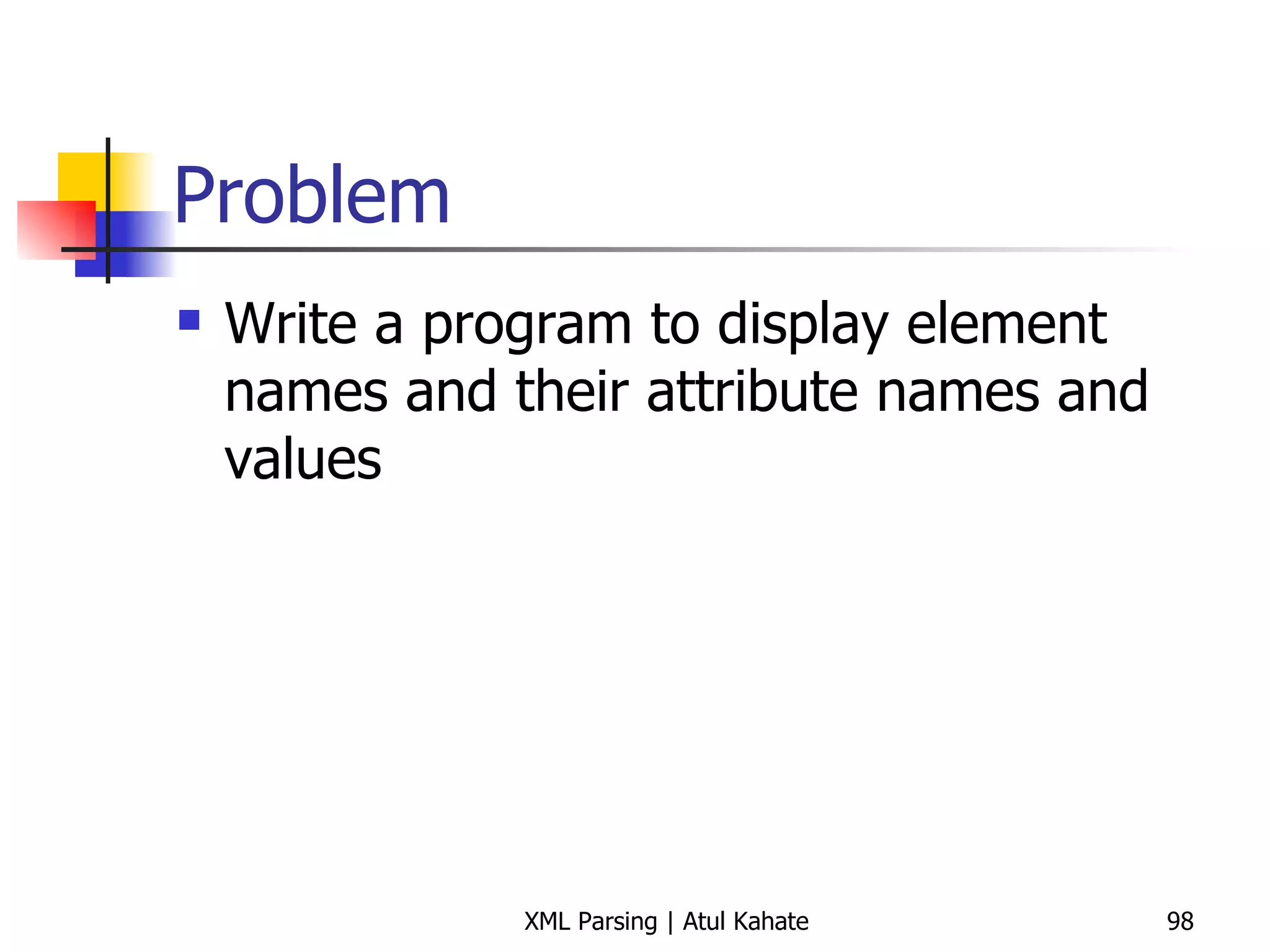
![Solution import org.w3c.dom.*; import javax.xml.parsers.*; import org.xml.sax.*; public class DOMExample3 { public static void main (String[] args) { NodeList elements; String elementName = "cd"; try { DocumentBuilderFactory factory = DocumentBuilderFactory.newInstance (); DocumentBuilder builder = factory.newDocumentBuilder (); Document document = builder.parse ("cdcatalog.xml"); Element root = document.getDocumentElement (); System.out.println ("In main ... XML file openend successfully ..."); elements = document.getElementsByTagName(elementName); // is there anything to do? if (elements == null) { return; } // print all elements int elementCount = elements.getLength(); System.out.println ("Count = " + elementCount); for (int i = 0; i < elementCount; i++) { Element element = (Element) elements.item(i); System.out.println ("Element Name = " + element.getNodeName()); System.out.println ("Element Type = " + element.getNodeType()); System.out.println ("Element Value = " + element.getNodeValue()); System.out.println ("Has attributes = " + element.hasAttributes()); // If attributes exist, print them if(element.hasAttributes()) { // if it does, store it in a NamedNodeMap object NamedNodeMap AttributesList = element.getAttributes(); // iterate through the NamedNodeMap and get the attribute names and values for(int j = 0; j < AttributesList.getLength(); j++) { System.out.println("Attribute: " + AttributesList.item(j).getNodeName() + " = " + AttributesList.item(j).getNodeValue()); } } } } catch (ParserConfigurationException e1) { System.out.println ("Exception: " + e1); } catch (SAXException e2) { System.out.println ("Exception: " + e2); } catch (DOMException e2) { System.out.println ("Exception: " + e2); } catch (java.io.IOException e3) { System.out.println ("Exception: " + e3); } } }](https://image.slidesharecdn.com/6-xmlparsing-111212100111-phpapp02/75/6-xml-parsing-99-2048.jpg)
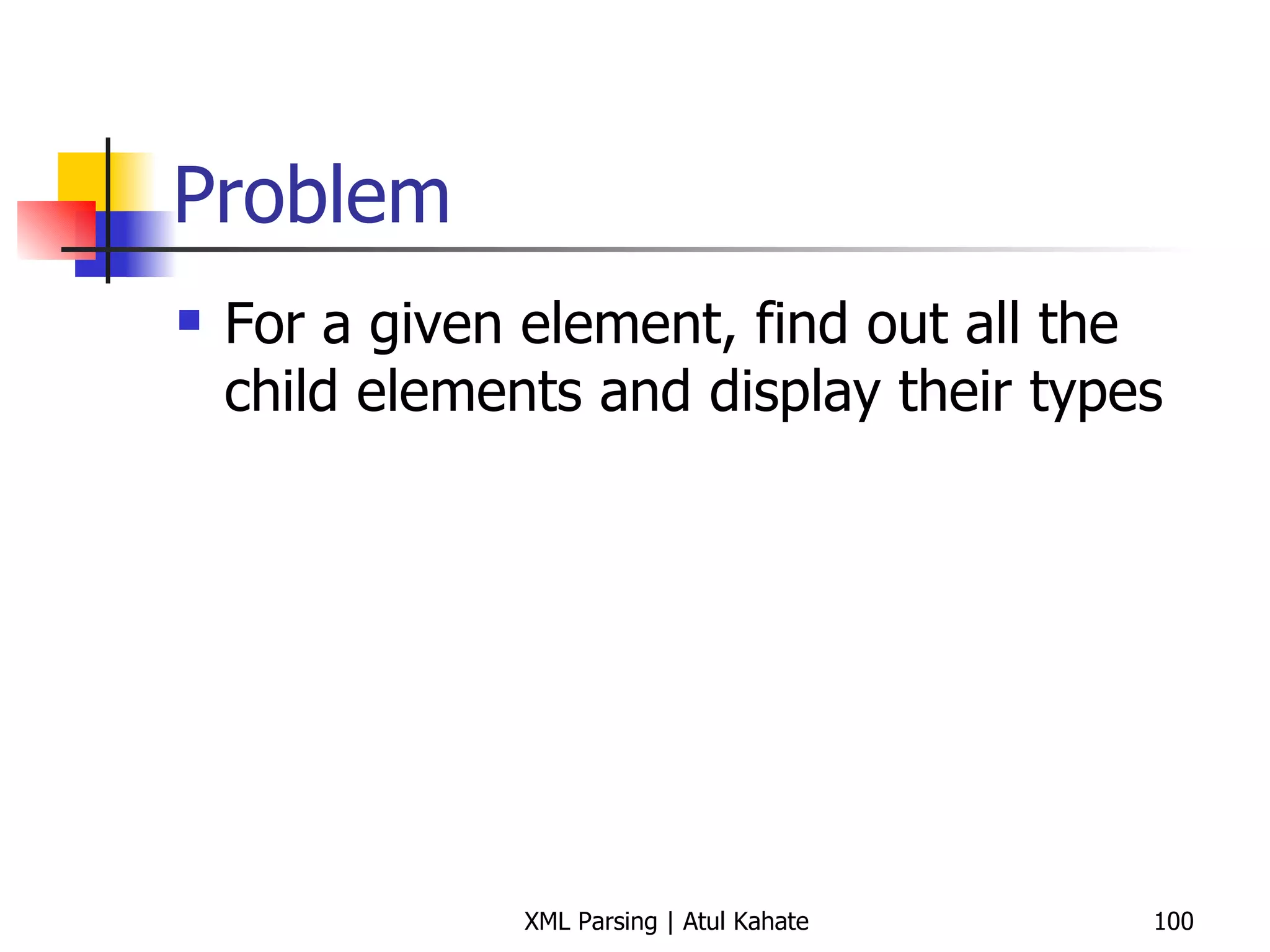
![Solution import org.w3c.dom.*; import javax.xml.parsers.*; import org.xml.sax.*; public class DOMExample4 { public static void main (String[] args) { NodeList elements, Children; String elementName = "cd"; String local = ""; Element element = null; try { DocumentBuilderFactory factory = DocumentBuilderFactory.newInstance (); DocumentBuilder builder = factory.newDocumentBuilder (); Document document = builder.parse ("cdcatalog.xml"); Element root = document.getDocumentElement (); System.out.println ("In main ... XML file openend successfully ..."); elements = document.getElementsByTagName(elementName); // is there anything to do? if (elements == null) { return; } // print all elements int elementCount = elements.getLength(); System.out.println ("Count = " + elementCount); for (int i = 0; i < elementCount; i++) { element = (Element) elements.item(i); System.out.println ("Element Name = " + element.getNodeName()); System.out.println ("Element Type = " + element.getNodeType()); System.out.println ("Element Value = " + element.getNodeValue()); System.out.println ("Has attributes = " + element.hasAttributes()); // Find out if child nodes exist for this element Children = element.getChildNodes(); if (Children != null) { for (int j=0; j< Children.getLength(); j++) { local = Children.item(j).getNodeName(); System.out.println ("Child element name = " + local); } } } } catch (ParserConfigurationException e1) { System.out.println ("Exception: " + e1); } catch (SAXException e2) { System.out.println ("Exception: " + e2); } catch (DOMException e2) { System.out.println ("Exception: " + e2); } catch (java.io.IOException e3) { System.out.println ("Exception: " + e3); } } }](https://image.slidesharecdn.com/6-xmlparsing-111212100111-phpapp02/75/6-xml-parsing-101-2048.jpg)
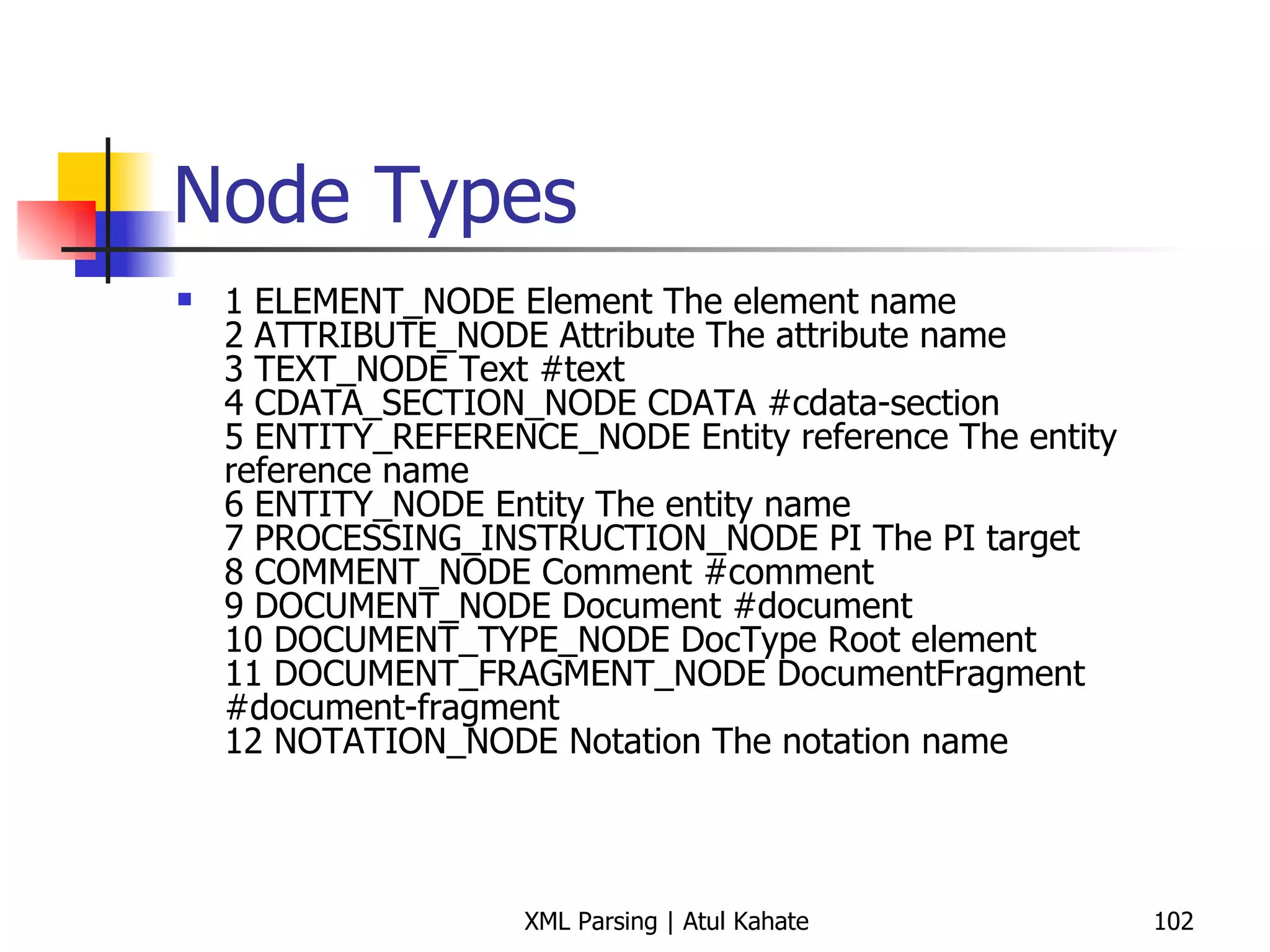
![Making Use of Node Types import org.w3c.dom.*; import javax.xml.parsers.*; import org.xml.sax.*; public class DOMExample4 { public static void main (String[] args) { NodeList elements, Children; String elementName = "cd"; String local = ""; Element element = null; try { DocumentBuilderFactory factory = DocumentBuilderFactory.newInstance (); DocumentBuilder builder = factory.newDocumentBuilder (); Document document = builder.parse ("cdcatalog.xml"); Element root = document.getDocumentElement (); System.out.println ("In main ... XML file openend successfully ..."); elements = document.getElementsByTagName(elementName); // is there anything to do? if (elements == null) { return; } // print all elements int elementCount = elements.getLength(); System.out.println ("Count = " + elementCount); for (int i = 0; i < elementCount; i++) { element = (Element) elements.item(i); System.out.println ("Element Name = " + element.getNodeName()); System.out.println ("Element Type = " + element.getNodeType()); System.out.println ("Element Value = " + element.getNodeValue()); System.out.println ("Has attributes = " + element.hasAttributes()); // Find out if child nodes exist for this element Children = element.getChildNodes(); if (Children != null) { for (int j=0; j< Children.getLength(); j++) { local = Children.item(j).getNodeName(); System.out.println ("Child element name = " + local); } } } } catch (ParserConfigurationException e1) { System.out.println ("Exception: " + e1); } catch (SAXException e2) { System.out.println ("Exception: " + e2); } catch (DOMException e2) { System.out.println ("Exception: " + e2); } catch (java.io.IOException e3) { System.out.println ("Exception: " + e3); } } }](https://image.slidesharecdn.com/6-xmlparsing-111212100111-phpapp02/75/6-xml-parsing-103-2048.jpg)
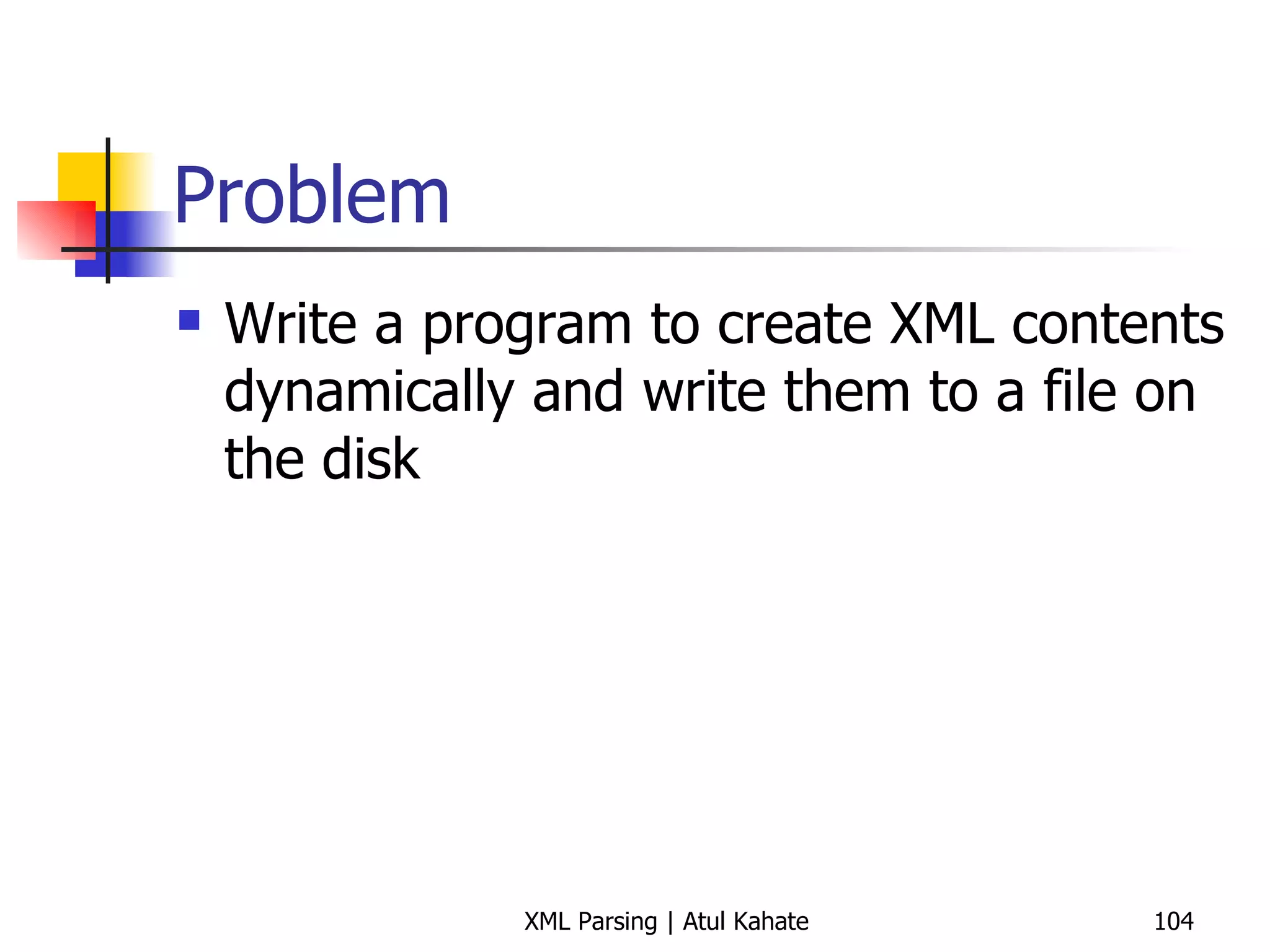
![Solution import java.io.File; import java.io.IOException; import java.io.OutputStreamWriter; import java.io.Writer; import org.w3c.dom.*; import javax.xml.parsers.*; import org.xml.sax.*; import javax.xml.transform.TransformerConfigurationException; import javax.xml.transform.TransformerException; import javax.xml.transform.Source; import javax.xml.transform.dom.DOMSource; import javax.xml.transform.Result; import javax.xml.transform.stream.StreamResult; import javax.xml.transform.Transformer; import javax.xml.transform.TransformerFactory; public class DOMExample5 { public static void main (String[] args) { Source source; File file; Result result; try { DocumentBuilderFactory factory = DocumentBuilderFactory.newInstance (); DocumentBuilder builder = factory.newDocumentBuilder (); // Create a new XML document Document document = builder.newDocument (); Element root = (Element) document.createElement("Order"); // Insert child Manifest document.appendChild(root); Node manifestChild = document.createElement("Manifest"); root.appendChild(manifestChild); // Insert Items CreateOrderDOM co = new CreateOrderDOM (); co.insertItem(document, manifestChild, "101", "Name one", "$29.99"); co.insertItem(document, manifestChild, "108", "Name two", "$19.99"); co.insertItem(document, manifestChild, "125", "Name three", "$39.99"); co.insertItem(document, manifestChild, "143", "Name four", "$59.99"); co.insertItem(document, manifestChild, "118", "Name five", "$99.99"); // Normalizing the DOM document.getDocumentElement().normalize(); // Prepare the DOM document for writing source = new DOMSource(document); // Prepare the output file file = new File("test.xml"); result = new StreamResult(file); // Write the DOM document to the file // Get Transformer Transformer xformer = TransformerFactory.newInstance().newTransformer(); // Write to a file xformer.transform(source, result); } catch ( Exception ex ) { ex.printStackTrace(); } } }](https://image.slidesharecdn.com/6-xmlparsing-111212100111-phpapp02/75/6-xml-parsing-105-2048.jpg)
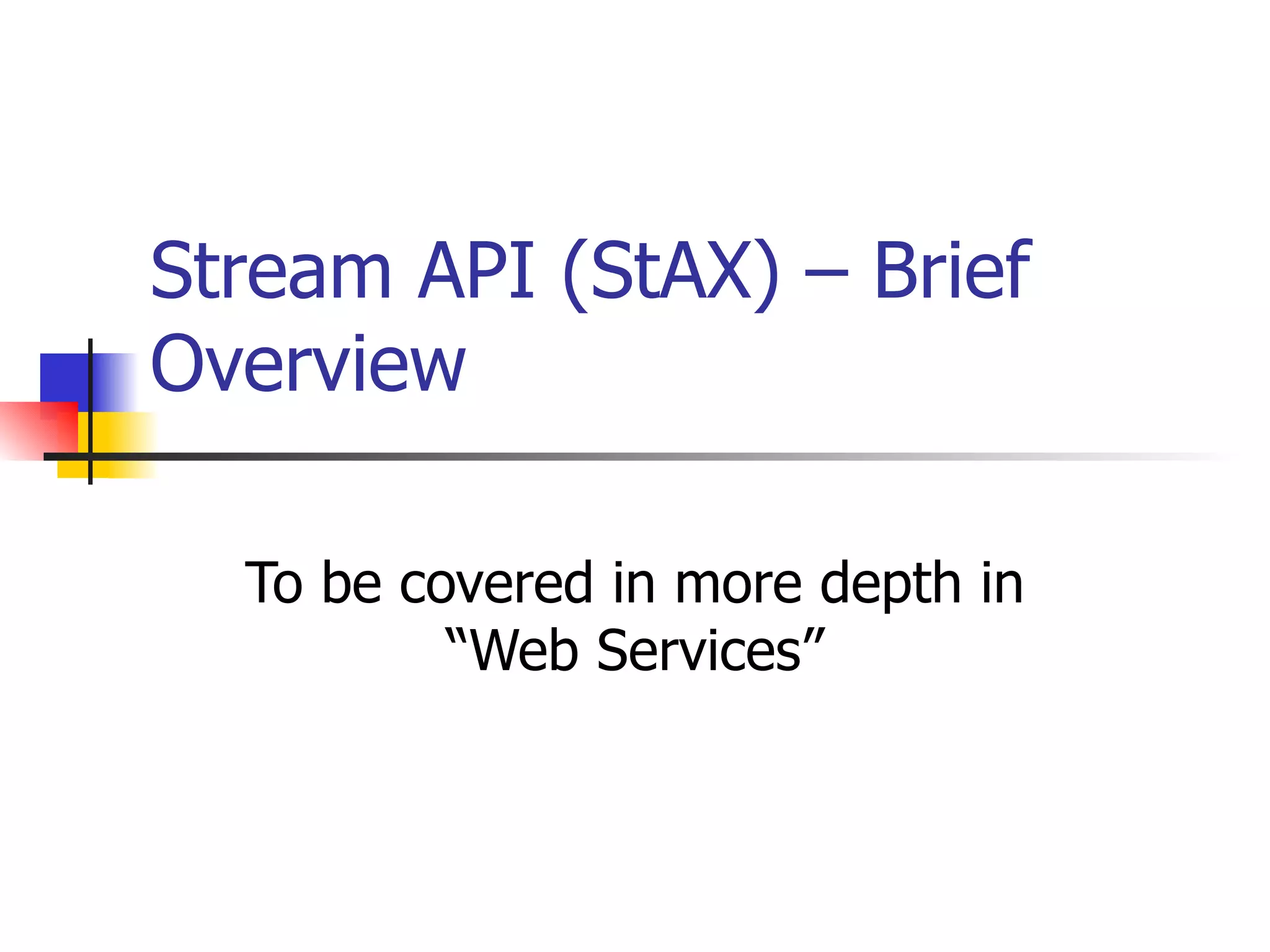
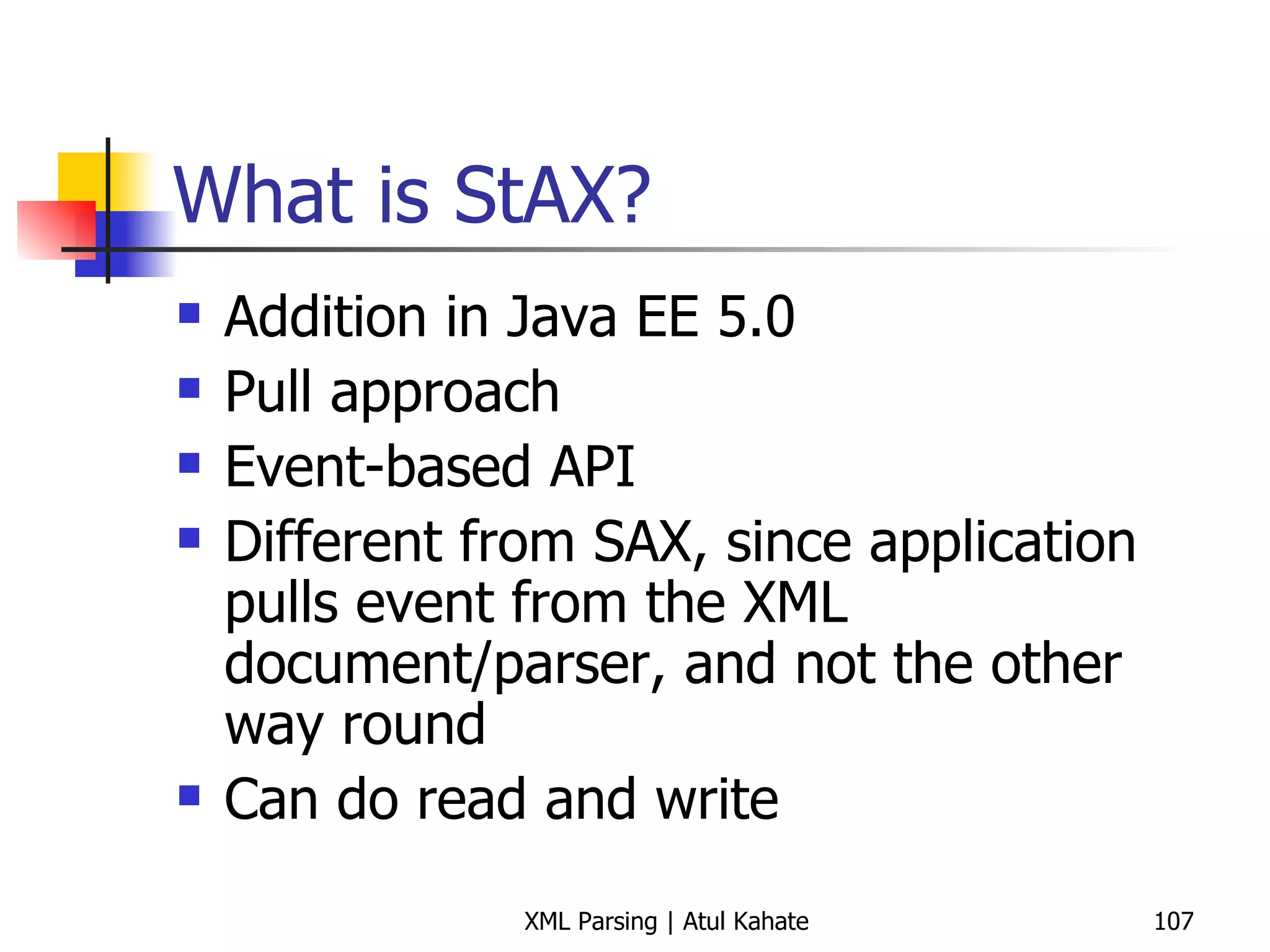
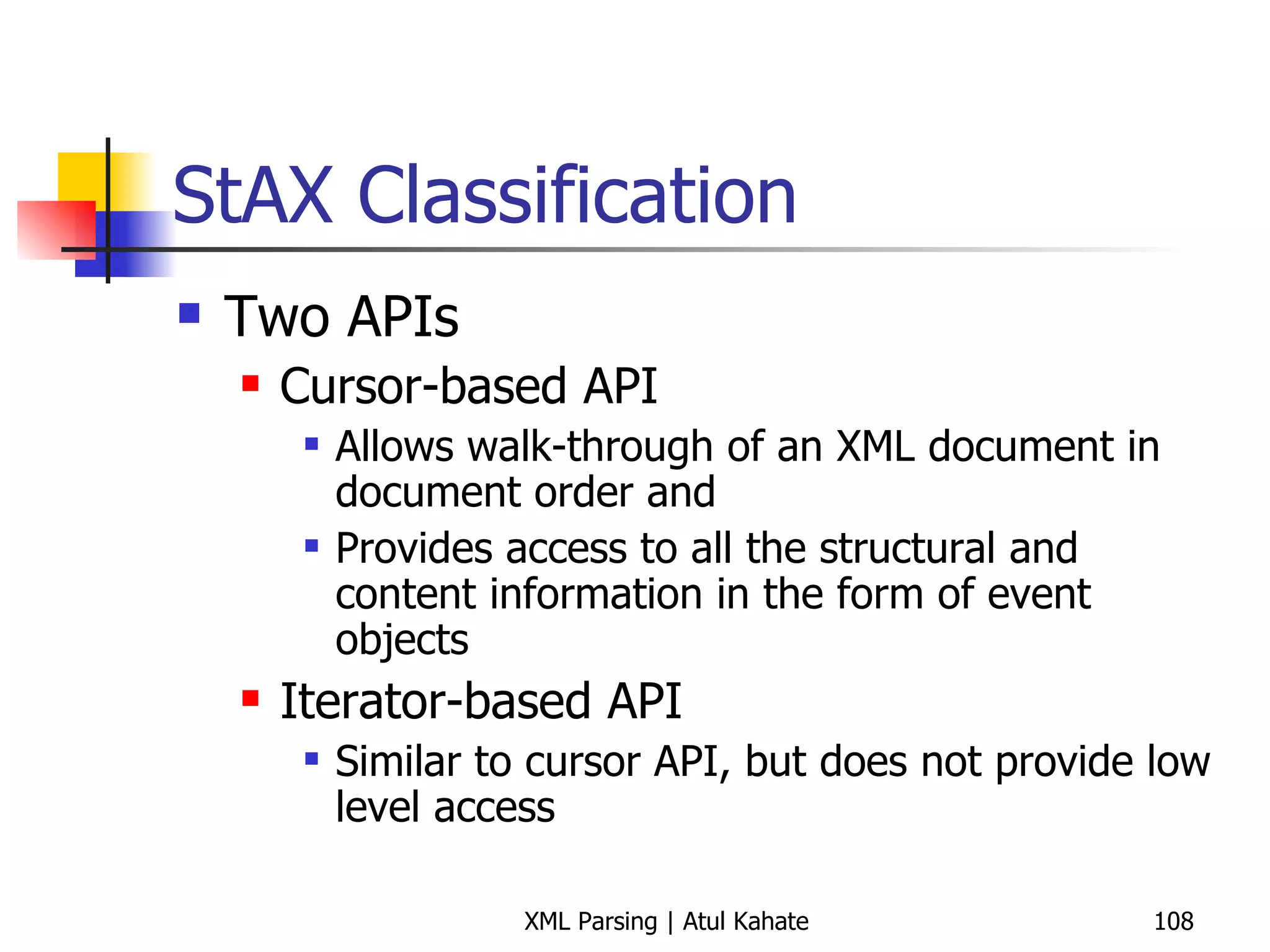
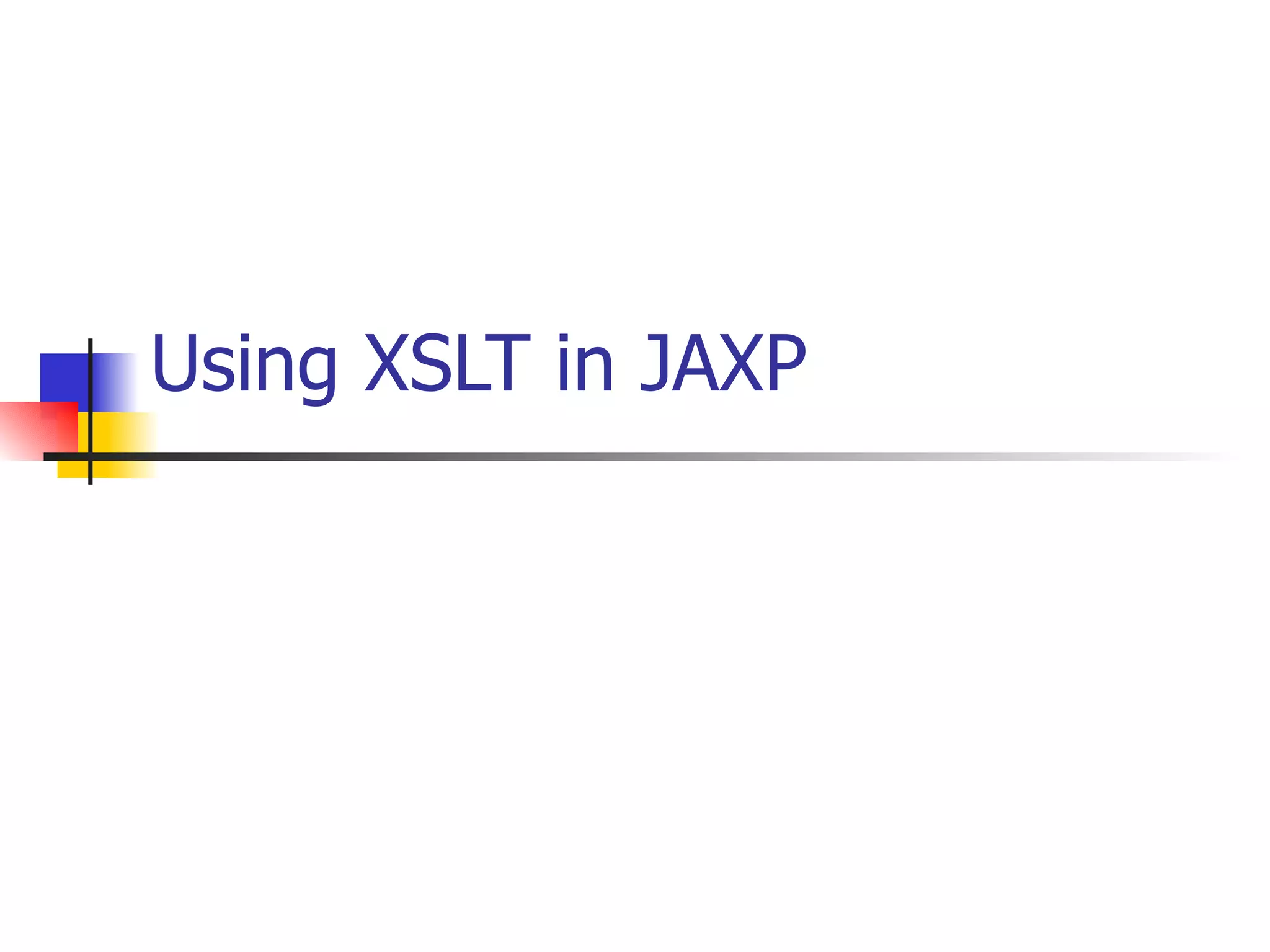
![Applying an XSLT to an XML File Programatically package sicsr; import javax.xml.transform.*; import javax.xml.transform.stream.StreamResult; import javax.xml.transform.stream.StreamSource; import java.io.*; public class ApplyXSLT { public static void main(String[] args) { try { StreamSource xmlFile = new StreamSource ( new File ( "history.xml" )); StreamSource xslFile = new StreamSource ( new File ( "history.xsl" )); TransformerFactory xslFactory = TransformerFactory. newInstance (); Transformer transformer = xslFactory.newTransformer (xslFile); StreamResult resultStream = new StreamResult (System. out ); transformer.transform(xmlFile, resultStream); } catch (Exception ex) { ex.printStackTrace(); } } }](https://image.slidesharecdn.com/6-xmlparsing-111212100111-phpapp02/75/6-xml-parsing-110-2048.jpg)
